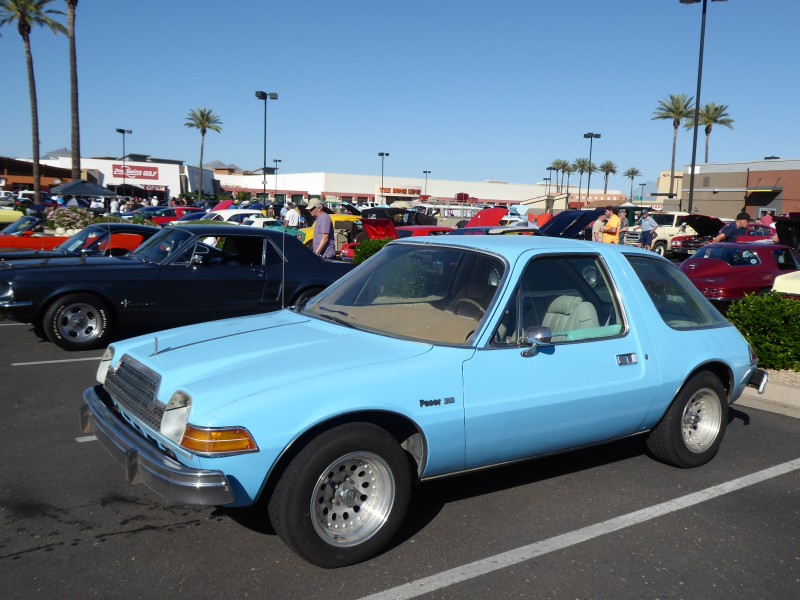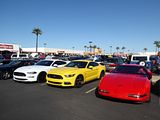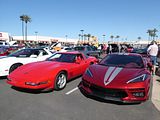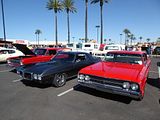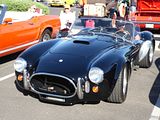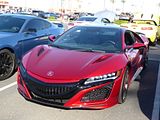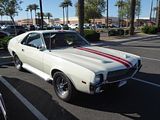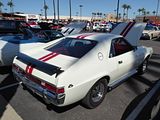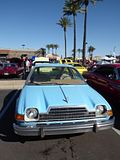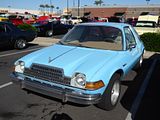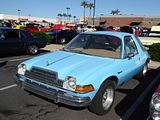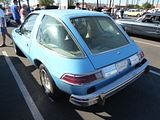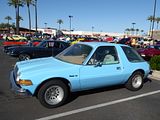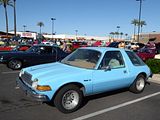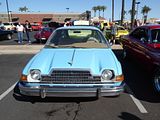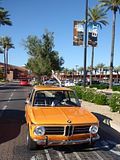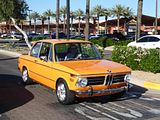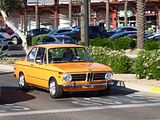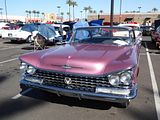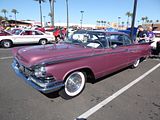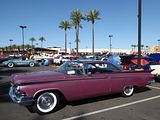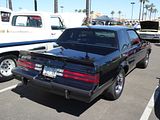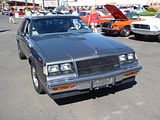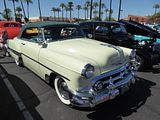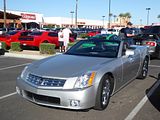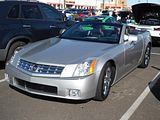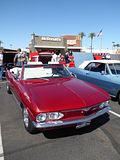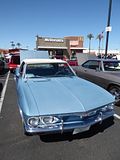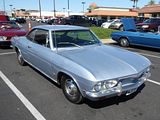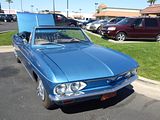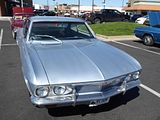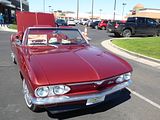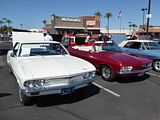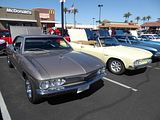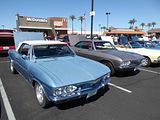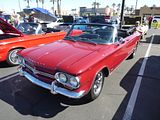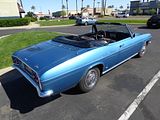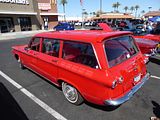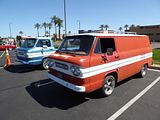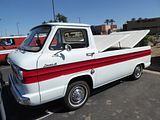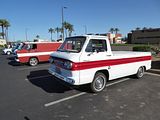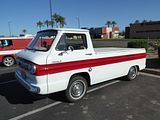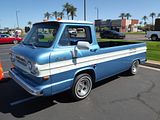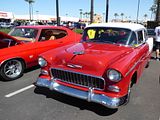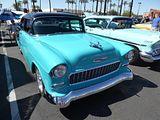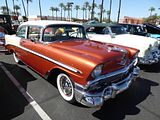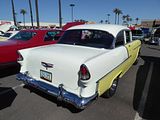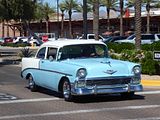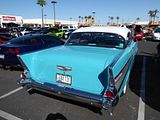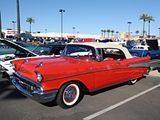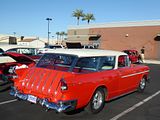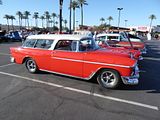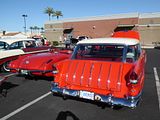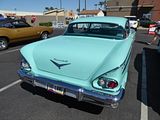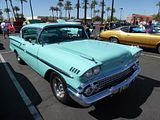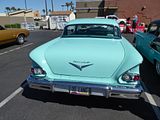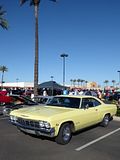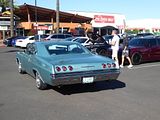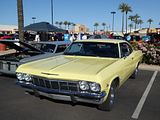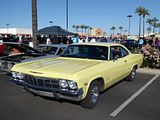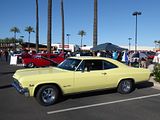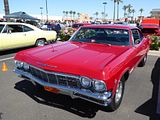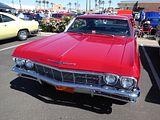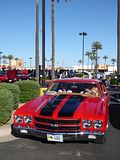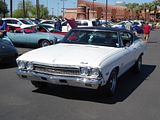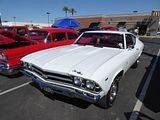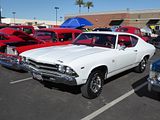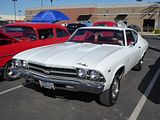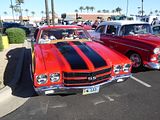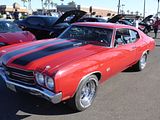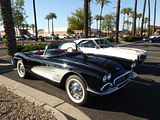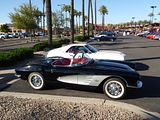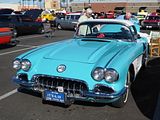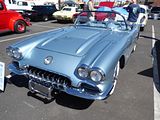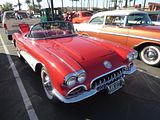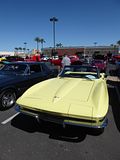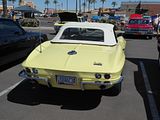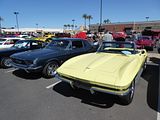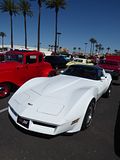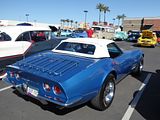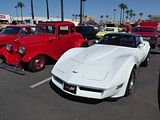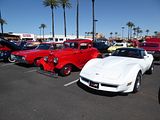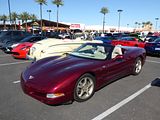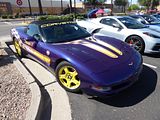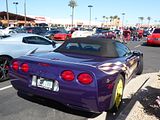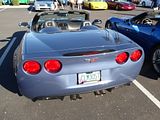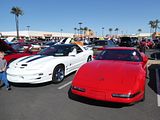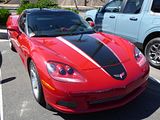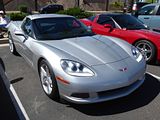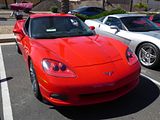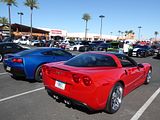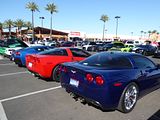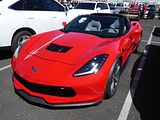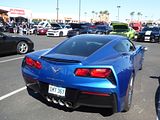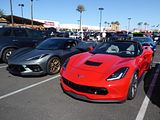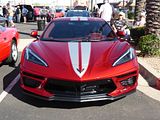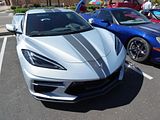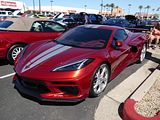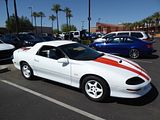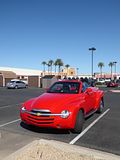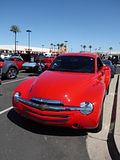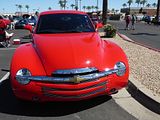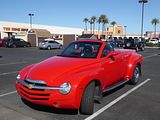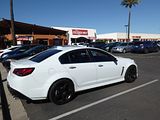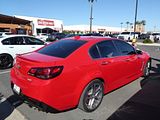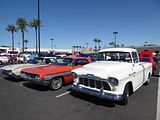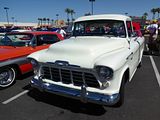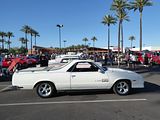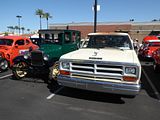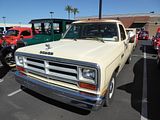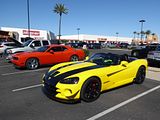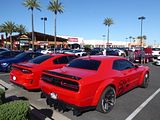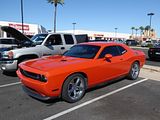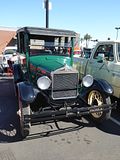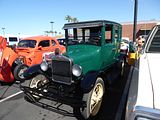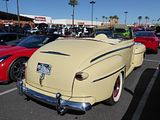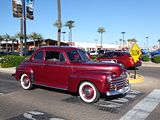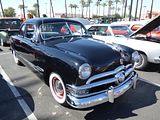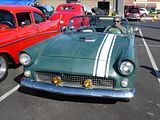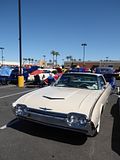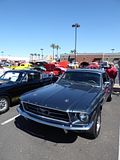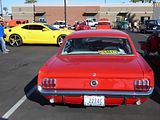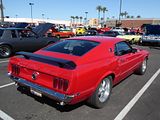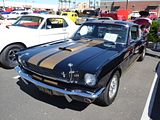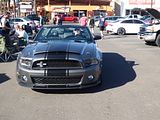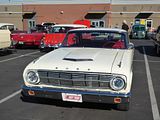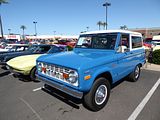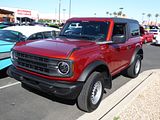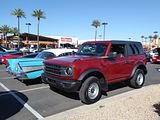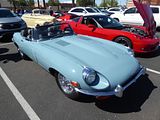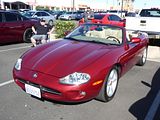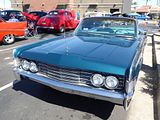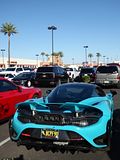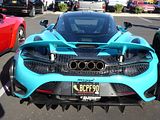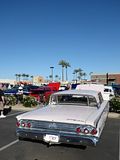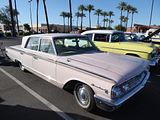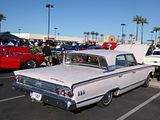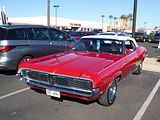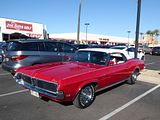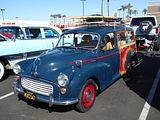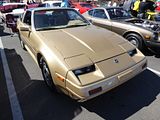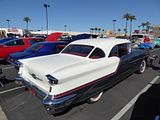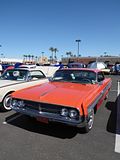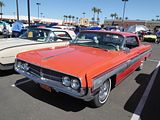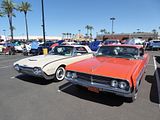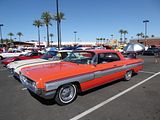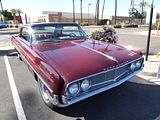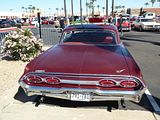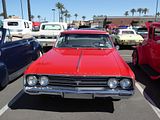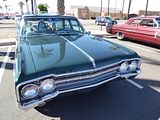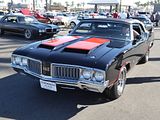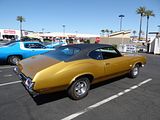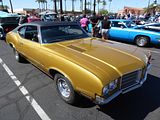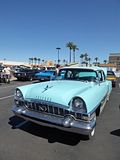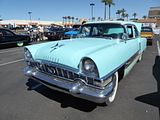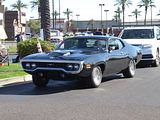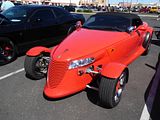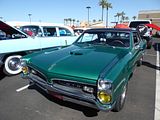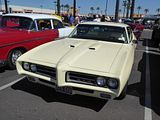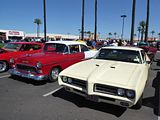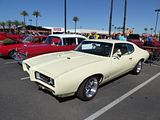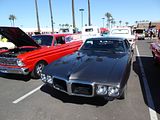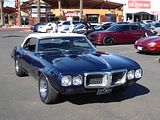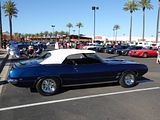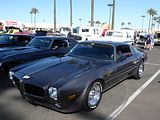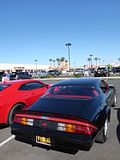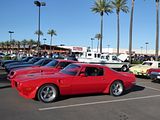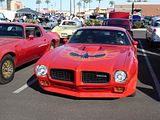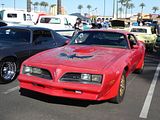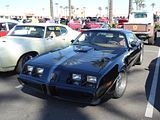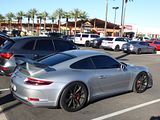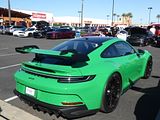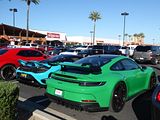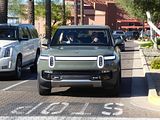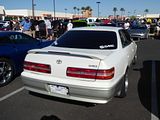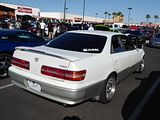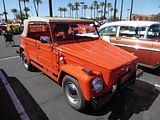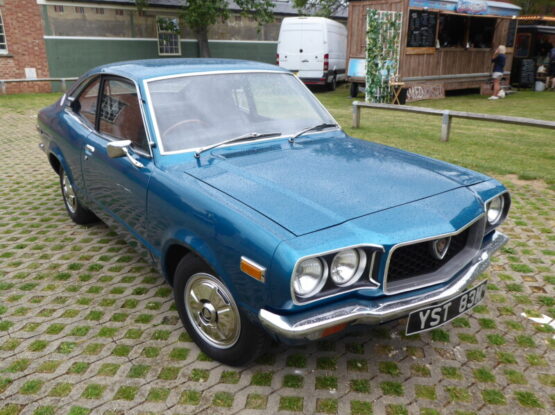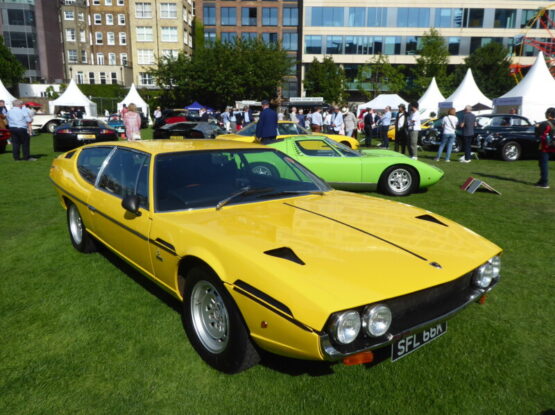Most of the regular car events I’ve been to whilst on my travels in the United States have been of the Breakfast Club, or Cars and Coffee type, which start very early and typically do not last anything like as long as an equivalent event would in the UK. But there are others that do not follow this format, and the weekly Scottsdale Pavilions meet is one of them. This is held in a reserved area of a massive parking lot just a few hundred yards off the 101 Loop freeway in the south eastern part of Scottsdale. I’ve been a couple of times before, arriving around 4pm, and finding a lot of cars already parked up, neatly grouped together in themes either of model or category of car. You get a lot of recent (mainly American) performance and muscle cars, of course, but also quite an array of classics, with plenty of fabulous “Land Yachts” there, which I just love seeing. It’s not all good, as a lot of owners have a habit of opening the bonnet almost before coming to a stand-still and then setting up chairs so close to the car that the photographer cannot really get the unimpeded view of the car that is desired and also as the sun sets, so the shadows lengthen. The event goes on after dark, though the type of car attending changes gradually with more modified and customised vehicles arriving and the older cars heading home. On my April 2022 visit, I got to the site a bit earlier, unsure whether I would find it largely empty or not. It was not, and indeed a lot of the older cars were already there, so there was plenty for me to have a look at. I stayed for around 3 hours, enjoying the spectacle of a lot of cars that you would be unlikely to see in Europe and with constant comings and goings, there was plenty to keep looking at as I wandered around. There are a number of eating places on site, too, though the food I had from Starbucks seemed somewhat to disagree with me a few hours later, which I just put down to bad luck! Here is what attracted my camera whilst I was on site.
AC
Genuine AC Cobra are rare beasts, as not that many were produced, but for the last as long as anyone can remember, there have all manner of replica and officially sanctioned continuation type cars produced, so there are pretty decent numbers of cars around that bear the legendary shape of this raw sports car and that’s just as true in the US as it is in the UK.
ACURA
In December 2007, Acura announced plans to launch a NSX successor by 2010, based on the styling of the front V10-engined Acura ASCC (Advanced Sports Car Concept). Despite prototypes being tested for production, just a year later, Honda announced that plans had been cancelled due to poor economic conditions. Instead, in March 2010, Honda unveiled the HSV-010 GT for participation in the Japanese SuperGT Championship. This car never reached production as a street-legal car. Reports that Honda was again developing a successor to the NSX remerged in April 2011. By December 2011, Honda officially announced a second generation NSX concept, which was unveiled the following month at the 2012 North American International Auto Show as the Acura NSX Concept. The production model was displayed three years later at the 2015 North American International Auto Show, for sale in 2016. Although the original name was retained, this time it was defined as “New Sports eXperience”. Unlike the first generation NSX which was manufactured in Japan, the new NSX was designed and engineered in Marysville, Ohio, at Honda’s plant, led by chief engineer Ted Klaus. The new NSX has a hybrid electric powertrain, with a 3.5 L twin-turbocharged V6 engine and three electric motors, two of which form part of the “SH-AWD” all wheel drive drivetrain, altogether capable of close to 600 hp. The transmission is a 9-speed dual-clutch automatic. Its body utilizes a space frame design—which is made from aluminium, ultra-high-strength steel, and other rigid and lightweight materials, some of which are the world’s first applications. The first production vehicle with VIN #001 was auctioned off by Barrett Jackson on 29 January 2016. NASCAR team owner Rick Hendrick won the auction with a bid for US$1,200,000. The entire bid was donated to the charities Pediatric Brain Tumor Foundation and Camp Southern Ground. The first NSX rolled off the line in Ohio on 27 May 2016. Hendrick was there to drive it off. The first sales of the new NSX were registered in the second half of 2016
AMC
The AMC AMX is a two-seat GT-style muscle car produced by American Motors Corporation from 1968 through 1970. As one of just two American-built two-seaters, the AMX was in direct competition with the one-inch (2.5 cm) longer wheelbase Chevrolet Corvette, for substantially less money. It was based on the new-for-1968 Javelin, but with a shorter wheelbase and deletion of the rear seat. In addition, the AMX’s rear quarter windows remained fixed, making it a coupe, while the Javelin was a true two-door hardtop. Fitted with the standard high-compression 290 cu in (4.8 L) or optional 390 cu in (6.4 L) AMC V8 engine, the AMX offered top-notch performance at an affordable price. In spite of this value and enthusiastic initial reception by automotive media and enthusiasts, sales never thrived. However, the automaker’s larger objectives to refocus AMC’s image on performance and to bring younger customers into its dealer showrooms were achieved. After three model years, the two-seat version was discontinued. The AMX’s signature badging was transferred to a high-performance version of its four-seat sibling, the Javelin, from the 1971 to 1974 model years. American Motors capitalized the respected reputation of the original two-seat AMXs by reviving the model designation for performance-equipped coupe versions of the compact Hornet in 1977, Concord in 1978, and the subcompact Spirit in 1979 and 1980.
This Pacer caused quite a reaction when it arrived, as these often derided cars are quite rare now. The AMC Pacer is a two-door compact car produced in the United States by American Motors Corporation (AMC) from the 1975 through the 1980 model years. The Pacer was also made in Mexico by Vehículos Automotores Mexicanos (VAM) from 1976 until 1979 and positioned as a premium-priced luxury car. Design work began in 1971. The rounded shape and large glass area were unusual compared with the three-box designs of the era. The Pacer’s width is equal to full-sized domestic vehicles at the time, and this unique design feature was promoted by AMC as “the first wide small car.” The Pacer was the first modern, mass-produced, U.S. automobile design using the cab forward concept. Introduced in showrooms on 28 February 1975, the Pacer was designed to attract buyers of traditional large cars to a smaller package during a time when gasoline prices were projected to rise dramatically. In its first year of production, the Pacer sold well, with 145,528 units. There was little competition from other American manufacturers, most of whom had been blindsided by the oil crisis. The increased demand for compact, economy vehicles was growing rapidly. However, Pacer sales fell after the first two years, though the car continued to be built through the 1980 model year. Similar to its mid-year introduction, on 3 December 1979, production of the Pacer ended at the Kenosha, Wisconsin assembly plant where it had begun five years earlier. A total of 280,000 cars were built. Increasing competition from the Big Three U.S. automakers and the rapid consumer shift to imported cars during the late 1970s are cited as the reasons for this outcome. Automobile buyers in the U.S. became adjusted to smaller and lighter cars, particularly the imports that offered better gas mileage presented, the AMC Pacer could not match the German and Japanese cars. Also the large glass areas increased the car’s weight. Achieving about 22 mpg‑US (11 L/100 km; 26 mpg‑imp), the Pacer was not a top choice for customers during the 1979 energy crisis. Moreover, AMCs partnership with Renault brought the Renault 5 named “Le Car” to the AMC dealers as a more economical model. The design of the Pacer provided inspiration to the restyling of the Renault 5 to meet the needs and requirements of the American Market. The Pacer’s unconventional styling was commonly cited in its lack of success. Other concerns included a lack of cargo space when carrying a full load of passengers (because of its short wheelbase). Cargo space could be increased to 29.5 cubic feet (0.84 m3) by folding down the back of the rear seat to form a flat floor. Drivers also cited a lack of power. The Pacer was heavy; Car & Driver wrote, “American Motors had already quoted a curb weight of 2990 lb. for the basic Pacer when we first wrote about the car, and that already seemed quite heavy; but when we weighed the test car (whose air conditioning, automatic transmission, power steering and so forth would not account for the full difference) it registered an astounding 3425 lb.”, and the standard 232 cu in (3.8 L) I6, with a single-barrel carburetor and optimized for low emissions (all vehicles at the time carried emissions-reducing devices, including exhaust gas recirculation); was relatively low-powered (“The Pacer comes with either of two AMC inline six-cylinder engines, both producing 100 bhp, but the larger 258-cu-in. unit delivering better mid-range torque”). In 1976, a “High Output” version of the 258 cu in (4.2 L) engine was offered, which helped performance at the cost of higher fuel consumption. By the time a 304 cu in (5.0 L) V8 was offered in 1978, the company had introduced a successful line of “luxury-compact” models (the AMC Concord). Additionally, gasoline prices remained high, limiting demand for V8-powered vehicles. For increased cargo capacity, a station wagon body style was offered from 1977. The wagon version was only five inches longer (127 mm) and weighed only 76 pounds (34 kg) more than the coupe. It was also a less unusual-looking design with a squared-off back and straight, almost upright, rear side windows. Although front vent windows were optional on all Pacers, the wagon’s rear side glass featured vent windows as standard. The broad and rear liftgate opened to a wide, flat cargo area with 47.8 cubic feet (1.35 m3) of space, significantly easing the task of loading cargo. The rear seat also folded flat to form a continuation of the cargo floor. Some wagon models featured simulated woodgrain trim on the lower body sides and the liftgate. The Pacer started out as an economy car, and eventually became a small luxury car. There were several available comfort, convenience, and appearance packages while the range of options increased over the model years. Reviews upon its introduction used descriptions like “futuristic, bold, and unique.” The Pacer featured an aerodynamic “jellybean” styling, numerous innovations such as different door lengths, and was noted “as a space-efficient car, seemingly from the future.”. The Pacer stood out a time when “Detroit was still rolling out boat-sized gas guzzlers.” Europeans were less impressed. The car featured on the cover of Motor Magazine with the memorable headline “We test the Pacer, and wish we hadn’t”.
BMW
Sole BMW of note was this 2002 Tii. There were only a couple of BMWs here. The 1600-2, as the first “02 Series” BMW was designated, was an entry-level BMW, and was smaller, less expensive, and less well-appointed than the New Class Sedan on which it was based. BMW’s design director Wilhelm Hofmeister assigned the two-door project to staff designers Georg Bertram and Manfred Rennen. The 9.1 in shorter length and wheelbase and lighter weight of the two-door sedan made it more suitable than the original New Class sedan for sporting applications. As a result, the two door sedan became the basis of the sporting 02 Series. The 1600-2 (the “-2” meaning “2-door”) made its debut at the Geneva Show in March 1966 and was sold until 1975, with the designation being simplified to “1602” in 1971. The 1.6 litre M10 engine produced 84 hp at 5,700 rpm and 96 lb·ft. A high performance version, the 1600 TI, was introduced in September 1967. With a compression ratio of 9.5:1 and the dual Solex PHH side-draft carburettor system from the 1800 TI, the 1600 TI produced 110 hp at 6,000 rpm. Also introduced in September 1967 was a limited-production cabriolet, which would be produced by Baur from 1967 through 1971. A hatchback 1600 Touring model was introduced in 1971 but was discontinued in 1972. It was what came next which was more significant. Helmut Werner Bönsch, BMW’s director of product planning, and Alex von Falkenhausen, designer of the M10 engine, each had a two litre engine installed in a 1600-2 for their respective personal use. When they realised they had both made the same modification to their own cars, they prepared a joint proposal to BMW’s board to manufacture a two litre version of the 1600-2. At the same time, American importer Max Hoffman was asking BMW for a sporting version of the 02 series that could be sold in the United States. As per the larger coupe and 4-door saloon models, the 2.0 engine was sold in two states of tune: the base single-carburettor 2002 producing 101 hp and the dual-carburettor high compression 2002 ti producing 119 hp.In 1971, the Baur cabriolet was switched from the 1.6 litre engine to the 2.0 litre engine to become the 2002 cabriolet, the Touring hatchback version of the 02 Series became available with all engine sizes available in the 02 Series at the time and the 2002 tii was introduced as the replacement for the 2002 ti. The 2002 tii used the fuel-injected 130 hp engine from the 2000 tii, which resulted in a top speed of 185 km/h (115 mph). A 2002 tii Touring model was available throughout the run of the tii engine and the Touring body, both of which ended production in 1974. The 2002 Turbo was launched at the 1973 Frankfurt Motor Show. This was BMW’s first turbocharged production car and the first turbocharged car since General Motors’ brief offerings in the early 1960s. It produced 170 hp. The 2002 Turbo used the 2002 tii engine with a KKK turbocharger and a compression ratio of 6.9:1 in order to prevent engine knocking. Kugelfischer mechanical fuel injection was used, with a sliding throttle plate instead of the usual throttle butterfly. The 2002 Turbo was introduced just before the 1973 oil crisis, therefore only 1,672 were built. The 1802 was introduced in 1971 and was available with either the original 2-door sedan body or the 3-door Touring hatchback introduced that year. Production of the Touring model continued until 1974, with the 1802 sedan ending production the following year. The 1502, an economy model with an engine displacement of 1573 cc was introduced in 1975. This engine had a lower compression ratio of 8.0:1, therefore standard-octane petrol could be used. While the rest of the 02 Series was replaced in 1975 by the E21 3 Series, the 1502 was continued until 1977.
BUICK
The Buick Invicta is a full-size automobile produced by Buick from 1959 to 1963. The Invicta was a continuation of the intermediate Buick Super that mated the standard size Buick LeSabre (pre-1959, Buick Special) body with Buick’s larger 401 cubic inch Fireball V8 engine. The Invicta continued to be the intermediate hardtop coupe, hardtop sedan, convertible and station wagon, labelled as the Buick Invicta Estate until it was replaced by the Buick Wildcat as a coupe or sedan, while the station wagon was replaced by the Buick Sport Wagon in 1965. The name was derived from Latin and signified ‘unconquerable, invincible, unbeatable, unvanquished’ according to Buick Motor Division sales training materials. The Invicta series was introduced as a full line of body styles for model year 1959. Sales never approached that of either the entry-level LeSabre or top level Electra models, but were consistent with the traditional sales penetration of Buick’s sporty mid-priced models (the 1954 to 1958 Century and 1963 to 1970 Wildcat). The Invicta continued the tradition of installing Ventiports on the front fenders from the Century. In a survey of 1959 Buick owners in the March, 1959 issue of Popular Mechanics, 47.1% of owners like the ride comfort, though many (25.2%) said the drive shaft tunnel was too big. Starting in 1960, an Invicta Custom trim package was offered, featuring bucket seats and a ‘consolette’ in the hardtop coupe, convertible and wagon and a leather bench seat with a centre armrest on some 4 door hardtops. Sales were nominal. According to Robin Moore’s 1969 book The French Connection, “the 1960 Buick Invicta had a peculiarity in body construction conducive to the installations of…extraordinary, virtually detection-proof traps concealed within the fenders and undercarriage” that made it a popular model for international heroin smugglers. A fully-designed model was produced for 1961.
In February 1982, the Regal Grand National debuted, which was named for the NASCAR Winston Cup Grand National Series (the “Grand National” term was part of the Cup series nomenclature until 1986). Buick had won the Manufacturers Cup in 1981 and 1982, and wanted to capitalize on its success: “What wins on Sunday, sells on Monday”. These 1982 cars were not painted black, which may confuse those not familiar with them. All started out as charcoal gray Regals that were shipped off to a subcontractor for finishing. Originally intended for a run of 100 units, Cars and Concepts of Brighton, Michigan, retrofitted 215 Regals with the GN package. Most obvious was the light silver gray firemist paint added to each side. Red pinstripes and billboard shadow lettering proclaiming “Buick” were applied. The wheel opening mouldings and rocker panel mouldings were blacked out using black vinyl tape. Finally, a front air dam and rear spoiler were installed. On the inside, special “Lear-Siegler” seats were installed. These seats are fully adjustable and were covered with silver brandon cloth with black vinyl inserts. The front seat had Buick’s “6” emblem embroidered onto them. Also, a special clock delete plate was added to the instrument panel which contained the yellow and orange “6” logo and the words “Grand National Buick Motor Division”. The 1982 GN came with a naturally aspirated 252 cu in (4.1 L) V6 engine with 125 hp at 4000 rpm and 205 lb/ft (278 Nm) of torque at 2000 rpm. Of the 215 Regal Grand Nationals produced in 1982, at least 35 were based on the Buick Regal Sport coupe package with the turbocharged 3,791 cc V6 engine with 175 hp at 4000 rpm and 275 lb/ft (373 Nm) of torque at 2600 rpm. There were only 2022 Sport coupes produced in 1982, and the number of cars with both the GN and Sport coupe packages is estimated to be fewer than 50. For 1983, there was no Grand National. The Sport coupe model was renamed the T-Type; 3,732 were produced (190 hp at 1600 rpm and 280 lb/ft (380 Nm) of torque at 2400 rpm). The T-Type had been used on other Buicks, starting with the Riviera in 1981 (in 1979 and 1980, it was the S Type). The 1983 Regal T-Type featured tube headers, Hydro-Boost II brakes, 200-4R 4-speed overdrive trans and 3.42 rear axle (7.5″). For 1984, the Grand National returned, now in all black paint. The turbocharged 3,791 cc (3.8 L; 231.3 cu in) became standard and was refined with sequential fuel injection, distributor-less computer controlled ignition, and boasted 200 hp at 4400 rpm and 300 lb/ft (407 Nm) of torque at 2400 rpm. Only 5,204 turbo Regals were produced that year, only 2,000 of which were Grand Nationals. Because this was the first year production of the computer controlled sequential fuel injection and distributor-less ignition, this is often considered the year and model that started the development of the legendary intercooled Grand Nationals. The performance of this package was well ahead of its time and the “little V6” easily kept up with the bigger V8s. 1⁄4 mile performance was listed at 15.9 seconds at stock boost levels of 10 psi (0.69 bar), while for the same year, the Chevrolet Camaro V6 was listed at 17.0 and the Chevrolet Corvette at 15.2 seconds.Soon, performance enthusiasts determined the modifications that worked and the Grand Nationals easily broke into the 13-second territory. All Grand Nationals had the Lear Siegler-made cloth/leather interior which was only available for this year. An estimated 200 of the 1984 Grand Nationals were produced with the T-Top option which makes these the rarest of the Grand Nationals. For 1986, a modified engine design with air-air intercooling boosted the performance even further to a specified 235 hp at 4000 rpm and 330 lb/ft (447 Nm) of torque at 2400 rpm. The Grand Nationals (quantity 5,512) and T-Types (quantity 2,384) were both produced in 1986. For 1987, performance reached 245 hp and 355 lb/ft (481 Nm) of torque. Buick dropped the T-Type package for Regal for 1987 models and opted for a “T” sport package instead. There were only 7,896 turbo Regals produced in 1986. In 1987, when turbo Regals reached their peak in popularity, a total of 27,590 turbo Regals were produced through December, with those models produced between September and December of that year window stickered as “1987½ Buick Grand National” vehicles. For 1987, a lightweight WE4 (turbo T) option was offered. Only 1,547 of this variant were produced. The differences between a WE4 and the Grand National were the interior trim package, wheels, exterior badging, aluminium bumper supports, and aluminium rear drum brakes as opposed to the Grand National’s cast iron, making the WE4 a lighter and faster car. The rear spoiler was only available as a dealer installed option. Nineteen eighty-seven was the only year that the LC2 turbo option was available on any Regal, making it possible to even see a Limited with a vinyl landau roof and a power bulge turbo hood. Turbo Regal Limiteds were one of the rarest models of turbo Regals produced second only to the GNX at 1,035 turbo Limiteds. Turbo Regal Limiteds could be ordered with many options with most having chrome external trim but for $35 could have been built with the full black-out trim option making them extremely rare. Limiteds were treated to a very luxurious interior with plush carpeting and optional bench pillow seats and a column shift. The 1987 model would be the end of the manufacture of the RWD “G-Body” Regal, but GM had to extend the build of the Grand National to meet customer demand into December. For the final year, 1987, Buick introduced the limited production GNX, for “Grand National Experimental”, at $29,900. Made in partnership with McLaren Performance Technologies/ASC, Buick produced only 547 GNs with the interior trim package, that were then sent off to McLaren and upgraded into the Buick GNX. Buick underrated the GNX at 276 hp at 4400 rpm and a very substantial 360 lb⋅ft (488 Nm) at 3000 rpm of torque, although actual output is 300 bhp and 420 lb/ft (569 Nm). This was created to be the “Grand National to end all Grand Nationals.” Changes made included a special Garrett AiResearch T-3 turbocharger with a ceramic-impeller blowing through a more efficient and significantly larger capacity intercooler with a “Cermatel (ceramic-aluminum) coated” pipe connecting the intercooler to the engine. A GNX specific E-EPROM, low-restriction exhaust with dual mufflers, reprogrammed turbo Hydramatic 200-4R transmission with a custom torque converter and transmission cooler, and unique differential cover/Panhard bar included more of the performance modifications. Exterior styling changes include vents located on each front fender, 16 inch black mesh style wheels with VR-speed rated tires, and deletion of the hood and fender emblems. The interior changes of the GNX included a serial number on the dash plaque and a revised instrument cluster providing Stewart-Warner analog gauges, including an analog turbo boost gauge. Performance was measured faster than the Ferrari F40 and the Porsche 930 with a 1⁄4 mile time of 12.7 seconds at 113.1 mph (0.3 and 0.8 seconds quicker, 2.9 and 13.3 mph faster) and a 0-60 mph time of 4.6 seconds (0.4 and 0.3 seconds quicker, respectively). GNX #001 is the 1986 prototype currently owned by Buick and sometimes makes appearances at car shows around the US. The GNX used a unique torque arm that was mounted to a special, GNX only, rear differential cover, for increased traction. The torque arm rear suspension alters the suspension geometry, making the body lift while planting the rear tires down, resulting in increased traction. The stealthy appearance of the all-black GNX and Grand National (and the resemblance of its grill to his helmet’s mouthpiece), coupled with the fact that the Grand National was initially released during the popularity of Star Wars movies, earned it the title “Darth Vader’s Car”. Car and Driver covered the GNX model’s introduction with the headline “Lord Vader, your car is ready.” Due to the turbocharged six cylinder engine, the Buick make, and the black paint Grand Nationals were sometimes referred to as the “Dark Side”. The “Dark Side” contrasted with the more common V8 Mustangs and Camaros that were popular at the time. The cars are highly collectible now.
There was a Regal T Type here as well.
CADILLAC
The first all-new postwar Cadillacs arrived in 1948, sporting an aircraft-inspired look and the first tail fins on a Cadillac. Series 62 Cadillacs had a slightly shortened wheelbase, but the track width was widened by two inches, increasing interior room. However, updated drivetrains would have to wait another year and for the time being, the new Cadillacs were still powered by the same 346 CID flathead V8 used across the board since 1941, which delivered only fair performance (0-60 in 16 seconds with a top speed of 93 mph). Fuel mileage was an estimated 14 mpg highway, 10 mpg city with the Hydramatic transmission, which was rapidly becoming the norm on Cadillacs–by 1949, only 10% of Cadillacs were ordered with the 3-speed manual gearbox. Series 62 production totalled 34,213 vehicles for the 1948 model year, accounting for 68% of Cadillac’s volume. The 1948 models had been slow to get into production and did not arrive in showrooms until February 1948, consequently Cadillac produced on 50,599 total vehicles for the abbreviated model year. The new Cadillac OHV V8 was the big news for 1949, with minor trim differences otherwise. This 331 cu in (5.4 L) engine produced 160 hp and weighed 200 pounds less than the old flathead V8 in addition to being shorter and lower. The 331 V8 could also handle higher compression levels to take advantage of improved, higher octane postwar gasoline formulations. The major difference between Series 61 and Series 62 models of similar body style was minor trim variations. The higher-priced series again had grooved, front fender stone shields and bright rocker panel moldings. Chevrons below the taillights were no longer seen. The convertible was an exclusive offering. A heater was optional. Sales reached a record 55,643. The Cadillac Series 62 Coupe de Ville was introduced late in the 1949 model year. Along with the Buick Roadmaster Riviera, and the Oldsmobile 98 Holiday, it was among the first pillarless hardtop coupes ever produced. At $3,496 it was only a dollar less than the Series 62 convertible, and like the convertible, it came with power windows standard. It was luxuriously trimmed, with leather upholstery and chrome ‘bows’ in the headliner to simulate the ribs of a convertible top. 55,643 Series 62 Cadillacs were produced in 1949 out of a total volume of 92,554 vehicles. For 1950, major styling changes were performed. The cars were lower and sleeker, with longer hoods, and one-piece windshields were fitted. Hydra Matic transmission was now standard. The Series 61 was again a short wheelbase model, having been reduced to 122 in (3099 mm). Sales set yet another record at 59,818. Full-length chrome rocker panels set off the 1951 model, and the Coupe de Ville was now marked with noticeably-improved trim, including Coupe de Ville script on the rear roof pillar. Sales were 81,844, or a record of over 74% of all Cadillacs sold. Popular Mechanics reported about 12-MPG at 45 mph. In 1952, to commemorate the 50th anniversary of Cadillac, the V-shaped hood and deck emblems were done as gold castings. The Series 62 sedan was also characterized by a higher rear deck lid contour. This provided additional luggage space. Back up lights were now standard equipment and were incorporated in the taillights. The grille wraparound panels were redesigned once again having broad chrome trim below each headlight with side scoop styling and gold-coloured winged emblem mounted in the centre. At the rear all Cadillacs adopted a through the bumper dual exhaust system. Deck ornamentation took the form of a Cadillac crest over abroad golden “V”. New standard features included self-winding clocks, improved direction signal indicators, glare proof mirrors, stannate treated pistons, and four barrel carburetion. Engine output for the 331 was up to 190 hp. Sales fell to 70,255, but with the Series 61 out of the way, Series 62 sales accounted for a record 78% of all Cadillacs. The 1953 Series 62 saw a redesigned grille with heavier integral bumper and bumper guards, the repositioning of parking lamps directly under the headlights, chrome “eyebrow” type headlamp doors, and one piece rear windows without division bars. Wheel discs were fashioned in an attractive new disced design. Series 62 bodystyles were identified by non louvered rear fenders, the use of thin bright metal underscores on the bottom rear of the cars only and the decoration of both hood and deck lid with Cadillac crests and V- shaped ornaments. The Club Coupe model disappeared. Two door Series 62 were now all hardtops (including the better equipped Coupe de Ville) or convertibles. Another familiar name appeared on 1953’s Series 62. The top of the line sub-series Eldorado was one of three specialty convertibles produced in 1953 by General Motors, the other two being the Oldsmobile 98 Fiesta and the Buick Roadmaster Skylark. The Eldorado was a limited-edition luxury convertible, and would eventually become its own series. It featured a full assortment of deluxe accessories, including wire wheels, and introduced the wraparound windshield to Cadillac standard production. Sales set a new record at 85,446.
The Cadillac XLR is a front-engine, rear-drive, two passenger roadster manufactured and marketed by Cadillac from 2003 to 2009 across a single generation — and noted for its power retractable hardtop, Bulgari designed interior instruments, head-up display, adaptive suspension marketed as Magnetic Ride Control, rear-mounted transmission and near 50/50 front-to-rear weight distribution. As Cadillac’s flagship model, the XLR was introduced at the 2003 North American International Auto Show and began production with model year 2004 — foreshadowed by the 1999 Evoq concept. Sharing the GM Y platform and manufactured alongside the Chevrolet Corvette in Bowling Green, Kentucky, the two cars also share hydroformed perimeter frame and composite bodywork construction — though each have unique exterior and interior styling, suspension settings and engine. The XLR was the first production Cadillac with radar-based adaptive cruise control (ACC) and the first to offer both heated and cooled seats. The XLR was nominated for the North American Car of the Year award for 2004. The Cadillac XLR was marketed as a luxury roadster and offered numerous features either as standard equipment or as options, including a touchscreen GPS navigation radio with an AM/FM radio, CD changer, XM Satellite Radio, full voice control, and a full Bose premium amplified audio system, adaptive cruise control, Bulgari-branded instrument panel cluster, OnStar, High Intensity Discharge (HID) front headlamps, perforated luxury leather-trimmed seating surfaces with power-adjustable, heated and cooled bucket seats with a driver’s memory system, luxury carpeted floor mats with embroidered ‘XLR’ logos, premium aluminum-alloy wheels, and wood interior trim. The XLR’s featured adaptive suspension with magneto-rheological shock absorber fluid for enhanced ride control. The system uses four wheel-to-body displacement sensors to measure wheel motion over the road surface and responds by adjusting the shock damping almost instantly. The shock absorbers are filled with a fluid that contains suspended iron particles that respond to magnetic signals. The system responds by constantly monitoring motion and changing the damping forces at all four corners of the vehicle — to modulate body motion during aggressive maneuvers or on uneven road surfaces. Where the Chevrolet Corvette (C6) was powered by a 6.0L LS2 V8 engine and offered a six-speed manual transmission, the XLR featured Cadillac’s 4.6L Northstar V8 (supercharged in the XLR-V) and either a five-speed 5L50 automatic transmission, or a six-speed 6L80 automatic transmission. Optional XLR equipment included polished aluminium-alloy wheels, exterior and interior colour options, and different interior trim options. The XLR featured the traditional Cadillac, silver-painted upper “Egg Crate” (XLR) or chrome wire mesh (XLR-V) front grille, which had a similar appearance to gravel shields commonly installed on cars during the 1930s. Other standard items included angular front High Intensity Discharge (HID) front head lamps, vertical rear tail lamps, and chrome exterior details. Inside, the XLR featured wood interior trim in addition to the C6 Corvette’s aluminium trim, and different seats. For model year 2009, the XLR added a new front fascia, new rear fascia, and chrome side fender vents. Inside, Alcantara – a suede-like microfiber material – was added for the headliner. The interior added new instrument cluster trim rings with revised graphics, (removal of the Bulgari logo) and new wood dashboard trims. XLR production ended on March 31, 2009. The base price of the XLR in the United States went from $75,385 ($108,100 in 2021 dollars at launch to $86,215 ($108,508 in 2021 dollars by the end of its run in 2009. Cadillac projected sales of 5 – 7,000 cars a year but the reality is that they only sold 15460 cars in total between 2003 and 2011.
CHEVROLET
Almost a show in its own right and indeed the group was slightly separate from the rest of the gathering was a meet for the local Corvair owners. More than 25 of these cars were gathered together – not something I’ve ever seen before, as you only see these cars occasionally in Europe and they are not even that common in the US . Plenty has been written about the Corvair, following the publication of consumerist Ralph Nader’s book “Unsafe at any Speed”, even though subsequent research found that the car was no more prone to the things which the non-driving Nader alleged than many others on sale at the same time. Although the book damaged sales, that was not the only reason why the car ultimately was not that commercially successful. Until 1960, the “Big Three” domestic auto manufacturers (General Motors, Ford, and Chrysler) produced only one basic size of passenger cars: large. However, a successful modern “compact car” market segment was established in the US by the 1950 Nash Rambler. Moreover, imports from Europe, such as Volkswagen, Renault, and Fiat, showed that there was demand in the US for small cars, often as a second car or an alternative for budget-minded consumers. While the “Big Three” continued to introduce ever-larger cars during the 1950s, the newly formed American Motors Corporation (AMC) focused its business strategy on smaller-sized and fuel-efficient cars, years before there was a real need for them. The sale success of the Rambler did not go unnoticed, so during 1959 and 1960, the Big Three automakers planned to introduce their own “compact” cars. Most of these designs were scaled-down versions of the conventional American car, using four- or six-cylinder engines instead of V8s, and with bodies about 20% smaller than their standard cars. The exception to this was going to be Chevrolet’s offering, the Corvair. Led by General Manager Cole, Chevrolet designed a revolutionary new car. It was powered by an air-cooled horizontal six-cylinder 2.3 litre engine made almost entirely out of aluminium, which initially produced 80 bhp. The engine was mounted in the rear of the car, driving the rear wheels through a compact transaxle. Suspension was independent at all four wheels. There was no conventional frame, it was the first unibody built by Fisher Body. The tyres were an entirely new wide low-profile design. The styling was unconventional for Detroit: subtle and elegant, with no tailfins or chrome grille. Its engineering earned numerous patents, while Time magazine put Ed Cole and the Corvair on the cover, and Motor Trend named the Corvair as the 1960 “Car of the Year”. As well as a four door saloon, the range included a two door coupe, a convertible, and from 1961, an estate car as well as a range of light commercial vehicles including a panel van and a pick up. The Corvair’s sales exceeded 200,000 for each of its first six model years. Sales figures revealed to Chevrolet management that the Corvair was more of a specialty car than a competitor to the conventionally designed Ford Falcon or Chrysler’s Valiant. Corvair was not as competitive in the economy segment and Chevrolet began a design program that resulted in a compact car with a conventional layout, the Chevy II, for the 1962 model year. That meant that the Corvair was developed in a different way, with more emphasis put on the sporting models. so in 1962 a high performance 150 hp turbocharged “Spyder” option was added for the Monza coupes and convertibles, making the Corvair the second production automobile to come with a turbocharger as a factory option The Monza Coupe was the most popular model with 151,738 produced out of 292,531 total Corvair passenger car production for 1962. The Corvair was fast becoming the darling of the sporty car crowd. Many after-market companies offered a vast array of accessories for the Corvair, everything from imitation front grilles to serious performance upgrades such as additional carburettors, superchargers and performance exhaust and suspension upgrades. There were numerous detailed changes for 1963 and 1964. The Monza line really came into its own, as in 1963, 80% of sales were Monzas. The Convertible model counted for over 20% of all the Monzas sold. A sporty image meant big profits. In October 1964, Chevrolet presented a new Corvair, with different styling and detailed refinements to the mechanical parts, as well as fully independent rear suspension replacing the former swing axles. Saloon, coupe and convertibles were the only body styles offered, the other versions having been not renewed. Although the new car received rave reviews from journalists such as the often-critical David E Davies, sales were not that strong, and they declined every year thereafter. By 1967, the range was pruned to just the 500 and Monza Hardtop Coupes and Hardtop Sedans, and the Monza Convertible. Chevrolet was still actively marketing the Corvair in 1967, including colour print ads and an “I Love My Corvair” bumper sticker campaign by dealers, but production and sales continued to fall off drastically. Only 27,253 copies were built. In 1968, the four-door hardtop was discontinued, leaving three models—the 500 and Monza Hardtop Coupes and the Monza Convertible. All advertising was virtually stopped and sales were down to 15,400. The final model-year 1969 Corvairs were assembled almost by hand at the same plant as the Nova in Willow Run, Michigan. A total of 1,786,243 Corvairs were produced between 1960 and 1969. The phenomenal success of the Ford Mustang and that 1966 book had proved very damaging to the Corvair, and GM decided that their sporting future lay with the Camaro and for families, with the Nova. These days, there is something of a cult-following for the Corvair.
As well as a large number of saloon and Coupe models, there were also examples of the Lakeside wagon, and the Greenbrier and Rampside vans and pickups.
Chevrolet replaced the entire range of cars for 1955, producing what are sometimes referred to as the “Tri-Five” range, which would live for three years. Revolutionary in their day, they spawned a cult following that exists in clubs, website and even entire businesses that exclusively cater to the enthusiasts of the Tri Five automobiles. All featured a front-engine, rear-wheel-drive layout. They remain some of the most popular years for collectors and hot rodders. 1955-1957 were watershed years for Chevrolet, who spent a million dollars in 1956 alone for retooling, in order to make their less expensive Bel Air models look more like a Cadillac, culminating in 1957 with their most extravagant tailfins and Cadillac inspired bumper guards. In 1955, Americans purchased 7.1 million new automobiles, including 1.7 million Chevrolets, giving the company fully 44% of the low-price market and surpassing Ford in total unit sales by 250,000. The Bel Air was an instant hit with consumers, with Base One-Fifty models starting under $1600 and featuring a six cylinder engine. The introduction of the new optional 170 hpr 265ci V8, coupled with the Powerglide automatic transmission quickly earned the model the nickname “The Hot One”. In the first year of production, the oil filter was considered an option, although not having it led to significantly shorter engine life. With three basic model lines of 150, 210 and Bel Air and a range of body styles from 2 and 4 door Sedans to Coupes, Convertibles and Wagons, there were as many as 19 different Tri-five models available. The 1956 cars saw minor changes to the grille, trim and other accessories. It meant huge gains in sales for Chevrolet, who sold 104,849 Bel Air models, due in part to the new V8 engine introduced a year before. By this time, their 265cid V8 had gained popularity with hot rodders who found the engine easy to modify for horsepower gains. This wasn’t lost on Chevrolet’s engineers, who managed to up the horsepower in 1956 from 170 hp to 225 hp with optional add-ons. The average two door Bel Air in 1956 sold for $2100, which was considered a good value at the time. Prices ranging from $1665 for the 150 sedan with six cylinder engine to $2443 for the V8 equipped convertible, with Nomad models running slightly higher. Bigger changes came for 1957, including the large tailfins, “twin rocket” bonnet design, even more chrome, tri-colour paint and a choice from no less than seven different V8 engines. While in 1957, Ford outsold Chevrolet for the first time in a great while, years later the used 1957 Chevrolets would sell for hundreds more than their Ford counterparts. As the horsepower race continued, Chevrolet introduced a new version of their small block, with 283 cubic inches of displacement and 245 hp. They also introduced a limited number of Rochester fuel injected 283 engines that produced 283 hp, the first production engine to achieve 1 hp per cubic inch. For all intent and purposes, this made the 1957 Bel Air a “hot rod”, right off the production line. It was available with manual transmission only. The base 265cid engine saw an increase from 170 to 185 hp as well. While not as popular as the previous year’s offering, Chevrolet still managed to sell 1.5 million cars in 1957. Today, a 1957 Chevrolet Bel Air like this one is one of the most sought after collector cars ever produced. There were a number of 56 and 57 model year examples here including a 57 Bel Air and the rare Nomad wagon.
For 1958, GM was promoting their fiftieth year of production, and introduced anniversary models for each brand; Cadillac, Buick, Oldsmobile, Pontiac, and Chevrolet. The 1958 models shared a common appearance on the top models for each brand; Cadillac Eldorado Seville, Buick Roadmaster Riviera, Oldsmobile Super 88 Holiday, Pontiac Bonneville Catalina, and the Chevrolet Bel-Air Impala. The Impala was introduced for the 1958 model year as top of the line Bel Air hardtops and convertibles. From the windshield pillar rearward, the 1958 Bel Air Impala differed structurally from the lower-priced Chevrolet models. Hardtops had a slightly shorter greenhouse and longer rear deck. The wheelbase of the Impala was longer than the lower priced models, although the overall length was identical. Interiors held a two-spoke steering wheel and colour-keyed door panels with brushed aluminium trim. No other series included a convertible. The 1958 Chevrolet models were longer, lower, and wider than its predecessors. The 1958 model year was the first with dual headlamps. The tailfins of the 1957 were replaced by deeply sculptured rear fenders. Impalas had three taillights each side, while lesser models had two and wagons just one. The Impalas included crossed-flag insignias above the side moldings, as well as bright rocker moldings and dummy rear-fender scoops. The standard perimeter-type frame was abandoned, replaced by a unit with rails laid out in the form of an elongated “X.” Chevrolet claimed that the new frame offered increased torsional rigidity and allowed for a lower placement of the passenger compartment. This was a transitional step between traditional construction and the later fully unitized body/chassis, the body structure was strengthened in the rocker panels and firewall. However, this frame was not as effective in protecting the interior structure in a side impact crash, as a traditional perimeter frame. A coil spring suspension replaced the previous year’s rear leaf springs, and an air ride system was optional. A 283 cu in (4,640 cc) engine was the standard V8, with ratings that ranged from 185 to 290 horsepower. A “W” block (not to be confused with the big-block) 348 cu in (5,700 cc) Turbo-Thrust V8 was optional, producing 250 hp, 280 hp , or 315 hp. The Ramjet fuel injection was available as an option for the Turbo-Fire 283 V8, not popular in 1958. A total of 55,989 Impala convertibles and 125,480 coupes were built representing 15 percent of Chevrolet production. The 1958 Chevrolet Bel Air Impala helped Chevrolet regain the number one production spot in this recession year.
Redesigned in 1965, the Impala set an all-time industry annual sales record of more than 1 million units in the United States. All new full-size Chevrolets eschewed the “X” frame for a full-width perimeter frame, a new body that featured curved, frameless side glass (for pillarless models), sharper angled windshield with newly reshaped vent windows, and redesigned full-coil suspension. In 1965, Chevrolet introduced a new luxury package for the Impala four-door hardtop, called “Caprice” and coded as RPO Z18. Caprices received tufted upholstery, wood grained accents on the dashboard and specialty pulls on the insides of the doors. This “halo” model also featured the “spinner” wheel covers from the Impala SS, with the “SS” logo centers replaced by a Chevrolet “bowtie” emblem. The Super Sport’s blackout rear trim strip below the triple taillights was also used, with the “Impala SS” emblem replaced by a large “Caprice by Chevrolet” badge. The Impala block lettering on each front fender was replaced with “Caprice” script. The Caprice package was reintroduced as the Chevrolet Caprice Custom in 1966, taking the top position in the full-size Chevrolet lineup. Engine choices included the inline six-cylinder as well as the small-block and big-block V8s. A new three-range Turbo Hydra-Matic automatic transmission was optional for 396 cu in (6.5 L) V8. The old 409 cu in (6.7 L) “W” engine was discontinued early in the 1965 model year, so early-production 1965s got the 409, as well as 1/10 of 1% had the 396 CID big-block. Other later-built cars had the 396 cu in (6.5 L) as the big-block option. Two-speed Powerglide, as well as 3- and 4-speed manual transmissions were available. As with previous years, Impalas featured more chrome trim inside and out, with pleated tufted upholstery and door panels. The Impala would be the #2-selling convertible in the US in 1966, with 38,000 sold; it was beaten by the Mustang by almost 2:1. 1966 saw a pair of enlarged big-block V8s featuring 427 cu in (7.0 L). The RPO L36 was rated at 385 hp, the L72 at 425 hp. The L72 was only available with a manual transmission. The 1967 model was redesigned with enhanced Coke bottle styling that featured Corvette-inspired front and rear fender bulges. The curves were the most pronounced with the 1967–1968 models. In keeping with federal regulations, safety features were built into Impalas during the 1967 and 1968 model years, including a fully collapsible energy-absorbing steering column, side marker lights, and shoulder belts for closed models. The L72 engine was not available in 1967, but a L36 Turbo-Jet V8 was optional. The 1968 model was facelifted with a new front end. The new rear bumper housed triple “horseshoe” shaped taillights. 1968 also saw a new Impala model, the Custom Coupe. This two-door hardtop featured the same formal roofline as the Caprice Coupe. It was successful and would be continued through 1976. The L72 “427 Turbo-Jet” engine was once again returned to the option list, a solid-lifter V8 rated at 425 hp. It would continue to be available for both 1968 and 1969, replaced by the Turbo-Jet 454 for 1970. The 1969 Impala and other full-sized Chevrolets got new slab-sided bodies with a small “upsweep” at the rear quarter window, giving them a more formal appearance. It retained the 119-inch wheelbase from previous models. New front bumpers that wrapped around the grille and horizontal taillights were in the rear bumper. The hardtop Sport Coupe got a new notchback roofline, replacing the “fastback” C-pillar from 1967 to 1968. Ventless front windows were used on all models. Chevrolet had a rudimentary “power vent” system featuring vents in the instrument panel. The ignition switch was moved from the instrument panel to the steering column, and when the key was removed, the steering wheel and shift lever were locked. The 1969 model year Impala production topped Caprice production by 611,000 units. Impala station wagons were renamed Kingswood, a name which would continue through 1972. The similar 1970 Impala got a minor facelift featuring a more conventional under the grille bumper replacing the wrap-around unit used in 1969 along with new triple vertical taillights in the rear bumper. Canadian buyers got the choice of a lower priced companion to the Impala Sport Coupe, the Bel Air Sport Coupe, which used the same body but featured Bel Air trim.
The 1968 Chevelle received an all-new distinctly sculpted body with tapered front fenders and a rounded beltline. The car adopted a long-hood/short-deck profile with a high rear-quarter “kick-up”. While all 1967 Chevelle models rode a 115-inch (2,900 mm) wheelbase, the 1968 coupes and convertibles now rode a 112-inch (2,800 mm) wheelbase. The 4 door sedans and wagons turned to a 116-inch (2,900 mm) span. Tread width grew an inch front and rear. Hardtop coupes featured a semi-fastback, flowing roofline with a long hood and short deck, influenced by the all-new Camaro. The fastback appearance was a revival of a streamlining bodystyle on all GM products from 1942 until 1950, as demonstrated on the Chevrolet Fleetline. Top-trim models (including the SS 396 and new luxury Concours) featured GM’s new Hide-A-Way wiper system. Lesser Chevelles would get that change later. The entry-level Chevelle 300 (131 – 132 VIN prefix) was available as a pillared coupe and/or station wagon (Nomad) while the 300 Deluxe and Nomad Custom (133 or 134 VIN prefix) had a 2-door hardtop added to the lineup (fourth and fifth VIN characters will be 37; with the previous 300 Deluxe the hardtop was available with the Malibu and SS396 but not the base 300/Deluxe in the USA not counting those produced for the Canadian market). The Super Sport (SS396 sport coupe, convertible, and El Camino pickup) became series on its own. Chevrolet produced 60,499 SS 396 sport coupes, 2,286 convertibles, and 5,190 El Caminos; 1968 was the only year the El Camino body style would get its own SS396 series designation (13880). Government-mandated side marker lighting was incorporated, with early 1968 SS 396 light bezels seen with the SS 396 nomenclature – at some point in the later production cycle the engine callout had a 396 also shared with the Chevy II Nova SS (the side marker bezels, also sourced from the Chevy II Nova in 307, 327, and 396 displacements) had the engine displacement except for the six-cylinder models). Black-accented Super Sports had F70x14 red-stripe tyres and a standard 325 bhp 396-cubic-inch Turbo-Jet V8 engine with the special twin-domed hood; 350 and 375-horsepower 396 engines were optional. The SS 396 sport coupe started at $2,899 – or $236 more than a comparable Malibu with its 307-cubic-inch V8. All-vinyl bucket seats and a console were optional. Three luxury Concours options became available in March 1968 for the 4-door sedan, the 4-door sport sedan (and the hardtop coupe) and consisted of special sound insulation, and a deep-padded instrument panel with simulated woodgrain accents and all-vinyl color-keyed interiors. Interiors were sourced and shared with select Buick, Oldsmobile, or Pontiac A body patterns – during the middle of the 1968 model year, some Chevrolet A-bodies (including the El Camino) ended up with interior door panels shared with the Buick or Oldsmobile A bodies (Special, Skylark) where supply and demand issues forced a substitution, and during the April 1968 production month in the wake of the assassination of Reverend Dr. Martin Luther King Jr. there were some work stoppages e.g. strikes. A ribbed stainless steel panel was bolted to the rear taillight panel and a ‘Concours By Chevrolet’ emblem on the rear decklid. Other options included power windows and door locks. With the hardtop, a rare option is a horseshoe floor shifter with an integrated console (with bucket seats – sourced from the SS). These Concours options (ZK5, ZK6, and ZK7) should not be confused with the two Concours station wagons. At the time the ZK5, ZK6, and ZK7 Concours package was the equivalent of the Caprice. Also new for 1968 was the elimination of the term “sedan” for the 2-door pillar body style. This was now called a coupe (or pillar coupe) while the 2-door hardtop remained a sport coupe. These coupe/sport coupe designations would continue into 1969 as well. The Concours Estate Wagon was one of four distinct Chevelle wagon models. A one-year Nomad, Nomad Custom was offered. Regular Chevelle engines started with a 140 hp Turbo-Thrift six or the new 200 hp Turbo-Fire 307 V8, and a 325 hp version of the 327-cubic-inch V8. Manual transmission cars got GM’s “Air Injection Reactor (A.I.R)” smog pump. New Federal safety-mandated equipment included side marker lights, as well as shoulder belts for outboard front seat occupants on cars built after December 1, 1967. 1969 Chevelles were billed as “America’s most popular mid-size car.” They showed only minor changes for 1969, led by revised front-end styling. A single chrome bar connected quad headlights (which became a familiar Chevrolet trademark) with a revised front grille, now cast in ABS plastic, and a slotted bumper held the parking lights. Taillight lenses were larger and more vertical, flowing into the quarter panels. Smaller side marker lighting bezels were phased in (shared with the Camaro and using the lens assembly as the previous year). Front vent windows (hardtop and convertibles only) began to fade away now that Astro Ventilation (first introduced on the 1966 Buick Riviera which was used a year earlier on the Camaro and Caprice) was sending outside air into several Chevelle models. The Chevelle lineup slimmed down to Nomad, 300 Deluxe/Greenbrier, Malibu/Concours, and Concours Estate series, and the base 300 series was history. No longer a series of its own, the SS 396 turned into a $347.60 option package for any two-door model. That meant not just a convertible, sport coupe, or pickup, but even the pillared coupe and sport coupe in the 300 Deluxe series (except the base 300 Deluxe El Camino pickup). Fewer SS396-optioned 300 Deluxe coupes and sport coupes were built than their Malibu counterparts and they are solid gold for collectors. The Super Sport option included a 325-horsepower 396-cubic-inch V8 beneath a double-domed hood, along with a black-out grille displaying an SS emblem and a black rear panel. More potent editions of the 396 engine also made the options list, developing 350 or 375 hp. SS396s produced from this point on shared the same VIN prefix with the Malibu sport coupe (136), with the exception of the 300 Deluxe based SS396s using (134), where the original buildsheet and/or Protect-O-Plate (which is an aluminium tag included with the original sales invoice from Chevrolet dealers) can ID a genuine SS (especially for a numbers matching original which is unaltered); however, the VIN number alone cannot ID a genuine SS as in previous years. Around an estimated 323 Chevelle 2-door hardtops were fitted with an L72 427 cu in (7.0 L) rated at 425 bhp at 5,800 rpm and 460 lb⋅ft (624 N⋅m) at 4,000 rpm of torque, where some Chevrolet dealers used the Central Office Production Order (this also included some Camaros and Novas of the same model year) – some COPOs were sold through select Chevrolet dealerships and out of the 323 COPO orders, a confirmed 99 were sold through the Yenko Chevrolet dealership in Canonsburg, PA. During the 1969 model year, a police package (RPO B07) was available on the Chevelle 300 Deluxe 4-door sedan where some were optioned with the RPO L35 (396) motor along with a boxed frame (also shared with fleet orders e.g. taxicabs and rental cars); at the time the police option was reintroduced since the 1964/65 model years (at the time midsize squads came with economy powertrain usually in the case of the Chevelle a third-generation Chevrolet inline-six. The 300 Deluxe squads was not a sales success since the market was dominated by rival manufacturer Chrysler Corporation where its B platform (and its full-sized sedans) outsold its competitors. Chevelle station wagons came in three levels: Concours, Nomad, and Greenbrier—the last a badge formerly used on the Corvair van. A new dual-action tailgate operated either in the traditional manner or as a panel-type door. Wagons stretched 208 inches (5,300 mm) overall versus 197 inches (5,000 mm) for coupes. Also the Concours option package (ZK5, ZK6, and ZK7) from the previous year was continued. New round instrument pods replaced the former linear layout. Chevelle options included headlight washers, power windows and locks, and a rear defroster. Chevy’s midsize production rose this year. About seven percent of all Malibus had a six-cylinder engine, while about 86,000 came with the SS 396 option. All 1969 Chevelles had a new locking steering column one year ahead of the Federal requirement, and headrests required for all cars sold in the U.S. after January 1, 1969. In 1969 Chevrolet developed a steam powered concept vehicle, designated the SE 124 based on a Chevelle fitted it with a 50 hp Bresler steam engine in place of its gasoline engine. The Bresler was based on the Doble steam engine.
It was no surprise to come across lots of Corvette models here, with examples of all 8 generations on display. There was one of the first generation C1 cars, dating from towards the end of the model’s life The first generation of Corvette was introduced late in the 1953 model year. Originally designed as a show car for the 1953 Motorama display at the New York Auto Show, it generated enough interest to induce GM to make a production version to sell to the public. First production was on June 30, 1953. This generation was often referred to as the “solid-axle” models (the independent rear suspension was not introduced until the second generation).Three hundred hand-built polo white Corvette convertibles were produced for the 1953 model year. The 1954 model year vehicles could be ordered in Pennant Blue, Sportsman Red, Black, or Polo White. 3,640 were built, and sold slowly. The 1955 model offered a 265 cu in (4.34 litre) V8 engine as an option. With a large inventory of unsold 1954 models, GM limited production to 700 for 1955. With the new V8, the 0-60 mph time improved by 1.5 seconds. A new body was introduced for the 1956 model featuring a new “face” and side coves; the taillamp fins were also gone. An optional fuel injection system was made available in the middle of the 1957 model year. It was one of the first mass-produced engines in history to reach 1 bhp per cubic inch (16.4 cc) and Chevrolet’s advertising agency used a “one hp per cubic inch” slogan for advertising the 283 bhp 283 cu in (4.64 litre) Small-Block engine. Other options included power windows (1956), hydraulically operated power convertible top (1956), heavy duty brakes and suspension (1957), and four speed manual transmission (late 1957). Delco Radio transistorised signal-seeking “hybrid” car radio, which used both vacuum tubes and transistors in its radio’s circuitry (1956 option). The 1958 Corvette received a body and interior freshening which included a longer front end with quad headlamps, bumper exiting exhaust tips, a new steering wheel, and a dashboard with all gauges mounted directly in front of the driver. Exclusive to the 1958 model were bonnet louvres and twin trunk spears. The 1959–60 model years had few changes except a decreased amount of body chrome and more powerful engine offerings. In 1961, the rear of the car was completely redesigned with the addition of a “duck tail” with four round lights. The light treatment would continue for all following model year Corvettes until 2014. In 1962, the Chevrolet 283 cu in (4.64 litre) Small-Block was enlarged to 327 cu in (5.36 litre). In standard form it produced 250 bhp. For an extra 12% over list price, the fuel-injected version produced 360 bhp, making it the fastest of the C1 generation. 1962 was also the last year for the wrap around windshield, solid rear axle, and convertible-only body style. The boot lid and exposed headlamps did not reappear for many decades. An all-new C2 generation model was launched for 1963.
Showing the evolution of the Corvette was this second generation C2 model. First seen in 1963, this model introduced us to the name Sting Ray. It continued with fibreglass body panels, and overall, was smaller than the first generation. The car was designed by Larry Shinoda with major inspiration from a previous concept design called the “Q Corvette,” which was created by Peter Brock and Chuck Pohlmann under the styling direction of Bill Mitchell. Earlier, Mitchell had sponsored a car known as the “Mitchell Sting Ray” in 1959 because Chevrolet no longer participated in factory racing. This vehicle had the largest impact on the styling of this generation, although it had no top and did not give away what the final version of the C2 would look like. The third inspiration was a Mako Shark Mitchell had caught while deep-sea fishing. Production started for the 1963 model year and ended in 1967. The 1963 model was the first year for a Corvette coupé and it featured a distinctive tapering rear deck (a feature that later reappeared on the 1971 “Boattail” Buick Riviera) with, for 1963 only, a split rear window. The Sting Ray featured hidden headlamps, non-functional bonnet vents, and an independent rear suspension. Corvette chief engineer Zora Arkus-Duntov never liked the split rear window because it blocked rear vision, but Mitchell thought it to be a key part of the entire design. Maximum power for 1963 was 360 bhp, raised to 375 bhp in 1964. Options included electronic ignition, the breakerless magnetic pulse-triggered Delcotronic first offered on some 1963 Pontiac models. On 1964 models the decorative bonnet vents were eliminated and Duntov, the Corvette’s chief engineer, got his way with the split rear window changed to a full width window. Four-wheel disc brakes were introduced in 1965, as was a “big block” engine option: the 396 cu in (6.49 litre) V8. Side exhaust pipes were also optionally available in 1965, and continued to be offered through 1967. The introduction of the 425 bhp 396 cu in big block in 1965 spelled the beginning of the end for the Rochester fuel injection system. The 396 cu in option cost $292.70 while the fuel injected 327 cu in (5.36 litre) engine cost $538.00. Few people could justify spending $245.00 more for 50 bhp less, even though FI could deliver over 20 mpg on the highway and would keep delivering fuel despite high G-loading in corners taken at racing speeds. Another rare ’63 and ’64 option was the Z06 competition package, which offered stiffer suspension, bigger, multi-segment lined brakes with finned drums and more, only a couple hundred coupes and ONE convertible were factory-equipped this way in 1963. With only 771 fuel-injected cars built in 1965, Chevrolet discontinued the option at the end of the ’65 production, having introduced a less-expensive big block 396 engine rated at 425 hp in the middle of the production year and selling over 2,000 in just a few months. For 1966, Chevrolet introduced an even larger 427 cu in 7 litre Big Block version. Other options available on the C2 included the Wonderbar auto-tuning AM radio, AM-FM radio (mid-1963), air conditioning (late-1963), a telescopic steering wheel (1965), and headrests (1966). The Sting Ray’s independent rear suspension was successfully adapted for the new-for-1965 Chevrolet Corvair, which solved the quirky handling problems of that unique rear-engine compact. 1967 was the final year for the C2 generation. The 1967 model featured restyled bumper vents, less ornamentation, and back-up lamps which were on the inboard in 1966 were now rectangular and centrally located. The first use of all four taillights in red started in 1961 and was continued thru the C-2 line-up except for the 1966. The 1967 and subsequent models continuing on all Corvettes since. 1967 had the first L88 engine option which was rated at 430 bhp, but unofficial estimates place the actual output at 560 bhp or more. Only twenty such engines were installed at the factory. From 1967 (to 1969), the Holley triple two-barrel carburettor, or Tri-Power, was available on the 427 L89 (a $368 option, on top of the cost for the high-performance 427). Despite these changes, sales slipped over 15%, to 22,940 – 8,504 coupes and 14,436 convertibles.
The third generation Corvette, patterned after the Mako Shark II concept car, was introduced for the 1968 model year and was in production until 1982. C3 coupes featured the first use of T-top removable roof panels. The C3 introduced monikers that were later revived, such as LT-1, ZR-1, Z07 and Collector Edition. In 1978, the Corvette’s 25th anniversary was celebrated with a two-tone Silver Anniversary Edition and an Indy Pace Car replica edition of the C3. This was also the first time that a Corvette was used as a Pace Car for the Indianapolis 500. Engines and chassis components were mostly carried over from the C2, but the body and interior were new. The 350 cu in (5.7 litre) engine replaced the old 327 cu in (5.36 litre) as the base engine in 1969, but power remained at 300 bhp. 1969 was the only year for a C3 to optionally offer either a factory installed side exhaust or normal rear exit with chrome tips. The all-aluminium ZL1 engine was also new for 1969; the special big-block engine was listed at 430-hp , but was reported to produce 560 hp and propelled a ZL1 through the 1/4 mile in 10.89 seconds. There was an extended production run for the 1969 model year due a lengthy labour strike, which meant sales were down on the 1970 models, to 17,316. 1970 small-block power peaked with the optional high compression, high-revving LT-1 that produced 370 bhp. The 427 big-block was enlarged to 454 cu in (7.44 litre) with a 390 bhp rating. The ZR-1 special package was an option available on the 1970 through 1972 model years, and included the LT-1 engine combined with special racing equipment. Only 53 ZR-1’s were built. In 1971, to accommodate regular low-lead fuel with lower anti-knock properties, the engine compression ratios were lowered which resulted in reduced power ratings. The power rating for the 350 cu in (5.7 litre) L48 base engine decreased from 300 to 270 hp and the optional special high performance LT1 engine decreased from 370 to 330 hp. The big-block LS6 454 was reduced from 450 to 425 bhp, though it was not used in Corvettes for 1970; it was used in the Chevelle SS. For the 1972 model year, GM moved to the SAE Net measurement which resulted in further reduced, but more realistic, power ratings than the previous SAE Gross standard. Although the 1972 model’s 350 cu in horsepower was actually the same as that for the 1971 model year, the lower net horsepower numbers were used instead of gross horsepower. The L48 base engine was now rated at 200 bhp and the optional LT1 engine was now rated at 270 bhp. 1974 models had the last true dual exhaust system that was dropped on the 1975 models with the introduction of catalytic converters requiring the use of no-lead fuel. Engine power decreased with the base ZQ3 engine producing 165 bhp), the optional L82’s output 250 bhp, while the 454 big-block engine was discontinued. Gradual power increases after 1975 peaked with the 1980 model’s optional L82 producing 230 bhp. Styling changed subtly throughout the generation until 1978 for the car’s 25th anniversary. The Sting Ray nameplate was not used on the 1968 model, but Chevrolet still referred to the Corvette as a Sting Ray; however, the 1969 (through 1976) models used the “Stingray” name as one word, without the space. In 1970, the body design was updated including fender flares, and interiors were refined, which included redesigned seats, and indication lights near the gear shift that were an early use of fibre optics . Due to government regulation, the 1973 Corvette’s chrome front bumper was changed to a 5-mile-per-hour (8 km/h)system with a urethane bumper cover. 1973 Corvettes are unique in that sense, as they are the only year where the front bumper was polyurethane and the rear retained the chrome two-piece bumper set. 1973 was also the last year chrome bumpers were used. The optional wire-spoked wheel covers (left) were offered for the last time in 1973. Only 45 Z07 were built in 1973. From 1974 onwards both the front and rear bumpers were polyurethane. In 1974, a 5-mph rear bumper system with a two-piece, tapering urethane bumper cover replaced the Kamm-tail and chrome bumper blades, and matched the new front design from the previous year. 1975 was the last year for the convertible, (which did not return for 11 years). For the 1976 models the fibreglass floor was replaced with steel panels to provide protection from the catalytic converter’s high operating temperature. 1977 was last year the tunnelled roof treatment with vertical back window was used, in addition leather seats were available at no additional cost for the first time. The 1978 25th Anniversary model introduced the fastback glass rear window and featured a new interior and dashboard. Corvette’s 25th anniversary was celebrated with the Indy 500 Pace Car limited edition and a Silver Anniversary model featuring silver over gray lower body paint. All 1979 models featured the previous year’s pace car seats and offered the front and rear spoilers as optional equipment. 53,807 were produced for the model year, making 1979 the peak production year for all versions of the Corvette. Sales have trended downward since then. In 1980, the Corvette received an integrated aerodynamic redesign that resulted in a significant reduction in drag. After several years of weight increases, 1980 Corvettes were lighter as engineers trimmed both body and chassis weight. In mid-1981, production shifted from St. Louis, Missouri to Bowling Green, Kentucky, and several two-tone paint options were offered. The 1981 models were the last available with a manual transmission until well into the 1984 production run. In 1982, a fuel-injected engine returned, and a final C3 tribute Collectors Edition featured an exclusive, opening rear window hatch.
The C5 Corvette was redesigned from the ground up after sales from the previous generation began to decline. Production of the C5 Corvette actually began in 1996 but quality/manufacturing issues saw its release to the public in mass delayed until 1997, and continuing through the 2004 model year. The C5 was a completely new design that featured many new concepts and manufacturing breakthroughs that would be carried forward to the C6 & C7. It had a top speed of 176 mph (283 km/h) and was judged by the automotive press as a breakthrough with vastly improved dynamics in nearly every area over the previous C4 design. Innovations included a 0.29 drag coefficient, near 50/50 weight distribution, active handling (the first stability control for a Corvette). It also weighed less than the C4. It was the first time the platform was badge engineered as the Cadillac XLR with limited sales. An all new LS1 aluminium engine (Gen III small block) featured individual ignition coils for each cylinder, and aluminium block and pistons. It was initially rated at 345 bhp and 350 lb/ft (470 Nm), but was increased to 350 bhp in the 2001 edition. The new engine, combined with the new body, was able to achieve up to 28 mpg on the highway. For its first year, the C5 was available only as a coupe, although the new platform was designed from the ground up to be a convertible, which returned in 1998, followed by the fixed-roof coupe (FRC) in 1999. One concept for the FRC was for it to be a stripped-down model with a possible V6 engine (nicknamed in-house as the “Billy Bob”). By 2000, FRC plans laid the groundwork for the return in 2001 of the Z06, an RPO option not seen since Zora’s 1963 race-ready Corvette. The Z06 model replaced the FRC model as the highest performance C5 Corvette. Instead of a heavier double-overhead cam engine like the ZR-1 of the C4 generation, the Z06 used an LS6, a 385 bhp derivative of the standard LS1 engine. Using the much more rigid fixed roof design allowed the Z06 unprecedented handling thanks to upgraded brakes and less body flex. Those characteristics, along with the use of materials such as a titanium exhaust system and a carbon fiber hood in the 2004 model year, led to further weight savings and performance gains for the C5 Z06. The LS6 was later upgraded to 405 bhp for 2002–2004. Although the Z06’s rated power output equal to that of the C4 ZR-1, the improved rigidity, suspension, brakes, and reduced weight of the C5 produced a car quicker than C4 ZR-1. A sixth generation model arrived for the 2005 model year.
The C6 Corvette retained the front engine and rear transmission design of the C5, but was otherwise all-new, including new bodywork with exposed headlamps (for the first time since 1962), a larger passenger compartment, a new 6.0 litre engine and a reworked suspension geometry. It had a longer wheelbase than the C5, but its overall vehicle length and width were less than the C5, allegedly to widen appeal to the European market.The 6.0 litre LS2 V8 produced 400 bhp at 6000 rpm and 400 lb·ft at 4400 rpm, giving the vehicle a 0–60 time of under 4.2 seconds.Its top speed was 190 mph. The C6 generation did not match the previous generation’s relatively good fuel economy, despite its relatively low 0.28 drag coefficient and low curb weight, achieving 16/26 mpg (city/highway) equipped with automatic or manual transmissions; like all manual transmission Corvettes since 1989, it is fitted with Computer Aided Gear Selection (CAGS) to improve fuel economy by requiring drivers to shift from 1st gear directly to 4th in low-speed/low-throttle conditions. This feature helps the C6 avoid the Gas Guzzler Tax by achieving better fuel economy. The new Z06 arrived as a 2006 model in the third quarter of 2005. It has a 7.0 litre version of the small block engine codenamed LS7. At 427.6 cubic inches, the Z06 was the largest small block ever offered from General Motors. Because of the Corvette’s former use of 427 cubic-inch big blocks in the late-1960s and early 1970s, the LS7’s size was rounded down to 427 cubic inches. Official output was 505 bhp and has a 0-60 mph time of 3.7 seconds. Top speed is 198 mph. For 2008, the Corvette received a mild freshening: a new LS3 engine with displacement increased to 6.2 litres resulting in 430 bhp and 424 lb·ft. The 6-speed manual transmission also has improved shift linkage and a 0–60 time of 4.0 seconds, while the automatic is set up for quicker shifts giving the C6 automatic a 0–60 time of 4.0 seconds, faster than any other production automatic Corvette. The interior was slightly updated and a new 4LT leather-wrap interior package was added. The wheels were also updated to a new five-spoke design. ZR1 was formally announced in a December 2007 press statement by General Motors, where it was revealed that their target of 100 bhp per litre had been reached by a new “LS9″ engine with an Eaton-supercharged 6.2-litre engine producing 638 bhp and 604 lb·ft. The LS9 engine was the most powerful to be put into a GM production sports car. Its top speed was 205 mph. The historical name Grand Sport returned to the Corvette lineup in 2010 as an entirely new model series that replaced the Z51 option. The new model was basically an LS3 equipped Z06 with a steel frame instead of aluminium. It retained many of the features of the Z06 including a wide body with 18×9.5 and 19×12 inch wheels, dry sump oiling (manual transmission coupes only), 6-piston 14” front brakes and 4-piston rear, improved suspension, and front carbon fibre fenders. Manual power train equipped G/S coupe models receive a tweaked LS3 with a forged crank, are built in Z06 fashion by hand, and utilise a dry-sump oil system. The first three gears were also made shorter for better throttle response and faster acceleration. A new launch control system was introduced for all models that allows for sub 4 second 0-60. Beginning with the 2011 model year, buyers of the Corvette Z06 and ZR1 were offered the opportunity to assist in the build of their engine. Titled the “Corvette Engine Build Experience,” buyers paid extra to be flown to the Wixom, Michigan Performance Build Center.Participants helped the assembly line workers build the V8 engine, then took delivery of the car at the National Corvette Museum in Bowling Green, KY, near the Corvette final assembly point. The last C6 Corvette was manufactured in February 2013.
The next-generation (C7) Corvette had been in development since 2007. Originally set to be introduced for the 2011 model year, its introduction was delayed for 3 years. It was finally released for the 2014 model year. Mid-engine and rear-engine layouts had been considered, but the front-engine, rear-wheel drive platform was chosen to keep production costs lower. To GM’s product planners and marketers, the fact that the Corvette had become known as an “old man’s toy” became a prime factor in developing the next generation. Studies showed that about 46 percent of Corvette buyers in 2012, through October, were 55 or older, compared with 22 percent of Audi R8 and 30 percent of Porsche 911 customers. The head of Chevy marketing, Chris Perry, acknowledges that too many people saw it as the car of “the successful plumber.” John Fitzpatrick, Corvette’s marketing manager said “It’s the old saying, ‘Nobody wants to be seen driving an old man’s car, but everybody wants to be seen driving a young man’s car. ” To counter that perception GM planned to make the new generation C7 more aspirational to younger people. Towards that end, a camouflaged version of the car was made available in the popular video game Gran Turismo 5 in November 2012. As part of the marketing effort associated with the introduction of the new generation, the 2013 Indianapolis 500 utilised a Corvette for the 12th time as its pace car. Pace car editions are planned. Sales success of the new Corvette is important to GM. The Motley Fool reports that the Corvette could be earning GM $10,000 or more in gross profit for every Corvette it sells.The 2014 Chevrolet Corvette uses an LT1 6.2 litre V8 making 455 bhp. The LT1 engine is in the Gen 5 family of small block engines, which will be used in GM vehicles as the new small V8 option. It features three technologies new to the GM V8, though widely available on other engines in the marketplace: direct injection, variable valve timing, and an active fuel management system. Fuel injectors are located under the intake manifold. The Corvette remains rear-wheel drive with the transaxle located in the rear. Transmission choices include a 7-speed manual or a 8-speed automatic with paddle shifters. The new interior includes wide-bottom seats as standard, with sportier versions with high side bolsters optional. The Corvette’s flag logo has been revised for the new car and a small casting of a stingray has been added to the car’s ornamentation. Features of the new generation’s structure include a carbon fibre bonnet and removable roof panel. The fenders, doors and rear quarter panels remain composite. At the rear of the car, the trademark round taillights have changed to a more squarish form. The underbody panels are made of “carbon-nano” composite and it makes use of a new aluminium frame which locates the four wheels an inch farther apart, front to rear and side to side. Luggage space decreased by 33% from the previous generation’s. The overall weight of the car was not announced by General Motors for many months after its first showing in January 2013. Despite the increased use of aluminium and other light weight materials, numerous publications reported that the weight would remain essentially unchanged from that of the previous generation’s. In August, 2013, the weight of the new Corvette was reported to be 3,444 lb meaning it would weigh more than the previous generation’s C6 ZR1 model (3,324 lb (1,508 kg)). The ZR1 C6 weight included a supercharger and intercooler on its 6.2 litre engine. Chevrolet announced the C7 Z06 at the 2014 Detroit Auto Show. The 2015 Z06 Corvette has 650 bhp from the supercharged LT4 aluminium 6.2L V-8 engine. The final C7 generation cars were produced in 2019.
Completing the array of Corvette models were a number of examples of the latest C8 mid-engined car.
The fourth-generation Camaro debuted in 1993 on an updated F-body platform. It retained the same characteristics since its introduction in 1967: a coupé body style with 2+2 seating (with an optional T-top roof) or convertible (reintroduced in 1994), rear-wheel drive, pushrod 6-cylinder and V8 engines. The standard powerplant from 1993 to 1995 was a 3.4 L V6, then a 3.8 L V6 was introduced in 1995. A 350 MPFI (LT1) Small Block V-8 engine, which was introduced in the Corvette in 1992, was standard in the Z28. Optional equipment included all-speed traction control and a new six-speed T-56 manual transmission; the 4L60E 4-speed automatic transmission was standard on the Z28, yet optional on the V6 models which came with a 5-speed manual as standard. Anti-lock brakes were standard equipment on all Camaros. A limited quantity of the SS version (1996-1997) came with the 330 HP LT4 small block engine from the Corvette, although most were equipped with the 275 hp LT1. The 1997 model year included a revised interior, and the 1998 models included exterior styling changes and a switch to GM’s aluminum block LS1 used in the Corvette C5. In 1998, the 5.7 L LS1 was the first all-aluminium engine offered in a Camaro since the 1969 ZL-1 and carried a 305-horsepower rating. The SS versions (1998-2002) received slightly improved exhaust and intake systems, bigger wheels and tyres, a slightly revised suspension for improved handling and grip while retaining ride comfort, an arc-shaped rear wing for downforce, and different gearing ratios for faster acceleration, over the Z28 models. Chevrolet offered a 35th-anniversary edition for the 2002 model year. Production of the F-Body platform was discontinued due to slowing sales, a deteriorating market for sports coupés, and plant over-capacity, but an entirely new platform went on sale in 2009. The B4C Special Service Package for police agencies was carried over from the 3rd generation & sold between 1993 and 2002.
The Chevrolet SSR (Super Sport Roadster) is a retractable hardtop convertible pickup truck manufactured by Chevrolet between 2003 and 2006. The SSR’s “retro” styled design was inspired by Chevrolet’s late-1940s Advance Design trucks, in particular the 1947–1955 pickups. The vehicle rode on a GM368 platform specific to it, a version of the period’s highly adaptable GMT360, and featured a steel body retractable hardtop designed by Karmann and built by ASC. The body of the truck, namely the front fenders, were made with deep draw stampings, a forming technique that had not been used in automotive stampings in decades, and required a “relearning” of the forming technique. The production model was based on the SuperSport Roadster concept car shown at the 2000 Detroit Auto Show. An early-production SSR was the pace car for the 2003 Indianapolis 500 auto race. The SSR was introduced as a 2004 model on New Year’s Eve 2003. In spite of marketing efforts which included the SSR being used as the pace car for the 2003 Indianapolis 500, The Chevrolet SSR offered many luxury amenities as standard equipment. Standard equipment on all SSR’s included power windows and door locks, keyless entry, luxury leather-trimmed bucket seats, front side SRS airbags, an A/M-F/M stereo radio with cassette and CD players and a four-speaker audio system, carpeted floor mats, 19″ front and 20″ tyres and cast-aluminium wheels, a body-coloured rear tonneau cover, a power-retractable hardtop convertible roof, carpeted flooring for the interior and rear cargo compartment area, a driver information centre, dual-zone manual air conditioning, a power-adjustable driver’s seat, dual front SRS airbags, a leather-wrapped, tilt-adjustable steering wheel, and a cruise control, among other features. Options were few, but included the General Motors (GM) OnStar in-vehicle telematics system, polished cast-alloy wheels, Teak decking and metal strakes for the rear cargo compartment area, rear onboard storage saddle bags, SSR-embroidered carpeted floor mats, dual power-adjustable bucket seats with driver’s seat memory, an A/M-F/M stereo radio with a six-disc, in-dash CD changer, XM Satellite Radio, and a Bose six-speaker premium audio system with an amplifier, steering wheel-mounted audio system and OnStar controls, colour-keyed interior accent trim, dual-zone automatic air conditioning, and an auxiliary centre gauge package. Many of these options were part of the 1SB Equipment Package, which replaced the standard 1SA Equipment Package. The 2003 and 2004 model years used General Motors’ 5.3 L 300 hp Vortec 5300 V8. Performance was 7.7 seconds for 0–60 mph (0–97 km/h) with a 15.9 second quarter mile run at 86.4 mph. The 2005 SSR used the 390 hp LS2 V8 also found in the C6 Corvette, Trailblazer SS, and Pontiac GTO, and also offered a manual transmission option, the six-speed Tremec, for the first time. For the 2005 model year, the LS2 engine featured minor modifications that boosted its output to 390 hp (395-400 for 2006), respectively. Performance improved dramatically with the LS2, the 6-speed manual version had an advertised 0-60 mph time of 5.29 seconds. In addition, GM badges were added to the vehicle. It sold below expectations with under 9,000 sales at US$42,000 each. Citing a 301-day supply of SSRs, General Motors in December of that year announced five weeks of layoffs at Lansing Craft Center, the factory that made the SSR. On November 21, 2005, GM announced that it would close the Craft Center in mid-2006, spelling the end for the SSR. The final SSR, a unique black-on-silver model (Highest VIN 1GCES14H06B126138), was built on March 17, 2006. Analysts estimate that 24,150 SSRs were produced in total. Of the total production, 24,112 were available for sale to the public.
The VF Commodore sedan was sold in the United States as a performance vehicle under the name of Chevrolet SS. It was sized between the Malibu and the Impala in the Chevrolet lineup and also filled the void left behind by the Pontiac G8 (itself a rebadged VE Commodore), after the Pontiac brand was terminated in 2009. The SS went on sale as a 2014 model year vehicle in late 2013 and was Chevrolet’s first rear-wheel drive V8 sedan available to the general public in eighteen years since the fourth-generation Chevrolet Caprice and the seventh-generation Impala SS. The vehicle was unveiled during Speedweeks in Daytona Beach, Florida, in February 2013. The Chevrolet SS was powered by a 6.2-litre LS3 V8 engine from the Chevrolet Corvette (C6), with power and torque outputs of 415 hp and 415 lb/ft (563 Nm). The only available transmission for model year 2014 was a six-speed automatic that could be shifted manually using paddle shifters on the steering wheel. Compared to the preceding Pontiac G8, the restyled SS featured a stiffer chassis for improved ride and handling thanks to greater use of medium to high-strength steels adopted for the updated VF Commodore. The addition of high-grade steels resulted in 30 pounds shaved off the core structure. Crash performance was also improved thanks to redesigned front rails and the electrical architecture was re-engineered from the ground up allowing for technologies such as head up display and active safety systems (e.g. blind spot monitors). These changes also saw the introduction of a redesigned dashboard and human interface, which had been the most visible change in the transition from VE to VF, aside from an exterior redesign. The Chevrolet SS had an MSRP of US$44,470. There was a single, fully equipped specification level, with two optional extras: a sunroof and a full-size spare tire. The SS came with Chevrolet’s MyLink system (including Bluetooth, Sirius XM Radio, and Pandora Radio features) and, like the VF Commodore, had auto-park assist, a blind-spot monitoring system, a lane departure warning system and electronic power steering. The SS was fitted with 19-inch wheels. On 7 June 2013 Holden began touting the VF Commodore and its ties to the Chevrolet SS in a series of new television commercials which were released online. On 20 February 2013 GM announced that the Chevrolet SS would not be sold in Canada, despite having been previewed there days before the February 2013 Canadian International Auto Show in Toronto. On 6 September 2013, Chevrolet announced that the number of Chevrolet SS vehicles are limited to selected Chevrolet dealerships based on their sales of the Corvette C7 and the SS’s brother, the Camaro, claiming that the allocation might have more to do with production rather than supply and demand. Chevrolet projected about 2,000 to 3,000 vehicles a year instead of the much speculated 15,000 to 20,000 cited in the media. On 30 July 2014, Chevrolet announced that the SS would become the first vehicle in the brand’s lineup to feature an automatic parking assist system. Chevrolet added the option of a manual transmission, standard Magnetic Ride Control (MRC) and OnStar’s 4G LTE service to the 2015 model, which debuted at the Woodward Dream Cruise in August 2014. For the 2016 model, Chevrolet announced that the SS would receive a facelifted front design revised LED lighting, dual mode exhaust system, a new “Slipstream Blue” paint colour (replacing “Perfect Blue” and “Alchemy Purple Metallic”), red Brembo brake calipers and an updated wheel design (with cast aluminum construction, as opposed to the forged aluminum wheels used previously). For the 2017 model year, three exterior colours were removed (Some Like It Hot Red metallic, Jungle Green metallic, and Mystic Green metallic) and two colours were added: Orange Blast and Nightfall Gray Metallic. This was also the final year of the SS, as Chevrolet announced on 9 January 2017 that with the Commodore ending production in Australia there are no plans for a successor. A total of 12,860 were sold.
GM re-designed its truck line for the 2nd half of 1955, but sold both designs that year; the older design became known as the 1st series and the newer design as the 2nd Series. Commercial trucks and various other heavy-duty models were also available. Chevrolet and GMC named their new series independently. The cousins were differentiated by running gear and interiors; Chevrolet used Chevrolet engines, and GMC used GMC inline Sixes and Pontiac V8s (Oldsmobile V8s in the Heavy-Duty trucks). For the first time in GM history, trucks were available with optional power steering, power brakes, and V8s. A column-shifted 3-speed manual transmission was standard, with an optional floor-shift-4 speed manual or Hydramatic automatic. The electrical system got an upgrade to 12 volts. The new body featured the truck industry’s first wrap-around windshield, and an optional wrap-around rear window for Deluxe cab models. Headlights became integrated into the fenders. The cab got taller, and in-cab steps replaced the running boards of previous models. A “step” between the cab and rear fender aided access to items inside the pickup bed. Redesigned bed fenders were carried through the next generation body that ended in 1966. 1955 was the first year for new body style. Fenders have single headlights and a one-piece emblem is mounted below the horizontal line on the fender. Beds are 6.5 ft (2.0 m) and 7.5 ft (2.3 m); 1955 was the only year for the mid-length 7-foot bed. The GMC inline-6 remained 6V for 1955 only. A more luxurious version was produced with a “stylized” bed that eliminated stepside fenders, continuing the cab’s body lines to the back of the truck; Chevrolet called theirs Cameo Carrier, GMC’s version was called the “Suburban.” The outer skins were fiberglass and attached to the top of a standard step-side cargo box (steel). A standard tailgate was supported by retractable cables, with latches mounted inside the bed. The multi-piece rear bumper featured a door that accesses a hidden spare tire carrier. Whitewall tires, a fancier interior, and a chrome grille/front bumper/special rear bumper rounded out the package. The Suburban features matched the Cameo, minus any pickup bedside trim. Mechanically, Cameos were the same as the base pickup and hauled the same amount of cargo. For 1956 there was a wider hood emblem, two-piece fender emblems are mounted above the horizontal fender line. Last year for the egg-crate grille. 1957 was the only year for the more open grille. The Hood is flatter with two spears on top, similar to the 1957 Bel Air. Fender emblems are still above the fender line, but are now oval-shaped, as opposed to previous versions in the script. In 1958, all light-duty trucks are now called “Apache”, medium-duty trucks called “Viking”, and heavy-duty trucks called “Spartan”. First-year for factory-equipped air conditioning. Significant redesign of the front end, featuring a shorter/full-width grille, four Headlights instead of the previous two, and Parking lights are now in the grille instead of being in the front of the fender. The hood is similar to 1955/1956 models, but with a flat “valley” in the middle. A new “style-side” all-steel bed replaces the Cameo/Suburban versions; called “Fleetside” by Chevrolet and “Wideside” by GMC, available in 6.5 ft (2.0 m) and 8 ft (2.4 m) lengths. In 1958, GM was promoting its fiftieth year of production, and introduced Anniversary models for each brand (Cadillac, Buick, Oldsmobile, Pontiac, and Chevrolet; the trucks also received similar attention to appearance, but staying essentially durable, with minimal adornment. For 1959 there were minimal changes from 1958, the most apparent was a larger and more ornate hood emblem and redesigned badging on the fenders. This was the last year that the NAPCO (Northwestern Auto Parts Company) “Powr-Pak” four-wheel drive conversion could be factory ordered. In 1960, the Chevrolet and GMC C/K-Series replaced the line.
Chevrolet first used the El Camino name in 1959 when they produced a rival to the Ford Ranchero which had debuted a couple of years earlier, with a pick-up version of their large full-sized Bel Air and Impala saloons, and then following a gap of a few years, from 1964 the name saw continuous services right through to the end of production of the model seen here, in 1987. This is an example of the fourth style to bear the name, and it first appeared in 1978, based on the new mid-sized Malibu. The 1978 through 1987 El Caminos were produced in four trim levels: Classic, Black Knight (1978)/Royal Knight (1979–83), Conquista and Super Sport, and shared chassis components with the Chevrolet Malibu. Chevrolet 90° V6 and Buick V6 engines were used for the first time. The optional 305 cubic-inch small block V8 was rated at 150 or 165 hp, and from 1982–1984, the Oldsmobile-sourced Diesel engine was also optional. The front end sheet metal and doors were shared with the Malibu, and the rear tailgate and bumper was shared with the Malibu station wagon. For the first time, though, the El Camino had a unique chassis , shared with no other Chevrolet. The front end featured a new single rectangular headlight design. The base engine was a 3.3 litre V6 that developed 95 hp except in California where, to meet emissions standards, the larger 231-cubic-inch Buick engine was the base engine . Two upgrades could be ordered: a 305-cubic-inch V8 with 145 hp, or a 350-cubic-inch V8 with 170 hp that was only available in El Caminos and Malibu station wagons. It was not available on Malibu passenger cars (with exception to coupe and sedan Malibu 9C1 police vehicles). Among GM makes, at least, the era of bigness was fading into history, overtaken by a new age of efficiency and economy. The 1979 model got minimal changes following its debut as a redesigned “new-size” model in 1978. Alterations to the 1979 El Camino amounting to little more than a new divided grille. However, a “small-block” 267-cubic-inch (4.4-litre) V8 joined the options list and slotted between the standard 3.3-litre V6 and the optional 5.0-litre four-barrel V8. The 350-cubic-inch (5.7-litre) V8, developing 170 hp was again available. Both three- and four-speed manual transmissions had floor shifters. The 1980 El Camino started out the 1980s with few changes, though engine choices were shuffled a little. The base V6 displaced 229 cubic inches, up from 200 the year before. Horsepower increased from 94 to 115. Optional again were a 267-cubic-inch V8 with 125 hp and a 305 V8, now with 155 hp (down five). The 350 with 170 hp offered in 1979 was dropped. A three speed floor shifted manual transmission was standard, but most got the optional three-speed automatic. The 1981 models received a new horizontal tube grille. The 1981 engines mostly continued from 1980, but now used GM’s Computer Command Control (CCC) emission system. The base 229-cubic-inch V6 made 110 hp (down from 115), as did the California-only 231-cubic-inch Buick V6. Optional engines were the 267-cubic-inch V8 with 115 hp and the 305-cubic-inch V8, now with 150 hp. The three-speed automatic added a lock-up torque converter to aid highway mileage. The 1982 (through the final 1987) El Camino sported a new frontal appearance with a crosshatch grille flanked by quad rectangular headlights. New under the bonnet for 1982 was a 105 hp 5.7-litre Diesel V8, which was also offered in Chevy’s full-size cars. Though mileage with the diesel was commendable, it was an expensive option and would eventually amass a dismal repair record. Petrol engine choices were unchanged, except Chevy’s 3.8-litre V6 was now standard in California-bound cars, replacing Buick’s 231-cubic-inch V6. In 1983, the 4.4-litre V8 was gone, leaving the 5.0-litre version as the only optional gas V8. The standard engine was again Chevy’s 3.8-litre V6 with 110 hp, though California cars, once again, got a Buick V6 with similar specifications. Continuing on the options list was the 5.7-litre V8 Diesel with 105 hp. The sister Malibu sedan and wagon were discontinued after the 1983 model year. The 1984-87 El Camino SS was offered as a conversion (completed by Choo-Choo Customs Inc., of Chattanooga, Tennessee) to include the aerodynamic front end similar to the Monte Carlo SS, but did not receive the L69 engine package. For 1985, GM shifted El Camino production to Mexico, and the new 4.3 litre was standard through 1987.
DODGE
The first-generation Dodge Ram trucks and vans introduced in October 1980 feature a Ram hood ornament first used on Dodge vehicles from 1932 until 1954. Not all of the first-generation trucks have this ornament and is most commonly seen on four-wheel-drive models. Dodge kept the previous generation’s model designations: D or Ram indicate two-wheel drive while W or Power Ram indicate four-wheel drive. Just like Ford, Dodge used 150 to indicate a half-ton truck, 250 for a three-quarter-ton truck, and 350 for a one-ton truck. The truck models were offered in standard cab, “club” extended cab, and crew cab configurations. They also were offered along with 6.5 ft (2.0 m) and 8 ft (2.4 m) bed lengths and “Utiline” and “Sweptline” styled boxes along with standard boxes. Externally, the first-generation Rams were facelifted versions of the previous generation Dodge D-Series pickups introduced in 1972. The new model introduced larger wraparound tail lamps, dual rectangular headlamps, and squared-off body lines. Engine choices were pared down to the 225 slant-6 and 318 and 360 V8s. The interior was updated and included a new bench seat and a completely new dashboard and an instrument cluster with an optional three-pod design – a speedometer in the centre, with the two side pods containing an ammeter on the top left, a temperature gauge on the bottom left, a fuel gauge on the top right and an oil pressure gauge bottom right. Models without the full gauge package had only indicator lights in the place of the temperature and oil pressure gauges. Among the options offered on the Ram were front bumper guards, a sliding rear cab window, air-conditioning, cruise control, tilt steering column, power door locks and windows, AM/FM stereo with a cassette tape player, styled road wheels, aluminum turbine-style mag wheels, special paint and stripe packages, two-tone paint, and a plow package for four-wheel-drive models (referred to as the “Sno Commander”). The “Club Cab” was dropped from the lineup after 1982, but Dodge kept the tooling and reintroduced it nearly a decade later in the 1990 models. The four-door crew cab and Utiline beds were dropped after the 1985 model year, to make room on the assembly line for the upcoming 1987 Dodge Dakota, and were never reintroduced in this generation. Basic Ram 100 models were reintroduced for 1984, replacing the previous “Miser” trim level available on the Ram 150. A “Ram-Trac” shift-on-the-fly transfer case was added for the 1985 Power Rams, and both the crew cab and Utiline flared bed versions were discontinued for 1986, the latter not to return on any Chrysler-built pickup. In 1988 the slant-6 engine was replaced by a 3.9 L (240 cu in) fuel-injected V6 engine. The 5.2 L (318 cu in) engine also received electronic fuel injection in 1988. Because of the new computer-controlled fuel injection, ignition, and ABS system, more vehicle information needed to be displayed through any warning or notification lights; so inside the cab where a small compartment was once located on the dash, a new “message center” with four small rectangular light spots, contained the check engine light and other tell-tales including one for the parking brake and the ABS if the truck was so equipped. The message center later included “wait to start” and “water in fuel” lights on diesel models. Diagnostic fault codes were stored in the computer’s memory, and cycling the ignition key three times allowed the computer to flash the trouble codes through the check-engine light for diagnosis of some problems. Rear ABS became standard equipment in 1989. The Ram 100 model designation was dropped and these models folded back into the 150 range for 1990, due to the introduction and sales success of the Dodge Dakota pickup. Additionally, the instrument cluster was slightly revised; the ammeter was replaced by a voltmeter while maintaining the 3-pod arrangement of the speedometer and gauges. Also in 1990, Dodge reintroduced the Club Cab, equipped with fold-out jump seats for the 1991-1993 models. Entry was made through the passenger or driver’s doors because there were no rear doors for this configuration. For 1991 the Club Cab returned, and all versions received standard anti-lock brakes on the rear wheels only. These trucks, though popular with fleets, sold poorly compared to the Ford F-Series and the General Motors C/K trucks, with just under 100,000 units sold most years of their production. Part of this was due to the dated cab and chassis design which had been in production since 1972, there was no powerful diesel option until 1989, and there was no big-block gas V8 option. Additionally, the interior had been given few updates since the October 1980 market launch. For 1989, the 5.9 L V8 received throttle-body fuel injection for a 20 hp (15 kW) gain. Additionally, Dodge introduced a new overdrive automatic transmission for reduced fuel consumption. This light-duty transmission was designated the A500, and was offered with the 3.9 L V6 and 5.2 L V8. An “O/D off” pushbutton switch to lock out the overdrive 4th gear was added to the message center. The A727 automatic saw continued use for some 5.2 L engines, all 5.9 L engines, and heavy-duty applications. The grille was redesigned for 1991 but kept the large rectangular headlamps and crossbar appearance. The engines were substantially upgraded for 1992 (3.9 L and 5.2 L) 1993 and 1994 (5.9 L) with multi-port fuel injection, new manifolds, and higher-compression cylinder heads for noticeably higher output. These newly revised engines were marketed under the “Magnum” name. A heavy-duty automatic transmission with overdrive called the A518 was offered with the 5.2 L and 5.9 L engines. As part of Chrysler’s overhaul of corporate transmission nomenclature, the A500 and A518 were redesignated 42RH and 46RH, respectively, in 1992. The initial 4 signified a 4-speed transmission, the second digit identified the transmission’s relative torque capacity, the letter R in the third position denoted a rear-wheel-drive transmission, and the final letter H signified hydraulic shift control. The 3-speed automatic remained available; the A727 was redesignated 36RH, and the A904, A998, and A999 became the 30RH, 31RH, and 32RH, respectively. A Cummins B Series engine was also added to the engine lineup in 1989.[6] For the first time, Dodge saw sales increase. The Cummins was coupled with a heavier-duty version of the A727 automatic or a 5-speed manual transmission and was available on 250 and 350 pickups and pickup-based chassis-cab trucks. This diesel engine option was different from the optional types of diesel engines in Ford and GM trucks. The Cummins features direct injection, whereas the Ford and GM diesels feature indirect injection; this also means that the Cummins does not have to rely on glowplugs. The Cummins is a straight-six engine, whereas the GM and Ford diesel engines are V8 engines. Additionally, the Cummins is turbocharged, while the 6.2 L GM/DDC and 7.3 IDI Ford/IH are naturally aspirated. This was not the first engine to appear in Dodge pickup trucks as a diesel option. The 1978 and 1979 D-Series models were available with a Mitsubishi naturally-aspirated diesel, but it was seldom ordered. The Cummins diesel was in short supply the first two years, but for 1991 Dodge managed to ramp up production. Partway through the 1991 model year, Dodge started using 350 (one-ton) frames in Ram 250 Cummins and Club Cab models.
This is a fourth generation Viper. In 2008, with the introduction of the 8,382 cc (511.5 cu in) V10 engine, the power output was raised from 592 to 600 hp at 6,100 rpm and 560 lb/ft (759 Nm) of torque at 5,000 rpm. The engine also received better flowing heads with larger valves, MECADYNE cam-in-cam variable valve timing on the exhaust cam lobes, and dual electronic throttle bodies. The rev limit could be increased by 300 rpm due to the improved valvetrain stability from both the new camshaft profiles and valve springs. The engine was developed with some external assistance from McLaren Automotive and Ricardo Consulting Engineers. Electronic engine control was developed by Continental AG; the controller can monitor the crankshaft and cylinder position up to six times during each firing and has 10 times more processing power than the previous unit. Changes outside of the engine were less extreme, but a distinction between the third and fourth generation of the Viper is the vented engine cover. The Tremec T56 transmission was replaced with a new Tremec TR6060 with triple first-gear synchronizers and doubles for higher gears. The Dana M44-4 rear axle from the 2003–2006 model now had a GKN ViscoLok speed-sensing limited-slip differential that greatly helps the tires in getting grip under acceleration. Another performance upgrade was the removal of run-flat tyres; the new Michelin Pilot Sport 2 tyres increased grip and driver feedback and, along with revised suspension (springs, anti-roll bars, and shock valving), made the Viper more neutral in cornering. Another notable change was the reworked exhaust system; previous third-generation cars had their exhaust crossover under the seats which resulted in a large amount of heat going into the cockpit, which was done initially to help improve the car’s exhaust note, since the first two generations of the Viper, which had no crossover, were criticised for their lacklustre exhaust notes. The car now featured a new exhaust system with no crossover, reducing the heat that entered the cockpit. The electrical system was completely revised for 2008. Changes included a 180-amp alternator, twin electric cooling fans, electronic throttles, and completely new VENOM engine management system. CAN bus architecture had been combined with pre-existing systems to allow for regulatory compliance. The fuel system was upgraded to include a higher-capacity fuel pump and filtration system. The Viper ACR made a return for the ZB II generation and was put through its paces at the Nürburgring clocking in a record time of 7:22.1. Kuno Wittmer piloted a street legal 2010 Dodge Viper ACR to a record lap of 1:59.995 at Miller Motorsports Park in Tooele, Utah, on Monday, April 11, breaking the 2-minute mark for the first time in a production car on the 3.048-mile Outer Course configuration. On November 4, 2009, Dodge Brand President and CEO Ralph Gilles announced that the Viper would end production in the summer of 2010. During an event hosted by Dodge and the Viper Club of America on July 1, 2010, the final production ZB II Viper, which was given a gold finish and accentuated by contrasting orange stripes, rolled off the assembly line and was presented before attendees of the ceremony.
The were numerous examples of the current Challenger, a model which arrived on the market well over 10 years ago as the third of a series of retro-inspired designs following the lead set by the Mustang and the Camaro. It has been deservedly very popular.
FORD
Oldest Ford here, and indeed the oldest car I saw at the event was this late model Model T.
The Ford car was thoroughly updated in 1941, in preparation for a time of unpredictability surrounding World War II. The 1941 design would continue in an aborted 1942 model year and would be restarted in 1946 and produced until 1948 when the more modern 1949 Fords were ready. During the initial year of this car, it evolved considerably. The front fenders came in three pieces, the theory being that small damages could be replaced easily. During the year, it evolved into two pieces with the lower front and back sections being joined. The hood risers changed, the early ones being the same as 1940 Fords, changing during the year to the better later version. The 1941 Convertible had no rear side windows, the only side windows being in the doors; in 1942, quarter windows were added so the rear occupants could see out. Five different coil/distributor arrangements were used during 1941, causing confusion for mechanics. Other variations were: two different positions for the generator, and three for the cooling fan — front of the crankshaft, front of the generator (rare) and on a bracket. This is thought to be the first Ford to offer a replaceable cartridge oil filter as an option. The two interior heaters were a “Southwind” gasoline burner, which had the advantage of keeping one warm in winter at drive-in movies (provided a small electric fuel pump was used), and a more ordinary hot-water type. Both had window defrosters. It had an excellent radio, which could consume the battery in about two hours. Electric windshield wipers were available in addition to the vacuum-powered wipers. Three different convertible power top mechanisms (vacuum, electric screw, and hydraulic) and two different header bar latching systems were used. Rear suspensions sometimes had a sway bar, most did not. It had excellent brakes and among the best handling of ordinary cars of the time. It served a transitional role in Ford’s lineup. The two previous Ford car lines, Standard and De Luxe, had blossomed into three, Special, De Luxe, and Super De Luxe. Ford vehicles had been V8-only since 1935, but dealer requests for an “economy” engine option prompted the introduction of a six cylinder unit. The entry-level 136 CID (2.2 L) V8 was switched in favor of a new 226 CID (3.7 L) L-head straight-6, the first Ford six since the 1906 Model K. The popular 221 CID (3.6 L) V8 remained as the top-line engine and was standard in De Luxe models. Both engines were rated at 90 hp. The 239 CID engine, introduced in 1939 for Mercury and trucks, was continued in the Mercury models. The chassis was longer, with a 114-in (2.9-m) wheelbase. The “ignition key” for these cars was actually used to operate a bolt lock which, on one end, unlocked the steering column (a feature destined to return, mandated, decades later), and on the other end unblocked the ignition switch, allowing it to be operated. Starting the car was then accomplished by pressing a pushbutton on the dashboard, another feature destined to return with the advent of “smart keys”. Although starting cranks had been replaced by electric starters for decades, Ford cars included a manual starting feature until 1948 as an antidote to dead-battery syndrome. The wheel-lug wrench served as a handle (also for the jack) and the jack shaft with bayonet-coupling pins could be inserted through a small hole in the grille to engage a bayonet socket on the forward end of the engine crankshaft. A quick-and-easy twist of the handle was sufficient to start the flat head V8, and the bayonet coupling was self-disengaging for safety. The final year for the old-style Ford was 1948, with an all-new model launched partway through the year. The wood-sided Sportsman convertible, supplied by the Ford Iron Mountain Plant, ended the year with just 28 built, and the all-wood bodies on the woody station wagons were replaced with steel for the 1949 season. The old car-based trucks were replaced by the F-Series this year. With Ford in financial chaos during this period, sales fell well behind Chevrolet—Ford output for 1948 was 430,198 vehicles, only about 62% of Chevrolet’s output, and Plymouth came close to knocking Ford from second place with an output of 412,540 vehicles. Seen here was a 1947 De Luxe convertible and a 2 door coupe.
The 1949 Ford is a line of cars produced by Ford from the 1949 to 1951 model years. The successor to the prewar 1941 Ford, the model line was the first full-size Ford designed after World War II, becoming the first Ford car line released after the deaths of Edsel Ford and Henry Ford. From 1946 to 1948, each of the American Big Three concentrated on the restoration of car production, offering updated versions of their 1941-1942 model lines. Released in June 1948, the 1949 Ford was the first major “postwar” American car line, beating Chevrolet to market by six months and Plymouth by nine. In response to its design, the model line would become called the “Shoebox Ford”, denoting its slab-sided “ponton” design. While the design theme had been in use since the late 1920s to streamline automobiles, the 1949 Ford marked its widest-scale use, removing running boards entirely and integrating front and rear fenders into a single, smooth body form. Following the 1948 introduction of the Ford F-Series line of trucks, the Ford line was now offered solely as a car. In another change, Ford introduced stand-alone model nameplates for 1950. Designed by artist Frank L. Engle, the Ford crest emblem made its first appearance for 1950; in various forms, the emblem was used through the 1991 model year. In other firsts, this generation marked the first use of keyed ignition and the first automatic transmission option in Ford vehicles. For 1949, the Ford car line was redesigned from the ground up; only the powertrain and 114-inch wheelbase were retained from the 1941-1948 generation. The Ford adopted a drop-center ladder frame; to further modernize its design, the transverse-leaf front and rear suspension (a feature in use since the Model T) was retired, replaced by a coil spring independent front suspension and longitudinal rear leaf springs.[6] The torque tube driveshaft was replaced by a more universally-used Hotchkiss drive shaft. Carried over from the previous generation, a 226 cubic-inch L-head inline-6 was the standard engine with an optional 239 cubic-inch Flathead V8. The 1949 Ford debuted at a gala at the Waldorf-Astoria Hotel in New York City in June 1948, with a carousel of the new model line complemented by a revolving demonstration of the new chassis; the new integrated steel structure was advertised as a “lifeguard body”. Though wood was again used for external body panels, the “woody” station wagon adopted a steel inner body structure. To increase its body rigidity, the frame of the convertible received an “X member” reinforcement. Alongside the redesign of the car, Ford updated its model nomenclature for 1949. The previous Custom, De Luxe, and Super De Luxe names were replaced by new Standard and Custom trims, with Tudor and Fordor sedans (two-door and four-door, respectively), fastback Club Coupe and Business Coupe (the latter, rear seat delete), Convertible Club Coupe, and two-door Station Wagon styles. In the centre of the “Bullet-nose” grille emblem, Ford embossed either a “6” or an “8” on top of a red circle, denoting the fitment of an inline-6 or V8 engine. While using a different body than Lincoln-Mercury, Ford Motor Company used ponton styling across all three of its divisions for 1949, with the Ford sharing similar styling as the Mercury Eight and the Lincoln. The center-mounted “Bullet-nose” grille became a styling element adopted by Studebaker for the 1950 facelift of the Studebaker Starlight. During the 1950s, the slab-sided exterior design would go on to influence many European manufacturers, including Mercedes Benz, Borgward, Austin, Volvo and many others. For 1949, Ford returned to first place among American manufacturers, selling 1,118,740 Ford cars. While bolstered by an extended 16-month model year, the 1949 Ford was met with success. For 1950, the Ford saw minor changes, primarily to the exterior. In a badging change, the “FORD” lettering was replaced by an all-new crest badge; in various forms, Ford used a crest emblem on its full-size line for the next four decades. The trim nomenclature underwent revision, as Standard and Custom became Deluxe and Custom Deluxe, respectively. A Deluxe Business Coupe served as the most affordable Ford line. In response to negative consumer feedback, the door latch mechanism underwent multiple safety upgrades. To compete with the Chevrolet Bel Air hardtop, Ford introduced the Ford Crestliner “sport sedan”. The first stand-alone American Ford nameplate, the Crestliner was a premium variant of the Tudor, fitted with two-tone paint and a vinyl roof. The two-door station wagon was renamed the Ford Country Squire; in a functional upgrade, the station wagon received flat-folding rear seats. For 1951, the Ford underwent several revisions, distinguished externally by the introduction of a “dual-bullet” grille. The Victoria name (last used for 1934) returned for a two-door hardtop, giving Ford a competitor against the Chevrolet Bel Air and the Plymouth Belvedere; the Tudor-based Crestliner also made a return. Outselling the Bel Air by nearly 10%, the Ford Victoria was a marketplace success. Alongside the Victoria, Crestliner, and Country Squire, the Ford sedan line underwent minor trim revisions, with Custom Deluxe becoming Custom. Introduced in November 1950 as an option, the three-speed Ford-O-Matic became the first automatic transmission offered in a Ford vehicle. In a functional upgrade, Ford replaced the starter button with a keyed ignition. A new model came for 1952.
The Ford Thunderbird began life in February 1953 in direct response to Chevrolet’s new sports car, the Corvette, which was publicly unveiled in prototype form just a month before. Under rapid development, the Thunderbird went from idea to prototype in about a year, being unveiled to the public at the Detroit Auto Show on February 20, 1954. It was a two-seat design available with a detachable glass-fibre hard top and a folding fabric top. Production of the Thunderbird began later on in 1954 on September 9 with the car beginning sales as a 1955 model on October 22, 1954. Though sharing some design characteristics with other Fords of the time, such as single, circular headlamps and tail lamps and modest tailfins, the Thunderbird was sleeker and more athletic in shape, and had features like a bonnet scoop and a 150 mph (240 km/h) speedometer hinting a higher performance nature that other Fords didn’t possess. Mechanically though, the Thunderbird could trace its roots to other mainstream Fords. The Thunderbird’s 102.0 inches wheelbase frame was mostly a shortened version of that used in other Fords while the car’s standard 4.8 litre Y-block V8 came from Ford’s Mercury division. Though inspired by, and positioned directly against, the Corvette, Ford billed the Thunderbird as a personal car, putting a greater emphasis on the car’s comfort and convenience features rather than its inherent sportiness. The Thunderbird sold exceptionally well in its first year. In fact, the Thunderbird outsold the Corvette by more than 23-to-one for 1955 with 16,155 Thunderbirds sold against 700 Corvettes. With the Thunderbird considered a success, few changes were made to the car for 1956. The most notable change was moving the spare tyre to a continental-style rear bumper in order to make more storage room in the boot and a new 12 volt electrical system. The addition of the weight at the rear caused steering issues. Among the few other changes were new paint colours, the addition of circular porthole windows as standard in the fibreglass roof to improve rearward visibility, and a 5.1 litre V8 making 215 hp when mated to a 3-speed manual transmission or 225 hp when mated to a Ford-O-Matic 2-speed automatic transmission; this transmission featured a “low gear”, which was accessible only via the gear selector. When in “Drive”, it was a 2-speed automatic transmission (similar to Chevrolet’s Powerglide). The Thunderbird was revised for 1957 with a reshaped front bumper, a larger grille and tailfins, and larger tail lamps. The instrument panel was heavily re-styled with round gauges in a single pod, and the rear of the car was lengthened, allowing the spare to be positioned back in the boot. The 5.1 litre V8 became the Thunderbird’s standard engine, and now produced 245 hp. Other, even more powerful versions of the V8 were available including one with two four-barrel Holley carburettors and another with a Paxton supercharger delivering 300 hp. Though Ford was pleased to see sales of the Thunderbird rise to a record-breaking 21,380 units for 1957, company executives felt the car could do even better, leading to a substantial redesign of the car for 1958.
The Thunderbird was redesigned for 1961 with styling that gave the car a unique bullet-like body side appearance. A new engine, the 390 cu in (6.4 L) FE V8, was the standard and only engine initially offered in the Thunderbird. It was rated at 300 hp and was mated to a three-speed automatic transmission. The new Thunderbird was well received, with 73,051 sold for 1961. The car was 1961’s Indianapolis 500 pace car and was featured prominently in US President John F. Kennedy’s inaugural parade, who appointed Ford executive Robert McNamara as secretary of defence. It also benefitted from product placement, notably on the popular television series 77 Sunset Strip. A vinyl-roofed Landau option with simulated S-bars was added to the Thunderbird for 1962 as was a Sports Roadster package for convertible models. The Sports Roadster included 48-spoke Kelsey-Hayes-designed wire wheels and a special fiberglass tonneau cover for the rear seats, which gave the car the appearance of a two-seat roadster like the original Thunderbird. The Sports Roadster package was slow-selling due to the high price of the package and the complexity of the tonneau cover. Newly optional for 1962 was an upgraded version of the 390 cu in (6.4 L) V8 called the “M-Code” (a nickname used in reference to the letter M used as the engine code in the VIN in cars so equipped). The M-Code version of the 390 cu in (6.4 L) V8 was equipped with three two-barrel Holley carburettors, and was rated at 340 hp. A total of 200 M-Code V8 Thunderbirds sold between 1962 and 1963. For 1963 only, Y-code cars could come equipped with the same 390-cubic-inch V8 also equipped by the factory with tri-power carburettors only if the buyer desired air conditioning. Few other changes were made to the Thunderbird for 1963, as Ford prepared to introduce a new version for 1964. A horizontal styling line was added that ran from the point where the bumper and fender meet back through the door and angled down. Small diagonal chrome bars were added in this area on the door. Alternators rather than generators were a new feature on all 1963 Thunderbirds. A new model was launched for 1964.
It was not really a surprise to find that the Mustang was the most numerous of all American cars at this event. Drawing on inspiration from the mid-engined Ford Mustang I concept vehicle, Lee Iacocca ordered development of a new “small car” to vice-president of design at Ford, Eugene Bordinat. Bordinat tasked Ford’s three design studios (Ford, Lincoln-Mercury, and Advanced Design) to create proposals for the new vehicle. The design teams had been given five goals for the design of the Mustang: It would seat four, have bucket seats and a floor mounted shifter, weigh no more than 2,500 pounds (1,100 kg) and be no more than 180 inches (4,572 mm) in length, sell for less than $2,500, and have multiple power, comfort, and luxury options. The Lincoln–Mercury design studio ultimately produced the winning design in the intramural contest, under Project Design Chief Joe Oros and his team of L. David Ash, Gale Halderman, and John Foster. Development of the Mustang was completed in a record 18 months from September 1962 to March 1964. and Iacocca himself championed the project as Ford Division general manager. The styling is often credited to one person, and that is not accurate, as this was very much a team effort, it has been reported by those involved. To decrease developmental costs, the Mustang used chassis, suspension, and drivetrain components derived from the Ford Falcon and Fairlane. It used a unitised platform-type frame from the 1964 Falcon, and welded box-section side rails, including welded crossmembers. Although hardtop Mustangs accounted for the highest sales, durability problems with the new frame led to the engineering of a convertible first, which ensured adequate stiffness. Overall length of the Mustang and Falcon was identical, although the Mustang’s wheelbase was slightly shorter. With an overall width of 68.2 in (1,732 mm), it was 2.4 in (61 mm) narrower, yet the wheel track was nearly identical. Shipping weight, approximately 2,570 lb (1,166 kg) with the straight six-cylinder engine, was also similar to the Falcon. A fully equipped V8 model weighed approximately 3,000 lb (1,361 kg). Although most of the mechanical parts were from the Falcon, the Mustang’s body was completely different; sporting a shorter wheelbase, wider track, lower seating position and lower overall height. An industry first, the “torque box” was an innovative structural system that greatly stiffened the Mustang’s construction and helped contribute to better handling. The car was launched in 17th April 1964, as a hardtop and a convertible, with the fastback version following in August. It was an instant sensation, with demand massively exceeding supply.
Since it was introduced four months before the normal start of the 1965 production year and manufactured alongside 1964 Ford Falcons and 1964 Mercury Comets, the earliest Mustangs are widely referred to as the 1964½ model. Nevertheless, all “1964½” cars were given 1965 U.S. standard VINs at the time of production, and – with limited exception to the earliest of promotional materials – were marketed by Ford as 1965 models. The low-end model hardtop used a “U-code” 170 cu in (2.8 litre) straight-6 engine borrowed from the Falcon, as well as a three-speed manual transmission and retailed for US$2,368. Standard equipment for the early 1965 Mustangs included black front seat belts, a glove box light, and a padded dash board. Production began in March 1964 and official introduction following on April 17 at the 1964 World’s Fair. V8 models got a badge on the front fender that spelled out the engine’s cubic inch displacement (“260” or “289”) over a wide “V.” This emblem was identical to the one on the 1964 Fairlane. Several changes to the Mustang occurred at the start of the “normal” 1965 model year in August 1964, about four months after its introduction. These cars are known as “late 65’s”. The engine lineup was changed, with a 200 cu in (3.3 litre) “T-code” engine that produced 120 hp. Production of the Fairlane’s “F-code” 260 cu in (4.3 litre) engine ceased when the 1964 model year ended. It was replaced with a new 200 hp “C-code” 289 cu in (4.7 litre) engine with a two-barrel carburettor as the base V8. An “A-code” 225 hp four-barrel carburettor version was next in line, followed by the unchanged “Hi-Po” “K-code” 271 hp 289. The DC electrical generator was replaced by a new AC alternator on all Fords (a way to distinguish a 1964 from a 1965 is to see if the alternator light on the dash says “GEN” or “ALT”). The Mustang GT version was introduced as the “GT Equipment Package” and included a V8 engine (most often the 225 hp 289), grille-mounted fog lamps, rocker panel stripes, and disc brakes. In the interior the GT option added a different instrument panel that included a speedometer, fuel gauge, temp. gauge, oil pressure gauge and ammeter in five round dials (the gauges were not marked with numbers, however.) A four-barrel carburettor engine was now available with any body style. Additionally, reverse lights were an option added to the car from August 1964 production. In 1965, the Shelby Mustang was born, it was available only in newly introduced fastback body version with its swept-back rear glass and distinctive ventilation louvres. The standard interior features of the 1965 Mustang included adjustable driver and passenger bucket seats, an AM radio, and a floor mounted shifter in a variety of colour options. Ford added additional interior options during the 1965 model year. The Interior Decor Group was popularly known as “Pony Interior” due to the addition of embossed running ponies on the seat fronts, and also included integral armrests, woodgrain appliqué accents, and a round gauge cluster that would replace the standard Falcon instrumentation. Also available were sun visors, a (mechanical) remote-operated mirror, a floor console, and a bench seat. Ford later offered an under-dash air-conditioning unit, and discontinued the vinyl with cloth insert seat option, offered only in early 1965 models. One option designed strictly for fun was the Rally-Pac. Introduced in 1963 after Ford’s success at that year’s Monte Carlo Rally and available on other Ford and Mercury compacts and intermediates, the Rally-Pac was a combination clock and tachometer mounted to the steering column. It was available as a factory ordered item for US$69.30. Installed by a dealer, the Rally-Pac cost US$75.95.A 14″ rim option was available for Rally-pac and GT350R vehicles widening front and rear track to 57.5″. Reproductions are presently available from any number of Mustang restoration parts sources. A compass, rear seat belts, A/C, and back-up lights were also optional. The 1966 Mustang debuted with moderate trim changes including a new grille, side ornamentation, wheel covers and filler cap. Ford’s new C-4 “cruise-o-matic” three-speed auto transmission became available for the 225 hp V8. The 289 “HiPo” K-code engine was also offered with a c4 transmission, but it had stronger internals and can be identified by the outer casing of the servo which is marked with a ‘C’. The long duration solid-lifter camshaft that allowed the high revving 289 to make the horsepower it was known for, was not friendly for a low stall speed automatic torque converter. The “HiPo” could be spotted very easily by the 1-inch-thick vibration damper, (as compared to 1/2 inch on the 225-hp version) and the absence of a vacuum advance unit on the dual point distributor. With the valve covers off, there is a large letter “K” stamped between the valve springs, along with screw in studs (vs. a pressed in stud for other 289s) for the adjustable rocker arms. A large number of new paint and interior color options, an AM/eight-track sound system, and one of the first AM/FM mono automobile radios were also offered. It also removed the Falcon instrument cluster; the previously optional features, including the round gauges and padded sun visors, became standard equipment. The Mustang would be the best-selling convertible in 1966, with 72,119 sold, beating the number two Impala by almost 2:1. The 1965 and 1966 Mustangs are differentiated by variations in the exterior, despite similar design. These variations include the emblem on the quarter-panels behind the doors. From August 1964 production, the emblem was a single vertical piece of chrome, while for 1966 models the emblem was smaller in height and had three horizontal bars extending from the design, resembling an “E”. The front intake grilles and ornaments were also different. The 1965 front grille used a “honeycomb” pattern, while the 1966 version was a “slotted” style. While both model years used the “Horse and Corral” emblem on the grille, the 1965 had four bars extending from each side of the corral, while on the 1966, these bars were removed. The 1966 model year saw introduction of ‘High Country Special’ limited edition, 333 of them were sold in Colorado, Wyoming, and Nebraska. When Ford wanted to introduce the Mustang in Germany, they discovered that Krupp company had already registered the name for a truck. The German company offered to sell the rights for US$10,000. Ford refused and removed Mustang badges from exported units, instead naming the cars as T-5 (a pre-production Mustang project name) for the German market until 1979 when Krupp copyrights expired. In 1965, Harry Ferguson Research purchased 3 Mustang notchbacks and converted them to 4×4 in an attempt to sell potential clients on their FF AWD system. A similar system was used in the Ferguson P99 Formula One car, and would go on to be featured in the Jensen FF, widely considered the first AWD passenger car. As in the Jensen FF, the AWD Mustangs also featured an ABS braking system, long before such a feature was commonplace. Ford Australia organised the importation and conversion of 1966 Mustang to right-hand-drive for the Australian market. This coincided with the launch of new XR Falcon for 1966, which was marketed as “Mustang-bred Falcon”. To set the official conversion apart from the cottage industry, the RHD Mustangs were called “Ford Australia Delivered Mustang” and had compliance plates similar to XR Falcon. About 209 were imported to Australia with 48 units were converted in 1965 while the further 161 were done in 1966. The 1967 model year Mustang was the first redesign of the original model. Ford’s designers began drawing up a larger version even as the original was achieving sales success, and while “Iacocca later complained about the Mustang’s growth, he did oversee the redesign for 1967 .” The major mechanical feature was to allow the installation of a big-block V8 engine. The overall size, interior and cargo space were increased. Exterior trim changes included concave taillights, side scoop (1967 model) and chrome (1968 model) side ornamentation, square rear-view mirrors, and usual yearly wheel and gas cap changes. The high-performance 289 option was placed behind the newer 335 hp 6.4 litre FE engine from the Ford Thunderbird, which was equipped with a four-barrel carburettor. During the mid-1968 model year, a drag racer for the street could be ordered with the optional 428 cu in (7.0 litre) Cobra Jet engine which was officially rated at 335 hp. All of these Mustangs were issued R codes on their VIN’s. The 1967 Deluxe Interior was revised, discontinuing the embossed running horse motif on the seat backs (the source for the “pony interior” nickname) in favor of a new deluxe interior package, which included special colour options, brushed aluminium (from August 1966 production) or woodgrain dash trim, seat buttons, and special door panels. The hardtop also included upholstered quarter trim panels, a carryover from the 1965-66 deluxe interior. The 1967 hardtop also had the chrome quarter trim caps, carried over from 1965-66, but these were painted to match the interior in 1968 models. The 1967 deluxe interior included stainless steel-trimmed seat back shells, similar to those in the Thunderbird. These were dropped at the end of the 1967 model year, and were not included in the woodgrain-trimmed 1968 interior. The deluxe steering wheel, which had been included in the deluxe interior for the 1965-66, became optional, and could also be ordered with the standard interior. The 1968 models that were produced from January 1968 were also the first model year to incorporate three-point lap and shoulder belts (which had previously been optional, in 1967-68 models) as opposed to the standard lap belts. The air-conditioning option was fully integrated into the dash, the speakers and stereo were upgraded, and unique center and overhead consoles were options. The fastback model offered the option of a rear fold-down seat, and the convertible was available with folding glass windows. Gone was the Rally-Pac, since the new instrument cluster had provisions for an optional tachometer and clock. Its size and shape also precluded the installation of the accessory atop the steering column. The convenience group with four warning lights for low fuel, seat belt reminder, parking brake not released, and door ajar were added to the instrument panel, or, if one ordered the optional console and A/C, the lights were mounted on the console. Changes for the 1968 model increased safety with a two-spoke energy-absorbing steering wheel, along with newly introduced shoulder belts. Other changes included front and rear side markers, “FORD” lettering removed from hood, rearview mirror moved from frame to windscreen, a 302 cu in (4.9 litre) V8 engine was now available, and C-Stripe graphics were added. The California Special Mustang, or GT/CS, was visually based on the Shelby model and was only sold in Western states. Its sister, the ‘High Country Special’, was sold in Denver, Colorado. While the GT/CS was only available as a coupe, the ‘High Country Special’ model was available in fastback and convertible configurations during the 1966 and 1967 model years, and as a coupe for 1968. The 1968 Ford Mustang GT Fastback reached iconic status after it was featured in the 1968 film Bullitt, starring Steve McQueen. In the film, McQueen drove a modified 1968 Mustang GT 2+2 Fastback chasing a Dodge Charger through the streets of San Francisco. There were further annual updates until the model’s replacement in 1973, but with each the car got steadily bigger and less overtly sporty. Sales reduced, too, suggesting that Ford were losing their way. Mustang II did not fix that, of course, but gradually, the legendary nameplate has returned to delivering the same sort of promise as those early and much loved cars were able to do.
There was also an example of the “rent-a-racer”, the 1966 Mustang Shelby GT350H. These were produced for Hertz in 1966 and were based on the Shelby GT350 model The deal with the Hertz Corporation to offer ~1,000 GT350s for rental that, after their rental-car lives were finished, were returned to Ford, refurbished, and sold to the public as “GT350H” models. Most Hertz cars were black with gold LeMans stripes and rocker panel stripes, although a few were white with blue stripes. The first 85 Hertz cars were available with four-speed manual transmissions and Hertz advertised them as “Rent-a-Racer” cars. During rental, these cars were sometimes used as production class cars at SCCA events, and were rumoured to have been returned to Hertz with evidence of roll bars being welded in. Ford pushed another 800 models on Hertz with black paint, gold stripes and black interior, as well as automatic transmissions. When the Hertz cars were returned to Ford to be prepared for sale to the public, the high-performance parts were often “lost” (presumably at the manufacturer) before final sale. The program was extremely popular at the time. and provided the inspiration for a series of more recent recreations of the concept of special version of the Mustang, with Shelby parts and approval.
There were large numbers of recent Mustangs here, as you would expect, many of them relatively standard looking cars. Among them was also this KR500 Supersnake.
In 1960, the Ranchero became much smaller, based on Ford’s compact Falcon, specifically the two-door sedan delivery variant. The popularity of small, economical cars like the Volkswagen Beetle perpetuated a shift in thinking among the three largest American manufacturers; 1959 had the introduction of the 1960 Falcon along with the 1960 Chevrolet Corvair and Plymouth Valiant. A pickup version of the Volkswagen Bus and a van based on the Chevrolet Corvair were offered, as well. The economic recession of the late 1950s also certainly played a role. Ford believed the market wanted a more practical vehicle, one much smaller, lighter, and cheaper than a full-sized pickup truck, and indeed the Ranchero sold well in this incarnation. Now marketed in print as the “Falcon Ranchero”, the new vehicle’s standard powerplant was an economical 144 cu in (2.4 L) straight-6. In 1961, the 170 cu in (2.8 L) straight-6 was offered, and in 1963, the optional 260 cu in (4.3 L) V8 was offered in addition to the 144 and 170. The two-speed Ford-O-Matic automatic transmission (offered between 1960 and 1963) or three-speed C4 Cruise-O-Matic could be ordered as could a three-speed manual transmission. The Ranchero had an 800-lb load capacity. Three almost entirely different coupé utility bodies were available for this generation of Falcon: the Australian Falcon Ute differed in having a shorter rear overhang than North American models, a cargo box that extended farther forward than the rear window, and shorter doors, while the Argentinian version also shared the sedan’s overall length and short “four-door” doors, adding higher and more squared-off cargo box sides. The Ranchero evolved along with the Falcon in 1964, becoming just a little larger along with its parent and using the same basic body style for 1964 and 1965. In 1965, the 289 cu in (4.7 L) V8 replaced the discontinued 260 and an alternator replaced the generator in all Ford cars. A new model followed for 1966.
The idea behind the Bronco began with Ford product manager Donald N. Frey in the early 1960s (who also conceived the Ford Mustang) and engineered by Ford engineer Paul G. Axelrad, with Lee Iacocca approving the final model for production in February 1964, after the first clay models were built in mid-1963. Developed as an off-road vehicle (ORV), the Bronco was intended as a competitor for the Jeep CJ-5 and International Harvester Scout. Today a compact SUV in terms of size, Ford marketing shows a very early example of promoting a civilian off-roader as a “Sports Utility” (the two-door pickup version). Initially selling well, following the introduction of the Chevrolet Blazer, Jeep Cherokee, and International Scout II (from 1969 to 1974), demand shifted towards SUVs with better on-road capability, leading to a decline in demand for the Bronco. The first-generation Bronco is built upon a chassis developed specifically for the model range, shared with no other Ford or Lincoln-Mercury vehicle. Built on a 92-inch wheelbase (sized between the CJ-5 and Scout; only an inch shorter than the later CJ-7), the Bronco used box-section body-on-frame construction. To simplify production, all examples were sold with four-wheel drive; a shift-on the-fly Dana 20 transfer case and locking hubs were standard. The rear axle was a Ford 9-inch axle, with Hotchkiss drive and leaf springs; the front axle was a Dana 30, replaced by a Dana 44 in 1971. In contrast to the Twin I-Beams of larger Ford trucks, the Bronco used radius arms to locate the coil-sprung front axle, along with a lateral track bar, allowing for a 34-foot turning circle, long wheel travel, and antidive geometry (useful for snowplowing). A heavier-duty suspension system was an option, along with air front springs. At its August 1965 launch, the Bronco was offered with a 170-cubic-inch inline six. Derived from the Ford Falcon, the 105-hp engine was modified with solid valve lifters, a 6-US-quart (6 L) oil pan, heavy-duty fuel pump, oil-bath air cleaner, and carburettor with a float bowl compensated against tilting. In March 1966, a 200-hp 289-cubic-inch V8 was introduced as an option.For the 1969 model year, the 289 V8 was enlarged to 302 cubic inches, remaining through the 1977 model year. For 1973, a 200 cubic-inch inline six became the standard engine, offered through 1977. To lower production costs, at its launch, the Bronco was offered solely with a three-speed, column-shifted manual transmission and floor-mounted transfer case shifter (with a floor-mounted transmission shifter later becoming a popular modification). In 1973, in response to buyer demand, a three-speed automatic transmission was offered as an option. In a central theme of the first-generation Bronco, styling was subordinated to simplicity and economy, so all glass was flat, bumpers were straight C-sections, and the left and right door skins were symmetrical (prior to the fitment of door-mounting hardware). For 1966, three body configurations were offered, including a two-door wagon and half-cab pickup, and open-body roadster. At its $2,194 base price, the Bronco included few amenities as standard. However, a large number of options were offered through both Ford and its dealers, including front bucket seats, a rear bench seat, a tachometer, and a CB radio, as well as functional items such as a tow bar, an auxiliary gas tank, a power take-off, a snowplow, a winch, and a posthole digger. Aftermarket accessories included campers, overdrive units, and the usual array of wheels, tyres, chassis, and engine parts for increased performance. For 1967, Ford introduced the Sport option package for the Bronco wagon. Consisting primarily of chrome exterior trim and wheelcovers, the Sport package was distinguished by red-painted FORD grille lettering. For 1970, the Bronco Sport became a freestanding model rather than an option package. To comply with federal regulations, the Bronco was fitted with backup lights and side marker lamps (in 1967 and 1968, respectively). After struggling with sales, the open-body Bronco roadster was withdrawn after the 1968 model year.After 1972, the Bronco half-cab was withdrawn; along with its lower sales compared to the wagon, Ford had introduced the larger Ford Courier compact pickup. In a minor revision, for 1977, the exterior-mounted fuel tank caps were replaced behind hinged doors (as on all other Ford trucks). Initially offered as a single trim level with a long option list, for 1967, Ford introduced the Sport option package for the Bronco wagon. Consisting primarily of chrome exterior trim and wheelcovers, the Sport package was distinguished by red-painted FORD grille lettering. For 1970, the Bronco Sport became a freestanding model rather than an option package. For 1972, in line with the F-Series trucks, the Ranger trim became the top-of-the-line Bronco, offering body stripes, model-specific wheel covers, cloth seats, woodgrain door panels, and carpeted interior. In a 1975 interior revision, the Bronco Sport and Bronco Ranger adapted the two-spoke steering wheel from the F-Series.
Ford reintroduced the Bronco for 2021, with two different models: the Bronco Sport is a small SUV about the size of an Escape, but with distinctive Bronco-like styling and the plain Bronco is a much larger and more robust pickup. It was the latter which I saw here.
JAGUAR
This being America, this car is officially called an XK-E as opposed to E Type and it was seen here in Series 2 form. The Series 2 introduced a number of design changes, largely due to U.S. National Highway Traffic and Safety Administration mandates. The most distinctive exterior feature is the absence of the glass headlight covers, which affected several other imported cars, such as the Citroën DS, as well. Unlike other cars, this step was applied worldwide for the E-Type. Other hallmarks of Series 2 cars are a wrap-around rear bumper, larger front indicators and tail lights re-positioned below the bumpers, and an enlarged grille and twin electric fans to aid cooling. Additional U.S.-inspired changes included a steering lock which moved the ignition switch to the steering column, replacing the dashboard mounted ignition and push button starter, the symmetrical array of metal toggle switches replaced with plastic rockers, and a collapsible steering column to absorb impact in the event of an accident. New seats allowed the fitment of head restraints, as required by U.S. law beginning in 1969. The engine is easily identified visually by the change from smooth polished cam covers to a more industrial “ribbed” appearance. It was de-tuned in the US with twin two-barrel Strombergs replacing three SUs. Combined with larger valve clearances horsepower was reduced from 265 to 246 and torque from 283 to 263. Air conditioning and power steering were available as factory options. Production totalled 13,490 of all types, with 4885 of the FHC, 5,326 of the 2+2 and 8,628 of the OTS model.
Few would have guessed that the XJS would run for over 20 years, but eventually it came time for its replacement, and the car charged with so doing was the XK8. Development began in 1992, with design work having starting earlier, in late 1991. By October 1992 a design was chosen and later frozen for production in 1993. Prototypes were built from December 1993 after the X100 was given formal approval and design patents were filed in June 1994. Development concluded in 1996, at which point the car was launched. The first-generation XK series shares its platform with the Aston Martin DB7, and both cars are derived from the Jaguar XJS, though the platform has been extensively changed. One of the revisions is the use of the second generation of Jaguar’s independent rear suspension unit, taken from the XJ40. The XK8 was available in coupé or convertible body styles and with the then new 4.0-litre Jaguar AJ-V8 engine. In 1998 the XKR was introduced with a supercharged version of the engine. 2003 the engines were replaced by the 4.2-litre AJ34 engines in both the normally aspirated and supercharged versions. Equipment levels were generous and there was a high standard of fit and finish. Both models came with all-leather interior, burl walnut trim, and side airbags. Jeremy Clarkson, during a Top Gear test-drive, likened the interior of the original XK8 to sitting inside Blenheim Palace. The model ran for 10 years before being replaced by the X150 model XK.
LINCOLN
One of the more recognisable American cars of the period – not least as both Dinky Toys and Matchbox made popular toy versions of the car when it was new, was this Continental. For the 1961 model year, the Lincoln Division was extensively redesigned. Following the $60 million in losses to develop the 1958-1960 Lincolns and Continentals, the Lincoln Division was consolidated into a single product line; the Capri, Premiere, and Continental Mark Series were replaced by a single Lincoln Continental four-door sedan and convertible. For the first time since 1948, the Continental was part of the Lincoln model lineup. Originally slated to be a version of the 1961 Ford Thunderbird model line, the design of the 1961 Continental was modified slightly as it was added to the Lincoln line. Styled by Ford design vice president Elwood Engel, the design of the Continental was distinguished by two features, one of them being its smaller size. The smallest Lincoln since before World War II, the 1961 Continental was 14.8 in shorter than its 1960 predecessor, dropping 8 inches in wheelbase. So much smaller was this car, that advertising executives at Ford photographed a woman parallel parking a sedan for a magazine spread. While smaller on the outside, at 4,927 lb (2,235 kg), the new sedan was only 85 lb lighter than the lightest 1960 Lincoln 4-door sedan (2 lb less than a two-door); at 5,215 lb (2,365 kg), the convertible outweighed its 1960 predecessor by 39 lb. As a result, (save for their respective nine-passenger models) the new Lincoln was still heavier than anything from Cadillac or Imperial. This solid construction led to a rather enviable reputation as “Corporate management was determined to make it the finest mass-produced domestic automobile of its time and did so.” The most recognised feature of the design of the Continental was the return of rear-hinged “suicide doors”, last seen in the 1951 Lincolns. The decision to reintroduce rear-hinged doors was a decision based in the interest of preserving rear-seat access. In styling mock-ups, Ford engineers had trouble exiting the rear seat without hitting the rear doors with their feet; the decision was made to hinge the doors from the rear to solve the issue. The “suicide doors”, was a purely practical decision, reusing a feature offered on the 1950 Lincoln Lido, the Lincoln-Zephyr sedan of the 1940s, and all Mercury Eight sedans starting in 1939. The doors were to become the best-known feature of 1960s Lincolns. In the interest of safety, these Continentals featured a “Door Ajar” warning light on the dash. To streamline production, all Lincoln Continentals would be 4-doors, either sedans or convertibles; while sedans featured a thin “B” pillar, the design allowed for the use of frameless door glass. Named a “pillared hardtop”, the design would be added into a number of Ford Motor Company vehicles during the 1960s and 1970s. The 1961 model was the first car manufactured in the United States to be sold with a 24,000 mile or 2-year bumper-to-bumper warranty. It was also the first postwar four-door convertible from a major U.S. manufacturer. California Walnut veneer was used on the doors and instrument panel. Pneumatics were used to power the door locks. Some call the 1961 Continental the Magnum Opus of Elwood Engel and attribute the complete design of the car to him, but designer Howard Payne has documented the role that a full size clay model that he and John Orfe designed in 1958[28] had in the development of the ’61 Continental. It was a sales success, with 25,160 sold during the first year of production. Ford produced several concept cars which recalled this design. In 2007, Lincoln’s Navigator and MKX SUV lines adopted chrome grilles in the style of these Continentals. This so-called “slab-side” design ran from 1961 to 1969 with few changes from year to year. Lincoln dealers began to find that many people who bought 1961 and post-1961 models were keeping their cars longer. In 1962, a simpler front grille design with floating rectangles and a thin centre bar was adopted. Sales climbed over 20% in 1962, to 31,061 For 1963, in response to customer requests, Lincoln made several changes to the Continental. To improve rear-seat legroom, the design of the front seat was updated. In addition, the design of the rear decklid was modified to increase luggage space. To improve the electrical charging system of the car, Lincoln replaced the generator with an alternator, as would many manufacturers during this time. 31,233 Continentals were sold. For 1964, Lincoln gave the Continental a minor redesign, featuring several updates to further improve interior room. The wheelbase was extended three inches, both to improve rear-seat room and to improve the ride. The roofline of sedan versions saw several changes, becoming squared off and adding flat window glass. The rear-mounted fuel filler door was moved to the driver’s side of the car. The front grille was modified slightly from the 1963 model, it now featured a series of five vertical chrome accents that interrupted the square “eggcrate” pattern and were distributed evenly between the dual headlights. The exterior “Continental” script was changed and the rear grille replaced by a simple horizontally elongated Continental star on the rear deck lid. 36,297 were sold that year. A concept show car was built, called the Continental Town Brougham, which had a 131 in. wheelbase, overall length at 221.3, and had a retractable glass partition between the front and rear compartments, with an exposed area over the front compartment, in typical 1930s style town car/brougham appearance. For 1965, the Continental was given several more updates. The pointed, convex grilles seen since the introduction were replaced by a flat, blunt grille. To match the brake lights/turn signals, the front parking lamps/turn signals were moved out of the front bumper, wrapping into the fender; both lenses had ribbed chrome trim. Front disc brakes became standard in order to improve the braking of the 5,000 lb Continental; in addition, front seat belts with retractors became standard. To improve reliability, Lincoln added an oil pressure gauge. With the facelift, sales improved about 10%, to 40,180 units. For 1966, a number of changes came to the Continental model line. As Lincoln had left the 2-door luxury sedan segment to Cadillac and Imperial in 1961 by making the Continental exclusively a 4-door, Lincoln chose to develop its answer to the Cadillac Coupe de Ville and the Imperial Crown Coupe by introducing a 2-door version of the Continental, the first since 1960. Without any rear doors, the coupe was designed as a pillarless hardtop, although no convertible version was introduced. Although bearing a strong resemblance to its predecessor, the 1966 Continental was given exterior sheet metal and the interior was again redesigned, featuring the new options of a tape player and a tilt steering wheel. The Continental grew in size, becoming nearly 5 inches longer, an inch wider and nearly an inch taller. While curved side glass replaced flat glass, its tumblehome was less severe than in earlier models. To preserve the performance of the larger Continental, the V8 engine was expanded from 430 cu in (7.0 litres) to 462 cu in (7.6 litres). To improve the sales of the convertible, Lincoln added a glass rear window to the convertible top and improved the hydraulic system for opening the top and trunklid by adding a second pump, separating the two systems; the hydraulic solenoids were also removed from the car as well. To lure potential Cadillac buyers, 1966 Continental prices were reduced almost US$600 without reducing equipment levels. It succeeded, helping boost sales to 54,755 that year, an increase of 36%, all of it due to the new two-door; sales of both four-door models slipped slightly. Product breakdown for the year consisted of 65% sedans, 29% coupes, and just under 6% for the four-door convertible. For 1967, few changes were made to the Continental, except for minor trim updates. The Lincoln emblem on the front fender was deleted on 1967 models. The dashboard gained several indicator lights, cruise control on, trunk open, and an oil pressure light. In the interest of safety, lap safety belts became standard alongside an energy-absorbing steering column. After only 2,276 were sold, 1967 was the final year for the convertible. The only factory four-door convertible produced after World War II, the 1967 Lincoln Continental Convertible is one of the heaviest automobiles ever produced by Ford Motor Company. At a curb weight of 5,712 (before options), it is the heaviest Lincoln since the Model K, and is 55 pounds heavier than the corresponding Cadillac Fleetwood Series 75 Limousine and 300 pounds heavier than the Imperial LeBaron of that year. The 5,712 lbs curb weight is specified in the Lincoln catalogue. For 1968, Lincoln made several styling changes to the Continental. To meet federal safety standards, the parking lights, taillights, and front turn signals were returned to a wraparound design on the fenders to satisfy Federal standards for side marker lights. For the outboard front seats, shoulder seatbelts were added. The new 460 cu in (7.5 litre) Ford 385 engine was to be available at the beginning of the model year, but there were so many 462 cu in (7.57 litre) Ford MEL engine engines still available, the 460 was phased in later that year. In April, the new Mark III made its debut, as a 1969 model. Total sales would be down to just 39,134. For the 1968 through 1971 Model Years, no stand-up hood ornament was used, some say based on a presumed forthcoming regulatory ban that never eventuated. For 1969, the fourth-generation Continental entered its last year of production. Lincoln added relatively few changes aside from the addition of federally mandated head restraints. At the beginning of the model year, the 460 V8 entered full production, becoming the sole engine in the Lincoln model line until 1977. This generation of Continental is favoured by collectors and has appeared in many motion pictures, such as Goldfinger, The Matrix, Last Action Hero, Kalifornia, Spider-Man 2, Hit and Run, Animal House, and the Inspector Gadget films. It has also appeared in the television series Pushing Daisies, in the opening sequence of the television series Entourage, and as the vehicle of choice for Michael Chiklis’s character Vincent Savino in the series Vegas. In the CBS television situation comedy Green Acres (1965–1971), in which the cars were furnished by Ford Motor Company, lead character Oliver Wendell Douglas (Eddie Albert) is shown driving a 1965 Continental convertible and then in later episodes owns a 1967 model.
McLAREN
Unveiled on 3 March 2020, the 765LT is a track-focused version of the 720S and the successor to the 675LT as a Super Series Longtail car. The M840T engine is now rated at 765 PS (755 bhp) at 7,500 rpm and 590 lb/ft (800 Nm) of torque at 5,500 rpm achieved with a higher-capacity fuel pump, forged aluminium pistons and a three-layer head gasket from the Senna. The top speed is lowered from the 720S’s 341 km/h (212 mph) to 330 km/h (205 mph) due to added drag created by the added high downforce parts, although the 765LT weighs 80 kg (176 lb) less than the 720S at 1,339 kg (2,952 lb) in its lightest configuration and has a quicker 0-100 km/h (0-62 mph) time of 2.8 seconds. It also can hit 0-200 km/h (0-124 mph) in 7.0 seconds and complete a quarter-mile dash in 9.9 seconds according to McLaren. The Senna’s brake callipers are also available as an extra-cost option; McLaren claims these have four times the thermal conductivity as conventional carbon ceramics, while Pirelli Trofeo R tyres are standard. Suspension changes involve a 5 mm (0.2 in) reduction in ride height and the use of lightweight main springs with secondary “helper” units as well as an upgraded Proactive Chassis Control system. The aerodynamics are redesigned to produce 25% more downforce than the 720S, featuring front fender vents, a larger front splitter and a longer active wing element at the rear at the cost of less noise insulation, thinner-gauge glass and stiffened engine mounts. The rear of the car also features a quad-exit full titanium exhaust to distinguish it from the 720S. Production was limited to 765 cars globally with customer deliveries in October 2020
MERCURY
For 1961, Mercury underwent a major transformation of its model line. In a transition from 1957 to 1960, Mercury again shared a bodyshell with a divisional counterpart, shifting from Edsel to Ford, with the Monterey becoming the equivalent of the Ford Galaxie. The Montclair and Park Lane were discontinued, shifting the Monterey from the base-trim Mercury sedan to its flagship, slotted above the newly introduced Mercury Meteor (as with the Comet, intended as an Edsel before the discontinuation of the division). One of the first examples of downsizing, by adopting a common chassis and body with Ford, the Monterey lost six inches of wheelbase, nearly two inches of width, and over 4 inches of length; dependent on powertrain, the 1961 Monterey shed over 300 pounds of curb weight. At 120 inches, the Monterey was given a 1-inch longer wheelbase than the Galaxie. The Monterey was offered in four bodystyles, including two and four-door hardtops, a four-door sedan, and a two-door convertible. Sharing its roofline with the Galaxie (except for the Starliner fastback), the Monterey differed primarily by its grille; in place of two large taillamps, Mercury used six small taillamps. While slightly more adorned than its Galaxie counterpart, the Monterey continued to adopt more subdued styling, shifting chrome trim nearly entirely to the front and rear fascias and the roofline. Shared with the Ford Galaxie, the Monterey again received the 292 cubic-inch Y-block V8 (175 hp), with the option of 352 and 390 cubic-inch FE V8s (220 hp and 300/330 hp, respectively). As before, 3-speed manual and 3-speed automatics were offered, with a 4-speed manual becoming an option. For 1962, the Monterey served as the entire full-size Mercury line, as Mercury shifted the Meteor nameplate to its all-new intermediate sedan range. The six-cylinder Monterey 6 was introduced, inheriting a 135 hp 223 cubic-inch Mileage Maker inline-6 from the Meteor. To better distinguish the Monterey, stylists added a convex grille (opposed to the flat grille used by Ford); the taillamps were added to the end of the tailfins (further reducing them in size). Intended as the Mercury counterpart of the Ford Galaxie 500XL, the Mercury S-55 was introduced as an option for two-door Monterey hardtops and convertibles, offering front bucket seats, floor-mounted shifters, and special trim. While offered with any Monterey engine, the S-55 option also offered a 405 hp 406 cubic-inch V8. For 1963, the Monterey underwent a substantial revision to its roofline, reintroducing the retractable rear window used by the 1958-1960 Continental model line and the Mercury Turnpike Cruiser. While again using the reverse-slant design, the power-window mechanism was borrowed from the station wagon line. Named “Breezeway”, the retractable rear window was standard on all non-convertible Montereys and S-55s. The front grille adopted a sharply-divided concave design, with the six-lens taillamp rear fascia making a return. As a 19631⁄2 vehicle, Mercury introduced the Mercury Marauder as a trim package for the Monterey; to better compete in racing, Mercury mated the body of the Monterey with the roofline of the Ford Galaxie hardtop. While technically a Monterey trim package, the Marauder option could be combined with the S-55 trim. The powertrain line underwent a similar revision, as the 223 six and 292 and 352 V8s were dropped, with a 250 hp 390 becoming the standard engine; a 300 hp 390 was offered, along with 385 hp and 405 hp versions of the 406 V8. As a running change during 1963, the 406 was replaced by a 427 cubic-inch V8, in 410 hp and 425 hp outputs (the latter offered only through special order). For 1964, Mercury revised its sedan offerings; while the S-55 was discontinued, the Montclair and Park Lane made their return. In another change, the Marauder fastback was introduced as a four-door hardtop (giving Mercury a second roofline distinct from Ford); while performance-oriented, all three Mercury sedans offered the Marauder roofline as an option. In line with the Ford Thunderbird, the entire front fascia became more convex, with a more closely-fitting front bumper. Coinciding with the Montclair and Park Lane, the Monterey was reintroduced as a two-door sedan; the four-door hardtop was only offered as a Marauder fastback. A redesigned model was launched for 1965.
The introduction of the Cougar finally gave Mercury its own “pony car”. Slotted between the Ford Mustang and the Ford Thunderbird, the Cougar was the performance icon and eventually the icon for the Mercury name for several decades. The Cougar was available in two models (base and XR-7) and only came in one body style (a two-door hardtop, no centre or B-pillar). Engine choices ranged from the 200 hp 289 cu in (4.7 L) two-barrel V8 to the 335 hp 390 cu in (6.4 L) four-barrel V8. A performance package called the GT was available on both the base and XR-7 Cougars. This included the 390 cu in (6.4 L) V8, as well as a performance handling package and other performance enhancements. The 1967 Cougar, with the internal code T-7, went on sale 30 September 1966. It was based on the 1967 refreshed first-generation Mustang, but with a 3-in-longer (111 in) wheelbase and new sheet metal. A full-width divided grille with hidden headlamps and vertical bars defined the front fascia—it was sometimes called the electric shaver grille. At the rear, a similar treatment had the license plate surrounded on both sides with vertically slatted grillework concealing tail lights (with sequential turn signals), a styling touch taken from the Thunderbird. A deliberate effort was made to give the car a more “European” flavor than the Mustang, at least to American buyers’ eyes, drawing inspiration from the popular Jaguar E-Type. Aside from the base model and the luxurious XR-7, only one performance package was available for either model: the sporty GT. The XR-7 model brought a simulated wood-grained dashboard with a full set of black-faced competition instruments and toggle switches, an overhead console, a T-type center automatic transmission shifter (if equipped with the optional Merc-O-Matic transmission), and leather-vinyl upholstery. This was the only generation with covered headlights. In 1967 and 1968, they were deployed using a vacuum canister system that opened and closed the headlamp doors. For 1969 and 1970, a redesigned vacuum system kept the doors down when a vacuum condition existed in the lines, provided by the engine when it was running. If a loss of vacuum occurred, the doors would retract up so that the headlights were visible if the system should fail. The GT package included Ford’s 390 cu in (6.4 L) FE-series big block, along with an upgraded suspension to handle the extra weight of the big engine and give better handling, more powerful brakes, better tires, and a low-restriction exhaust system. Introduced with the music of Herb Alpert and the Tijuana Brass’ “The Work Song”, the Cougar was a sales success from its introduction and helped the Lincoln-Mercury Division’s 1967 sales figures substantially. The Cougar was Motor Trend magazine’s car of the year for 1967. The Cougar continued to be a Mustang twin for seven years, and could be optioned as a muscle car. Nevertheless, the focus continued away from performance and toward luxury, evolving it into a plush pony car. The signs were becoming clear as early as 1970, when special options styled by fashion designer Pauline Trigère appeared, a houndstooth-patterned vinyl roof and matching upholstery, available together or separately. A facelift in 1971 did away with the hidden headlights and hidden wipers were adopted. Between 1969 and 1973, Cougar convertibles were offered. The 1968 model year included federally mandated side marker lights and front outboard shoulder belts (sash belt, shoulder harness) among some minor changes. A 210 hp 302 cu in (4.9 L) two-barrel V8 was the base engine on all XR-7s and early standard Cougars. Three new engines were added to the option list this year: the 230 hp 302 cu in (4.9 L), four-barrel V8; the 335 hp 428 cu in (7.0 L), four-barrel V8; and the 390 hp 427 cu in (7.0 L), four-barrel V8. In addition, the 289 cu in (4.7 L) engine was made standard on base cars without the interior decor group midway through the model year. Comfort and performance options available for the Cougar included the “Tilt-Away” steering wheel that swung up and out of the way when the driver’s door was opened, the transmission in “park”, and the ignition was off, and from 1971, a power driver’s seat. The new option appeared in 1968: Ford’s first factory-installed electric sunroof. It was available on any hardtop Cougar, but rarely ordered on early cars. Mercury also made limited versions of Cougar in the performance-market segment. The XR7-G, named for Mercury road racer Dan Gurney, included performance add-ons, such as a hood scoop, Lucas (brand) fog lamps, and hood pins. Engine selection was limited to the 302, 390, and 428 V8s. A total of 619 XR7-Gs were produced, and only 14 Gs were produced with the 428 CJ. The 7.0 L GT-E package was available on both the standard and XR-7 Cougars and came with the 427 V8. The 428 Cobra Jet Ram Air was available in limited numbers on the GT-E beginning 1 April 1968. Conservatively rated at 335 hp at 5200 rpm and 440 lb/ft (597 Nm) of torque at 3400 rpm, the 428 Cobra Jet could produce more than the 410 hp from the factory. A total of 394 GT-Es were manufactured, 357 with the 427 and 37 with the 428. The GT-E came with power front disc brakes as standard. The third year of production, 1969, brought several new additions to the Cougar lineup. A convertible model was now available in either standard and XR-7 trim. The grille switched from vertical bars to horizontal bars. Tail lights still spanned the entire rear of the car and retained vertical chrome dividers, but were now concave rather than convex. Body sides now featured a prominent line that swept downward from the nose to just ahead of the rear wheels. Vent windows were removed. Performance packages were revised. The GT, XR-7G, and 7.0-L GT-E were discontinued, but the 390 and 428 V8s remained. The 302 engines were dropped, except for the “Boss” version, available only with the Eliminator package. The new standard Cougar engine was a 250-horsepower 351 Windsor. A 290 hp 351 Windsor V8 was also added to the engine lineup. The Eliminator performance package appeared for the first time. A 351 cu in (5.8 L) four-barrel Windsor V8 was standard, with the 390 four-barrel V8, the 428CJ, and the Boss 302 available as options. The Eliminator also featured a blacked-out grille, special side stripes, front and rear spoilers, an optional Ram Air induction system, a full gauge package including tachometer, upgraded “Decor” interior trim, special high-back bucket seats, rally wheels, raised white letter tires, and a performance-tuned suspension and handling package. It also came in vibrant colors, such as white, bright blue metallic, competition orange, and bright yellow. Only two Cougars were produced with the Boss 429 V8 as factory drag cars for “Fast Eddie” Schartman and “Dyno” Don Nicholson. A 1969-only package was the Cougar Sports Special that included unique pin striping, “turbine” style wheel covers, and rocker panel mouldings with simulated side scoops. Décor interior and performance suspension were available for the Sports Special, as were any of the optional Cougar engines, other than the Boss 302. No badges or decals denoted the Sports Special option on either the interior or exterior. For 1970, the Cougar appearance was similar to the 1969 model, but changes were made. A new front end featured a pronounced centre hood extension and electric shaver grille similar to the 1967 and 1968 Cougars. Federally mandated locking steering columns appeared inside, and high-backed bucket seats, similar to those included in the 1969 Eliminator package, became standard on all Cougars. Other changes included revised tail light bezels, new front bumper and front fender extensions, and larger, recessed side markers. The 300 hp 351 “Cleveland” V8 was now more available, having been featured in some 1969 XR7 models. though both the Cleveland and Windsor engines were available as the base model two-barrel engine. The 390 FE engine was now dropped, and the Boss 302 and 428CJ continued. The Eliminator received with new striping, revised colours, and the four-barrel 351 Cleveland replacing the four-barrel 351 Windsor as the standard engine. The upgraded “Décor” interior and styled steel wheels, standard ’69 Eliminator equipment, were moved to the options list for the 1970 Eliminator. No Eliminator convertibles were factory produced in either 1969 or 1970. New options for the 1970 Cougar were interior upholstery and vinyl top in bold houndstooth check patterns. A new model arrived for 1971.
MORRIS
I’ve seen this Morris Minor here on both occasions when I came in the past so would guess this is an event regular. The Minor was conceived in 1941. Although the Nuffield Organization was heavily involved in war work and there was a governmental ban on civilian car production, Morris Motors’ vice chairman, Miles Thomas, wanted to prepare the ground for new products to be launched as soon as the war was over. Vic Oak, the company’s chief engineer, had already brought to Thomas’ attention a promising junior engineer, Alec Issigonis, who had been employed at Morris since 1935 and specialised in suspension design but he had frequently impressed Oak with his advanced ideas about car design in general. Issigonis had come to Oak’s particular attention with his work on the new Morris Ten, which was in development during 1936/7. This was the first Morris to use unitary construction and was conceived with independent front suspension. Issigonis designed a coil-sprung wishbone system which was later dropped on cost grounds. Although the design would later be used on the MG Y-type and many other post-war MGs the Morris Ten entered production with a front beam axle. Despite his brief being to focus on the Ten’s suspension Issigonis had also drawn up a rack and pinion steering system for the car. Like his suspension design this was not adopted but would resurface in the post-war years on the MG Y-type, but these ideas proved that he was the perfect candidate to lead the design work on a new advanced small car. With virtually all resources required for the war effort, Thomas nonetheless approved the development of a new small family car that would replace the Morris Eight. Although Oak (and Morris’ technical director, Sidney Smith) were in overall charge of the project it was Issigonis who was ultimately responsible for the design, working with only two other draughtsmen. Thomas named the project ‘Mosquito’ and ensured that it remained as secret as possible, both from the Ministry of Supply and from company founder William Morris (now Lord Nuffield), who was still chairman of Morris Motors and, it was widely expected, would not look favourably on Issigonis’ radical ideas. Issigonis’ overall concept was to produce a practical, economical and affordable car for the general public that would equal, if not surpass, the convenience and design quality of a more expensive car. In later years he summed up his approach to the Minor; that he wanted to design an economy car that “the average man would take pleasure in owning, rather than feeling of it as something he’d been sentenced to” and “people who drive small cars are the same size as those who drive large cars and they should not be expected to put up with claustrophobic interiors.” Issigonis wanted the car to be as spacious as possible for its size and comfortable to drive for inexperienced motorists. Just as he would with the Mini ten years later, he designed the Mosquito with excellent roadholding and accurate, quick steering not with any pretence of making a sports car, but to make it safe and easy to drive by all. As work proceeded, there were plenty of battle to overcome, to get Issigonis’ ideas approved, and not all of them were. The production car, called the Minor was launched at the British Motor Show at Earls Court in London on October 27, 1948. At the same show Morris also launched the new Morris Oxford and Morris Six models, plus Wolseley variants of both cars, which were scaled-up versions of the new Minor, incorporating all the same features and designed with Issigonis’ input under Vic Oak’s supervision. Thus Issigonis’ ideas and design principles underpinned the complete post-war Morris and Wolseley car ranges. The original Minor MM series was produced from 1948 until 1953. It included a pair of four-seat saloons, two-door and (from 1950) a four-door, and a convertible four-seat Tourer. The front torsion bar suspension was shared with the larger Morris Oxford MO, as was the almost-unibody construction. Although the Minor was originally designed to accept a flat-4 engine, late in the development stage it was replaced by a 918 cc side-valve inline-four engine, little changed from that fitted in the 1935 Morris 8, and producing 27.5 hp and 39 lbf·ft of torque. This little engine pushed the Minor to just 64 mph but delivered 40 mpg. Brakes were four-wheel drums. Early cars had a painted section in the centre of the bumpers to cover the widening of the production car from the prototypes. This widening of 4 inches is also visible in the creases in the bonnet. Exports to the United States began in 1949 with the headlamps removed from within the grille surround to be mounted higher on the wings to meet local safety requirements. In 1950 a four-door version was released, initially available only for export, and featuring from the start the headlamps faired into the wings rather than set lower down on either side of the grille. The raised headlight position became standard on all Minors in time for 1951. From the start, the Minor had semaphore-type turn indicators, and subsequent Minor versions persisted with these until 1961 An Autocar magazine road test in 1950 reported that these were “not of the usual self-cancelling type, but incorporate[d] a time-basis return mechanism in a switch below the facia, in front of the driver”. It was all too easy for a passenger hurriedly emerging from the front passenger seat to collide with and snap off a tardy indicator “flipper” that was still sticking out of the B-pillar, having not yet been safely returned by the time-basis return mechanism to its folded position. Another innovation towards the end of 1950 was a water pump (replacing a gravity dependent system), which permitted the manufacturer to offer an interior heater “as optional equipment”. When production of the first series ended, just over a quarter of a million had been sold, 30 per cent of them the convertible Tourer model. In 1952, the Minor line was updated with an Austin-designed 803 cc overhead valve A-series engine, replacing the original side-valve unit. The engine had been designed for the Minor’s main competition, the Austin A30, but became available as Austin and Morris were merged into the British Motor Corporation. The new engine felt stronger, though all measurements were smaller than the old. The 52 second drive to 60 mph was still calm, with 63 mph as the top speed. Fuel consumption also rose to 36 mpg. An estate version was introduced in 1952, known as the Traveller (a Morris naming tradition for estates, also seen on the Mini). The Traveller featured an external structural ash (wood) frame for the rear bodywork, with two side-hinged rear doors. The frame was varnished rather than painted and a highly visible feature of the body style. Commercial models, marketed as the Morris Quarter Ton Van and Pick-up were added in May 1953. Rear bodies of the van versions were all steel. The 4-seat convertible and saloon variants continued as well. The car was again updated in 1956 when the engine was increased in capacity to 948 cc. The two-piece split windscreen was replaced with a curved one-piece one and the rear window was enlarged. In 1961 the semaphore-style trafficators were replaced by the flashing direction indicators, these were US-style red at the rear (using the same bulb filament as the brake lamp) and white at the front (using a second brighter filament in the parking lamp bulb) which was legal in the UK and many export markets at the time (such as New Zealand). An upmarket car based on the Minor floorpan using the larger BMC B-Series engine was sold as the Riley One-Point-Five/Wolseley 1500 beginning in 1957: versions of this Wolseley/Riley variant were also produced by BMC Australia as the Morris Major and the Austin Lancer. In December 1960 the Morris Minor became the first British car to sell more than 1,000,000 units. To commemorate the achievement, a limited edition of 350 two-door Minor saloons (one for each UK Morris dealership) was produced with distinctive lilac paintwork and a white interior. Also the badge name on the side of the bonnet was modified to read “Minor 1,000,000” instead of the standard “Minor 1000”. The millionth Minor was donated to the National Union of Journalists, who planned to use it as a prize in a competition in aid of the union’s Widow and Orphan Fund. The company, at the same time, presented a celebratory Minor to London’s Great Ormond Street Hospital for Sick Children, but this car was constructed of cake. The final major upgrades to the Minor were made in 1962. Although the name Minor 1000 was retained, the changes were sufficient for the new model to be given its own ADO development number. A larger version of the existing A-Series engine had been developed in conjunction with cylinder head specialist Harry Weslake for the then new ADO16 Austin/Morris 1100 range. This new engine used a taller block than did the 948 cc unit, with increased bore and stroke bringing total capacity up to 1,098 cc. Although fuel consumption suffered moderately at 38 mpg, the Minor’s top speed increased to 77 mph with noticeable improvements in low-end torque, giving an altogether more responsive drive. Other changes included a modified dashboard layout with toggle switches, textured steel instrument binnacle, and larger convex glove box covers. A different heater completed the interior upgrade, whilst the larger combined front side/indicator light units, common to many BMC vehicles of the time, were fitted to the front wings. These now included a separate bulb and amber lens for indicators while larger tail lamp units also included amber rear flashers. During the life of the Minor 1000 model, production declined. The last Convertible/Tourer was manufactured on 18 August 1969, and the saloon models were discontinued the following year. Production of the more practical Traveller and commercial versions ceased in 1972, although examples of all models were still theoretically available from dealers with a surplus of unsold cars for a short time afterwards. 1,619,857 Minors of all variants were ultimately sold.
NISSAN
After the ever softer evolution of the Z car, Nissan reversed the trend with the Z31 model, known as the 300ZX, introduced in late 1983. Designed by Kazumasu Takagi and his team of developers, the 300ZX had improved aerodynamics and increased power when compared to its predecessor, with a drag coefficient of 0.30. It was powered by Japan’s first mass-produced V6 engine instead of an inline 6. According to Nissan, the V6 engine was supposed to re-create the spirit of the original Fairlady 240Z. The Z31 generation featured five engine options, including a pair of 2 litre V6 units which were never available in Europe. Cars sold in the UK all had the 3.0 litre V6 unit. which made 240 hp in turbo form due to a better camshaft profile, also known outside of Europe as the Nismo camshafts. All European turbocharged models received a different front lower spoiler as well, with 84-86 models being unique and 87-89 production having the same spoiler as the USDM 1988 “SS” model. The Z31 body was slightly restyled in 1986 with the addition of side skirts, flared fenders, and sixteen inch wheels (turbo models only). Many black plastic trim pieces were also painted to match the body colour, and the bonnet scoop was removed. The car was given a final makeover in 1987 that included more aerodynamic bumpers, fog lamps within the front air dam, and 9004 bulb-based headlamps that replaced the outdated sealed beam headlights. The 300ZX-titled reflector in the rear was updated to a narrow set of tail lights running the entire width of the car and an LED third brake light on top of the rear hatch. The Z31 continued selling until 1989, more than any other Z-Car at the time. Over 70,000 units were sold in 1985. Cars produced from 1984-1985 are referred to as “Zenki” models, while cars produced from 1987-1989 are known as “Kouki” models. The 1986 models are a special due to sharing some major features from both. They are sometimes referred to as “Chuki” models, but are usually grouped with the Zenki models because of the head and tail lights.
OLDSMOBILE
The Oldsmobile line underwent a sweeping reengineering in 1957, with a 3-piece rear window making a reappearance on some models. Once again the 4-door 98s were at the top, this year officially named Starfire 98. Standard equipment included armrests, turn signals, rubber floor mats, sun visors, front fender chrome script, exposed chrome roof bows, side interior courtesy lights, electric windows, special emblems, power steering, power brakes, and Jetaway Hydramatic. Upholstery choices included a variety of cloth, “Morocceen” (vinyl), and leather. Standard tyre size was 9.00 by 14 inches. The standard engine was now the 371 cu in (6.1 L) Rocket V8. A safety recessed steering wheel was added. Front leg room was 43.8 inches (1,113 millimetres). A major styling change was seen in 1958. The Ninety-Eight series again had its own exclusive wheelbase of 126.5 inches while sharing the more powerful Rocket V8 with the Super 88. The 1958 models shared a common appearance on the top models for each brand; Cadillac Eldorado Seville, Buick Limited Riviera, Oldsmobile 98, Pontiac Bonneville Catalina, and the Chevrolet Bel-Air Impala; the Starfire nameplate was cancelled. Four body styles were available. Standard series equipment included four headlights, oil filter, turn signals, printed circuit instrument cluster, aluminium anodized grille, padded dash, foam rubber padded seat cushions, courtesy lights, parking brake light, special side mouldings, chrome rocker panel mouldings, Jetaway Hydramatic transmission, power steering and brakes, dual exhaust, electric clock, colour accented wheel discs, and chrome wheel frames. Interiors could be ordered in a variety of coloured leathers, cloth, and “Morocceen” vinyl. Standard tyres were 8.50 by 14 inches. Air suspension was added as an option. Also new was a speed warning device, which could be set towards a certain speed and when the limit was reached, a buzzer would sound, alerting the driver of the vehicle to slow down. A new model arrived for 1959.
Introduced in January 1961 as a convertible, the Starfire was separated into its own model line and shared its body and wheelbase with the Super 88 and the lower-priced Dynamic 88. It was loaded with standard equipment including leather bucket seats, centre console with tachometer and floor shifter for the Hydra-matic transmission, and was the first U.S. full-sized production car to feature an automatic transmission with a console-mounted floor shifter, brushed aluminium side panels and power steering, brakes, windows and driver’s seat. With a base price of $4,647 in 1961, it was the most expensive Oldsmobile, even more than the larger Ninety-Eight models. The standard 394 cubic inch V-8 Skyrocket V8 engine – Oldsmobile’s most powerful in 1961 – used a 4-barrel Rochester carburetor and generated 330 hp at 4600 rpm. Sales of the 1961 model were 1,500. For the 1962 model year, the convertible was joined by a two-door hardtop, which featured a new convertible-styled roofline shared with other Oldsmobile 88 coupes. Horsepower was increased to 345 hp. 1962 was the best sales year for this generation Starfire, with sales of the hardtop coupe being 34,839 and sales of the convertible being 7,149. Styling changes for the 1963 model year included a move away from the sculpted sides of the previous years model, to a flatter, more conventional look with an exclusive squared off roofline that included a concave rear window. Sales of the coupe were down to 21,489 and the convertible was down to 4,401,[7] a drop of 38%,[7] probably due to intense competition from Buick’s all-new Riviera, which was in the same price range as the Starfire but had its own unique bodyshell. The Pontiac Grand Prix was also restyled for 1963 with a similar squared-off roof, which no doubt stole some sales from Oldsmobile showrooms. The 1964 model appeared very similar to the 1963. Curb weight was down, but overall length was up to 215.3 inches (5,468.6 mm). Sales dropped further, to 13,753 coupes (down 36%) and 2,410 convertibles (down 45%). The Starfire now shared its basic bodyshell with the new and lower-priced Jetstar I hardtop coupe which competed directly against the Pontiac Grand Prix. The Jetstar also used the Starfire’s 345 hp 394 cu in (6.5 l) “Ultra High Compression” Rocket V8, but had a pricetag that was over $500 lower than the Starfire due to the use of a vinyl bucket seat interior and the fact that many Starfire standard features were optional on the Jetstar including Hydra-Matic transmission, power steering and brakes. Front seat belts were now standard. For the 1965 model year, all Oldsmobiles would receive new styling, and the Starfire Coupe would receive a modified version of the 1963–1964 unique roofline with an inversely curved rear window. The Hardtop Sports Coupe body-style was again shared with the Jetstar I. Other 88 models adopted a Holiday Hardtop Coupe body-style that featured more of a fastback roof design, while the Ninety-Eight featured a more squared-off formal roof-line. A new version of the Rocket V8 engine was offered for the 1965 model year, this one measuring 425 cu in (7.0 l) displacement, still using a Rochester 4-barrel carburetor, and generating 375 hp at 4800 rpm. This was still the most powerful engine in the Oldsmobile lineup and used only in the Starfire and the Jetstar I. Also new for 1965 was the three-speed Turbo Hydra-Matic automatic transmission which replaced the previous fluid-coupling Hydra-Matic used by Oldsmobile since 1940. Added to the option list for the first time on Starfires and other B-body cars was a four-speed manual transmission with Hurst shifter that was rarely ordered. 1965 sales were 13,024 for the coupe and 2,236 for the convertible. In 1966 the all-new, front-wheel drive Toronado took the crown from the Starfire as Oldsmobile’s premier personal luxury car and most expensive model. Only the Starfire Coupe was offered, as the convertible was discontinued for this final year for the nameplate as a full-sized sporty/luxury coupe. The Starfire was moved downmarket and priced like the former Jetstar I. Equipment level dropped considerably from previous years, with a less plush interior thanks to the leather seats being replaced by Morroceen vinyl for both the Strato bucket seats or no-cost optional notchback bench seat, and no longer standard power windows and power seats. The Turbo Hydra-Matic transmission, power steering and power brakes also went to the optional equipment list; all were standard on Toronado. While the 425 cu.in. V8 still produced 375 hp, the Starfire no longer had the most powerful engine offered for sale in an Oldsmobile. Here the Starfire was again upstaged by the Toronado, which had a similar engine offering 385 hp. Sales of the 1966 Starfire Coupe were 13,019. For 1967 the Starfire was discontinued, and in its place Oldsmobile offered a new upmarket version of the Delta 88, the Delta 88 Custom. At a $3522 base price, nearly unchanged from the 1966 Starfire, it had similar interior trimmings and even carried the trademark brushed side trim with faux vents on the front fender. The two-door Holiday Coupe hardtop was complemented by a four-door Holiday Sedan, with the notchback bench seat. Later full-sized Oldsmobile coupes to carry on the Starfire tradition included the 1969–1970 Delta 88 Royale and 1978–1981 Delta 88 Holiday Coupe.
An all-new body and chassis with perimeter “Guard Beam” frame and all-coil suspension replacing the previous leaf springs highlighted the 1961 full-sized Oldsmobiles, which were joined by the new compact F-85. All full-sized Oldsmobiles were now powered by the 394-cubic-inch Rocket V8 with the Dynamic 88 getting a two-barrel, 250 hp version that used regular gas, while the Super 88 was powered by a four-barrel “Ultra High Compression” 394 Skyrocket V8 rated at 325 hp. The Skyrocket engine was available as an extra-cost option on the Dynamic 88. A new three-speed “Roto” Hydra-matic transmission that was smaller and lighter than the previous four-speed unit was introduced as an option. The 1961 Oldsmobile body design represented the after-effect of the 1958 recession. While wheelbases remained the same as in 1960, the overall length and width were reduced slightly – a trend seen throughout all of GM’s marques. Body design focused on a trimmer, fuselage design. At the bottom of the rear quarters, a “skeg”—a downward fin—jutted outboard to counterbalance the rearward point of the quarter panel, an appearance shared with the 1959 Pontiac Bonneville. Round tail lights, one on each side, were set into the rear cove. For 1961, GM retired the compound curve windshields that it introduced in 1954, and the much hated body dogleg necessitated by the shape of the windshield. Instead of adopting the cleaner straight angled “A” pillar, Harley Earl, who was nearing the end of his tenure at GM, pushed for a small curved switch back, used in 1961–62, at the outboard base of the windshield. Like for the previous model year, there were six body styles: a 2-door sedan, the Celebrity Sedan 4-door sedan, the Holiday Sedan 4-door hardtop, the Holiday Coupe 2-door hardtop, the Convertible Coupe drop-top and the Fiesta station wagon, available in both 2- and 3-seat models. All body styles but the 2-door sedan (which was the price leader) were offered both as Dynamic 88 and Super 88. In general all models had thicker pillars than the extremely thin ones found on previous generation models. The Holiday Coupe 2-door hardtop continued the “bubble top” look. The 1961 Holiday Sedan 4-door hardtop had thicker, parallelogram-shaped rear pillar than its predecessor. The extreme “floating roof” look of the 1959–1960 4-door hardtop, with wrap-around panoramic rear window and overhanging roof, had been passed on to the pillared Celebrity Sedan—which had switched from the previous year six-window to a four-window greenhouse. Six-window sedans continued to be offered in the 98 line. At mid-year, a sporty and luxurious convertible called the Oldsmobile Starfire was introduced. It was based on the Super 88 ragtop and featured leather bucket seats, centre console with floor shifter for the Hydra-matic transmission (incidentally the first U.S. full-sized production car to feature an automatic transmission with a console-mounted floor shifter) and many other standard items such as power steering, brakes, windows and driver’s seat. The Starfire was also powered by an even higher-performance version of the “Ultra High Compression” 394-cubic-inch Starfire V8 rated at 335 hp. For 1962, the Oldsmobile 88 received a “second-year” facelift that included a revised grille and front bumper. Length was increased somewhat to give the ’62 Olds a longer look. Changes to the rear included the removal of the rear fender skegs (personally ordered by GM’s Vice President of design Bill Mitchell, who disliked them), and oval taillights, one on each side for Dynamic and Super 88 models replaced the 1961’s round units. 1962 Starfires received two oval lights per side, much like the concurrent Oldsmobile Ninety-Eight models. Changes to the greenhouse included new roof lines for the four-door Celebrity Sedan—which relinquished the panoramic rear window—and for the Holiday Coupe two-door hardtop, which received a new fashionable convertible-inspired roofline abandoning the “bubble-top” appearance. The two-door sedan, made redundant as entry-level model by the previous year’s introduction of the F-85 compact, was discontinued. Lastly, the Fiesta station wagon was only partially restyled, retaining most of the 1961’s rear styling; the 3-seat wagon was now only available as Dynamic 88. Engines were uprated to 280 hp for the standard engine in the Dynamic 88 thanks to a higher compression ratio that demanded the use of premium fuel (a regular-fuel 260 hp version was offered as a no-cost option), 330 horses for the “Skyrocket” V8 standard on Super 88 and Ninety-Eight and 345 horsepower for the top Starfire Rocket V8. Oldsmobile marketing continued to use the trade names of “Roto-matic Power Steering” and “Pedal-eeze Power Brakes”. All Oldsmobiles featured the “speed bar” speedometer. Introduced in 1959, the speedometer used a rolling black cylinder with sections painted brilliant green, yellow and bright red. As the car went from a standing stop forward in speed, the cylinder rolled, first exposing the green in a window that matched the numeric speed on stationary speed dial for low speeds, yellow at moderate speeds, and finally red at highway speeds. Drivers who topped the car over 100 mph moved the cylinder into an area where only the black base colour was visible. For 1963, Oldsmobile would revert to a standard speed needle sweeping over a calibrated set of speeds instead. 1962 Oldsmobile Dynamic 88s and Dynamic 88 Fiesta wagons each had their own upholstery patterns in single and dual-tone colours. Super 88s received tri-tone upholstery and trim. Heaters became standard equipment on all models, and the push-button controls were located to the right of the steering wheel column. Vehicles not equipped with air conditioning received push-button vacuum-operated fresh air vents, called “Summer Ventilation”, which replaced the pull level type vents. This control panel was located on the left of the steering column. Cars equipped with factory air conditioning replaced the vent control panel with the air conditioning panel, which also contained its own blower switch. These cars also sported round dash vents for the delivery of A/C airflow. Dynamic 88s received aqua dashboard panel inserts with “OLDSMOBILE” lettering, while Super 88s received panels with that model’s nomenclature on the insert. All full-sized Oldsmobiles underwent extensive body and trim revisions for 1963. Most of the underlying basic body structure and rooflines were carried over from ’62 with new exterior sheet metal abandoning the previous years’ sculpted mid-sections; Lincoln Continental-style slab sides and sharper edges being employed overall. The Starfire gained an exclusive razor-edged roof treatment utilizing a concave backlight similar to that of the new Pontiac Grand Prix. Different rear quarter panels meant Oldsmobile 88s and the more expensive 98s were more differentiated than before. 1963 also brought about GM’s across-the-board adoption of the straight angled windshield “A” pillar on all full-size production vehicles eliminating the unusual 1961 through 1962 reverse-curve treatment. Models and drivetrains in both the Dynamic 88 and Super 88 series were unchanged from 1962. Options that year included a “tilt-away” steering wheel that could be adjusted to six positions, six-way power seats, AM/FM radio and cruise control. The sharp-edged theme continued for 1964, Oldsmobile’s full-sized cars received a minor face-lift that included revised trim, grilles and taillights. New that year was the introduction of price leader for the full-sized Oldsmobile series, the Jetstar 88, which used the same full-size body as other 88 models but also shared key components with that year’s redesigned F-85 intermediate. The Jetstar 88 used the smaller 330 V8 and Jetaway (Super Turbine 300) two-speed automatic transmission in place of the 394-cubic-inch V8 and Roto Hydramatic found in other Oldsmobiles, and 9.5-inch drum brakes which were less effective than the 11-inch drums found on other full-sized Olds models. Oldsmobile also introduced the Jetstar I for 1964. Not part of the Jetstar 88 line, the Jetstar I instead was a direct competitor to the Pontiac Grand Prix in the same $3,500 price range. Jetstar I’s shared the notchback body style with the Starfire along with its more powerful 345 hp 394-cubic-inch Rocket V8 engine, but with less standard equipment and a lower price tag. Oddly, Oldsmobile teamed the 345 hp Rocket engine with a very unsuitable transmission in the Jetstar I, the Jetaway (Super Turbine 300) two-speed unit with “switch pitch” converter. With the introduction of the Jetstar 88, the Dynamic 88 models were elevated a rung up the ladder for the 1964 model year. Only the Dynamic 88s could be in five body styles: four-door pillared Celebrity Sedan and hardtop Holiday Sedan, two-door hardtop Holiday Coupe, convertible and 2- or 3-seat Fiesta station wagon. The Jetstar 88 was not offered as a station wagon. 1964 was the last for the Super 88 series, which was limited to the two four-door body styles—the Celebrity Sedan and Holiday Sedan. Total production for both four-door Super 88 models reached 19,514 assemblies for the model year. 1964 was also the last year for Oldsmobile to offer full-sized station wagons until the 1971 model year. Oldsmobile’s full-size Fiesta wagons (and Buick’s Estate Wagons) introduced in 1957 had never been strong sellers. From 1960 to 1963, production per model (Super or Dynamic) and seating capacity (six or nine passenger) never broke 15,000 units. The wagons’ bodies weren’t made by Fisher Body, but were instead farmed out to Ionia Manufacturing Company of Ionia, Michigan. As Oldsmobile set its sights on more luxury and performance, full-sized wagons weren’t in the mix. The division introduced the new Vista Cruiser wagon in mid-1964 that featured a raised roofline and skylights over the rear seat and cargo area. The models were offered with six- or nine-passenger seating with all seats facing forward. The Vista Cruiser used a six-inch (152 mm) stretched wheelbase version of the intermediate F-85/Cutlass. This allowed Oldsmobile (and Buick, which used the same body and stretch wheelbase for its Sport Wagon) to offer a wagon comparable in overall size to the full-sized Chevrolet Impala and Pontiac Catalina wagons, but without diluting the cachet of its full-size cars with a utilitarian body style.
Disappointing sales of the compact F-85, along with the introduction of Ford Motor Company’s intermediate Fairlane in 1962, prompted GM to enlarge the senior compacts for the 1964 model year. The new intermediate F-85 now rode a conventional body-on-frame chassis with a perimeter frame which it shared with the newly-introduced “A-body” Chevrolet Chevelle, and upgraded Buick Special and Pontiac Tempest. Wheelbase grew to 115 inches (2,900 mm), overall length to 203 inches (5,200 mm), and weight by more than 300 pounds (140 kg). Both the aluminium V8 and the Roto Hydramatic were discontinued in favour of a new cast-iron small-block V8 of 330 cu in (5.4 L) displacement and an optional two-speed Jetaway automatic transmission with variable-pitch stator. Buick’s 225 cu in (3.7 L) V6 was the standard engine. It was the first time that Oldsmobile used a six cylinder engine since the Oldsmobile Seventy Six was discontinued in 1950 while it was sourced from a different GM Division. The body styles of the previous model returned, and a new Vista Cruiser, a stretched-wheelbase (120 inches (3,000 mm)) version of the standard station wagon featuring a raised rear roof with tinted skylights and a fold-down, forward-facing third seat, debuted on February 4, 1964. The 4-4-2 model, derived from the BO-9 police package, was also introduced in March 1964 (costing $285.14 in 1964), as an answer to the new intermediate muscle car market created by the Pontiac GTO that same year. Sales increased to 167,002 for 1964, not counting Vista Cruisers. For 1965 a modest facelift increased overall length to 204.3 inches (5,190 mm) while the front end received a “dumbbell-style” grille similar to full-sized Olds models. A bigger 400 cu in (6.6 L) engine was included with the 4-4-2 option, based on the newly introduced 425 cu in (6.9 L) engine from the full-sized Oldsmobiles while the Buick 225 V6 and Olds 330 Jetfire Rocket V8 were carried over from the previous year, with increased power ratings for the V8 options. Sales increased again to 187,097. The year 1965 was the first for Oldsmobile’s “Rocket” logo that would last, with minor variations, until the 1990s. The 1966 models were slightly restyled again, with body lines similar to the full-sized 88, and semi-fastback rooflines with extended sail panels and tunneled rear windows on Sport (pillared) and Holiday (hardtop) coupes. The Buick V6 was replaced on base models by an Oldsmobile-badged “Action-Line 6” version of Chevrolet’s 250 cu in (4.1 L) “Turbo-Thrift” straight-6 engine, while the 330 cu in (5.4 L) Jetfire Rocket V8 continued with power ratings of 250 and 320 hp. New that year was the Cutlass Supreme four-door hardtop sedan also dubbed the Holiday Sedan by Oldsmobile, the first such body style for Olds’ intermediate line. Changes for 1967 included the availability of optional disc brakes and the three-speed Turbo-Hydramatic to supplement the two-speed Jetaway. A new option was the Turnpike Cruiser package on Cutlass Supreme coupes and convertibles, which used a two-barrel carburettor and mild camshaft with the 400 cu in (6.6 L) engine and a (numerically) low axle ratio for efficient and relatively economical freeway cruising. The Turnpike Cruiser used the heavy-duty suspension of the 4-4-2, and was available only with a Turbo-Hydramatic. The term “Turnpike Cruiser” was a naming conflict due to the 1957–1958 Mercury Turnpike Cruiser.
The Oldsmobile 4-4-2 (also known as the 442) is a muscle car produced between the 1964 and 1987 model years. Introduced as an option package for US-sold F-85 and Cutlass models, it became a model in its own right from 1968 to 1971, spawned the Hurst/Olds in 1968, then reverted to an option through the mid-1970s. The name was revived in the 1980s on the rear-wheel drive Cutlass Supreme and early 1990s as an option package for the new front-wheel drive Cutlass Calais. The “4-4-2” name (pronounced “Four-four-two”) derives from the original car’s four-barrel carburettor, four-speed manual transmission, and dual exhausts (Some maintain that the ‘2’ indicated positive traction rear differential). It was originally written “4-4-2” (with badging showing hyphens between the numerals) and remained hyphenated throughout Oldsmobile’s use of the designation. This is a second generation car, which ran from 1968 to 1973, with the 4-4-2 a separate model from 1968 through 1971. The wheelbase was 112 in and over 33,000 were sold for 1968. Despite the engine displacement staying at 400 CID, the engine was based on the new 455 cranktrain (4.25 stroke) and the bore decreased (to 3.87). Torque now came at 3000–3200 rpm as opposed to the early 400’s 3600 rpm peak, mostly due to a milder base cam grind. Car Life tested a 1968 4-4-2 with a 3.42:1 rear axle ratio and Hydramatic and attained 0–60 times of 7.0 seconds, and a quarter-mile time of 15.13 seconds at 92 mph. Top speed was reported as 115 mph. The base motor was still rated at 350 hp, but only with the standard three-speed and optional four-speed; automatics were rated at 325 hp. W-30s were rated again at 360 hp. Car Life also tested a four-speed W-30 with 4.33 rearend gears and recorded a 13.3 at 103.30 mph, which shows the long stroke did not affect actual performance although long term durability at high (6000 plus) engine speeds might be affected. All standard 1968 4-4-2 engines are painted a bronze–copper color, as with the 1967s, topped with a fire-red air cleaner. W-30 option cars were equipped with Ram Air intake hoses leading from a chrome-topped dual snorkel black air cleaner to special under-bumper air scoops and set off by bright red plastic fender wells. In addition, a Turnpike Cruiser option was made available with a two-barrel carburettor; this was previously available on the Cutlass Supreme for 1967. 1968 was the first year for side marker lights and front outboard shoulder belts, and the last year for vent windows on hardtops and convertibles. 4-4-2s for ’68 had unique rear bumpers, with exhaust cutouts and special exhaust tips.1969 4-4-2s were very similar to the 1968 except the division tooth between the grilles, the trunk lid inlets for the tail lights, wing windows deleted on Holiday Coupes and convertibles, steering lock ignition switch on the steering column, standard headrests were added to the front seats, and the paint scheme. Twin hood stripes were now available to highlight the new dual-bulged hood. The 4-4-2 numerals grew to nearly double their previous size. Optional disc brakes now had updated single-piston calipers. The exhaust manifolds featured a new centre divider for better performance. Other changes to the engine were minimal, but the Turnpike Cruiser option was deleted. However, another high-performance engine was offered. Called the W-32, it came with the Forced Air Induction plumbing found on the W-30s, but it had a milder cam like the base engine. It was only available with an automatic, and 297 were built, including 25 sport coupes and convertibles each. 1970 was the pinnacle of performance from Oldsmobile. In order to keep up in the horsepower arms-race, General Motors dropped the cap on engine size in 1970, and Oldsmobile responded by making the Olds 455 V8 the standard 4-4-2 engine. Output was 365 hp and 500 lb/ft (680 Nm), with a 370 hp variant available with the W30 option. The revised body style and increased performance resulted in the 4-4-2 being awarded pace car duties at the Indianapolis 500 race in 1970. Those seeking to experience the ultimate in performance from Lansing could order a “W-Machine” version of the 4-4-2, dubbed the W-30 package. The 4-4-2 W-30 added a fibreglass hood (option W25) with functional air scoops and low-restriction air cleaner, aluminium intake manifold, special camshaft, cylinder heads, distributor, and carburettor. Two W-30 equipped 4-4-2 Vista Cruisers were produced by special order. Rear shoulder seat belts were optional at $23. 1970 model year spotting tips: vertical bars in silver grille, rectangular parking lights in front bumper, vertical tail lights. Despite storm clouds on the muscle car horizon, the 4-4-2 returned in 1971 with only minor modifications from the previous year. Engine output was down for 1971 due to a lower compression ratio (8.5:1), which affected all of GM’s engines as the result of a corporate policy requiring engines to run on lower-octane regular leaded, low lead, or unleaded gasoline, in preparation for the introduction of the catalytic converter on 1975-model cars. The base 455 was rated at 340 hp, with the W-30 achieving a rating of 350 hp. The W-27 option was downgraded to an aluminium cover for the cast iron differential housing. The 1971 4-4-2 was available in a hardtop coupe and convertible body type. The sport coupe disappeared for the first time since 1964, only to return in 1972. 1971 Model Year Spotting Tips: Black grille with silver surround, silver headlight bezels, round parking lights in front bumper, horizontal tail lights. Quarter mile performance as reported by Road Test magazine was 15.2 seconds at 99 mph, and 0–60 in 8.9 seconds, using the TH400 automatic transmission. By 1972, the muscle car era was unmistakably in decline due to the twin blows of rising insurance rates and soaring gas prices. The 4-4-2 name reverted to an appearance and handling option package (option code W-29) in 1972 on the Cutlass Holiday coupe, Cutlass S sport coupe and Holiday coupe, and Cutlass Supreme convertible. The W-29 option was not available on Cutlass Supreme notchback hardtops. The 4-4-2 option package, which carried a modest sticker price of $29, consisted of the “FE2” suspension upgrades (heavy duty springs & shocks, front and rear sway bars, boxed lower rear control arms, and 14- by 7-in wheels), side striping, fender and decklid badging, faux hood louvers, and a unique grille. The rear bumper sported cutouts for exhaust tips, but only when paired with the optional L75 455 CID V8 in place of the standard Oldsmobile 350 V8. Interior trims differed on each bodystyle for which the 4-4-2 option was offered, much like the early 1964–66 models. For the base Cutlass hardtop coupe, a baseline two-spoke steering wheel, and vinyl or cloth/vinyl bench seat was standard along with rubber floor mats (carpeting was optional); Cutlass S sport coupe and Holiday hardtop coupe featured full carpeting, deluxe steering wheel, courtesy lighting, and bench seats with cloth-and-vinyl or all-vinyl upholstery or optional Strato bucket seats; and the Cutlass Supreme convertible came with more woodgrain interior accents than the “S” along with an all-vinyl notchback bench seat with armrest or no-cost Strato bucket seats, between which a centre console was an extra-cost option. An AM/FM stereo radio with a tape player was $363. An all new model arrived for 1973.
This is a 1971 Cutlass Coupe, a big selling car based on the GM A Body. The F-85/Cutlass underwent a major body restyle in 1968, as did all other GM A-body cars. Oldsmobile’s was penned by the styling studio headed by Stan Wilen. Two-door and four-door models now rode different wheelbases: 112 inches for two-doors and 116 inches for four-doors. Ostensibly, this change was to allow more individual styling, although several engineers were quoted off the record as saying the 115-inch wheelbase had created problems with uncomfortable “freeway hop” owing to its resonance frequency. Overall length shrunk about 2.6 inches, but curb weight rose approximately 75 pounds to 3,465 lb for the hardtop coupe. Two-door F-85 and Cutlass models adopted a semi-fastback roofline with a massive rear end. Base model remained the F-85, with mid-level Cutlass S, and upscale Cutlass Supreme, as well as the 4-4-2. A limited-production model was the Hurst/Olds, a special 4-4-2 marketed by Oldsmobile and Hurst Performance. The H/O combined the 4-4-2 suspension package with the big 455 cu. in. (7.4 litre) V8, not ordinarily offered in Cutlasses because of a GM policy limiting intermediates to engines of 400 cu. in. (6.6 litre) or less. Redesigned base model F-85 and mid-level Vista Cruiser station wagons were also available. F-85 station wagons without the rooftop glass were also available with a 350 CI engine with a 2 barrel carburettor and two-speed JetAway automatic transmission. Engine options were similar to the previous year, although the Cutlass’s V8 option was expanded to 350 cu. in. (5.7 litre). The variable-pitch stator feature of both optional two-speed Jetaway and three-speed Turbo Hydra-matic automatic transmissions was discontinued. The 1969 F-85/Cutlass models received only minor trim changes from their ’68 counterparts such as a now-Olds trademark split grille with vertical bars and vertical taillights. Per federal safety regulations, headrests were now standard equipment and the ignition switch moved from the instrument panel to the steering column to lock the steering wheel when not in use, in common with all other 1969-model GM cars, one year before the locking steering columns were federally mandated. Engine offerings were unchanged from 1968, but a new three-speed Turbo Hydra-matic 350 transmission was added to the option list and available with all versions of the 5.7 litre Rocket V8, including the standard two-barrel 5.7 litre version, four-barrel “Ultra High Compression” 310 hp option and the W-31 option, conservatively rated at 325 hp. The old two-speed Jetaway automatic was still available with the Chevy-built 4.1 litre “Action-Line” six or the two-barrel 5.7 litre V8. The Turnpike Cruiser two-barrel 6.6 litre Rocket V8 was dropped and the four-barrel 400 engine from the 4-4-2 was available only in the Vista Cruiser wagons. The 1970 Cutlass was available in seven body styles: the base F-85 two-door sedan, as well as two-door hardtops offered in both notchback Cutlass Supreme and fastback Cutlass S and 4-4-2 body styles – a practice similar to Ford and Mercury intermediates of that time, which were offered in both notchback and fastback coupes starting in 1968. Also available were a four-door hardtop, four-door sedan, a convertible and a flat-top station wagon called the Custom Cruiser, as well as the fancier Vista Cruiser station wagon. With GM tossing out the 400 cubic-inch limit for intermediates and the 4-4-2 now coming standard with the larger 455 cubic-inch Rocket V8 from the big Oldsmobiles and previously used in the 1968-69 Hurst/Olds, Olds discontinued the 400 engine entirely and also offered the 455 as an option in the Cutlass S models and the Vista Cruiser wagons. There was an SX option that became available in 1970 and was available only on the Cutlass Supreme hardtop and convertible. The SX cars all had the 455 engine and TH-400 automatic transmission. The same assortment of three- and four-speed manual transmissions were carried over from previous years with Hurst shifters used on floor-mounted three-speeds and all four-speeds. The two-speed Jetaway automatic transmission was discontinued entirely with the three-speed Turbo Hydra-matic now the sole offering for shiftless driving. Cutlass S coupes with the optional Strato bucket seats and Turbo Hydra-matic could be equipped with the Hurst Dual-Gate shifter (also known as the “His and Her-Shifter”) in conjunction with the extra-cost centre console. The Hurst Dual-Gate made it possible to either put the transmission in Drive, and let the transmission decide when to shift. Or it could be placed in a manual mode, much like today’s computer-controlled automatics. The 1971 model shared much of the same exterior sheetmetal as the 1970, but with a new hood, grille, and headlight assemblies, as well as new bumpers and taillights. Four new exterior body colours were offered, Viking Blue, Lime Green, Bittersweet, and Saturn Gold. The famous “Rocket” V8 continued in several different sizes and power options, with both the large 455 and ‘small-block’ 350 available with either 2- or 4-barrel carburettors. This was the last year for the 250 cubic-inch six-cylinder engine, as it had not been a very popular offering in Olds intermediates. In 1971, all engines came from the factory with hardened valve seats, preparing for the upcoming mandate for unleaded gasoline that took effect with the introduction of catalytic converters on 1975 models. The 1971 Olds engines also featured lowered compression ratios and designed to run on regular leaded, low-lead or unleaded fuel. For 1972, there were minor style changes to the Cutlass, and the 4-4-2 reverted to being a trim line (W-29 option) on the Cutlass instead of an individual model, as it was in 1971. The primary changes to the 1972 Cutlass were the front grilles and the tail lights. The new 1972 Hurst/Olds used the Cutlass Supreme notchback hardtop and convertible body. A Hurst/Olds Cutlass 4-4-2 paced the Indianapolis 500, and Olds built about 630 replicas, some 25% of them convertibles. The straight-6 engine was retired temporarily, but returned to the lineup in 1975 following the 1973-74 energy crisis for two model years before it was replaced by a Buick-built 231 cubic-inch V6 in 1977, which was basically the same V6 previously used on some 1964-65 Olds intermediates. The low-line F-85 series was down to a single four-door sedan and was then discontinued during the course of the 1972 model year due to low sales. This move also ended the use of the F-85 nameplate that dated back to 1961, although it would resurface briefly a few years later on a base-line version of the compact Omega. A completely new model debuted for 1973, with the Colonnade body style that applied across all the GM divisions.
PACKARD
As of October 1, 1954, Packard Motor Car Company bought the failing Studebaker Corporation to form America’s fourth-largest automobile company, but without full knowledge of their circumstances or consideration of the financial implications. Studebaker-Packard’s Nance refused to consider merging with AMC unless he could take the top command position (Mason and Nance were former competitors as heads of the Kelvinator and Hotpoint appliance companies, respectively), but Mason’s grand vision of a Big Four American auto industry ended on October 8, 1954, with his sudden death from acute pancreatitis and pneumonia. A week after the death of Mason, the new president of AMC, George W. Romney, announced “there are no mergers under way either directly or indirectly”. Romney continued with Mason’s commitment to buy components from SPC. Although Mason and Nance had previously agreed that SPC would purchase parts from AMC, it did not do so. Packard’s engines and transmissions were comparatively expensive, so AMC began development of its own V8 engine, and replaced the outsourced unit by mid-1956. Although Nash and Hudson merged, the four-way merger Mason had hoped for, which would have joined Nash, Hudson, Studebaker and Packard, did not materialize. The S-P marriage (really a Packard buyout) proved to be a crippling mistake. Although Packard was in fair financial condition, Studebaker was not, struggling with high overhead and production costs and needing the impossible figure of 250,000 cars annually to break even. Due diligence was placed behind “merger fever”, and the deal was rushed. It became clear after the merger that Studebaker’s deteriorating financial situation put Packard’s survival at risk. Nance had hoped for a total redesign in 1954, but the necessary time and money were lacking. Packard that year (total production 89,796) comprised the bread-and-butter Clipper line (the 250 series was dropped), Mayfair hardtop coupes and convertibles, and a new entry-level long-wheelbase sedan named Cavalier. Among the Clippers was a novelty pillared coupe, the Sportster, styled to resemble a hardtop. With time and money lacking, 1954 styling was unchanged except for modified headlights and taillights, essentially trim items. A new hardtop named Pacific was added to the flagship Patrician series and all higher-end Packards sported a bored-out 359-cid engine. Air conditioning became available for the first time since 1942. Packard had introduced air conditioning in the 1930s. Clippers (which comprised over 80% of production) got a hardtop model, Super Panama, but sales fell to 31,000 cars. The revolutionary new model Nance hoped for was delayed until 1955, partially because of Packard’s merger with Studebaker. Packard stylist Dick Teague was called upon by Nance to design the 1955 line, and to Teague’s credit, the 1955 Packard was indeed a sensation when it appeared. Not only was the body completely updated and modernized, but the suspension was new, with torsion bars front and rear, along with an electric control that kept the car level regardless of load or road conditions. Crowning this stunning new design was Packard’s brand new ultra-modern overhead-valve V8, displacing 352 cu in (5.8 l), replacing the old, heavy, cast-iron side-valve straight-eight that had been used for decades. In addition, Packard offered a variety of power, comfort, and convenience features, such as power steering and brakes as well as electric window lifts. But air conditioning was an anomaly. Although available on all makes by the mid-1950s, it was installed on only a handful of cars in 1955 and 1956 despite Packard’s status as a luxury car. Model year sales only climbed back to 55,000 units in 1955, including Clipper, in what was a very strong year across the industry. As the 1955 models went into production, an old problem flared up. Back in 1941, Packard had outsourced its bodies to Briggs Manufacturing Company. Briggs founder Walter Briggs had died in early 1952 and his family decided to sell the company to pay estate taxes. Chrysler promptly purchased Briggs and notified Packard that they would cease supplying bodies after Packard’s contract with Briggs expired at the end of 1953. Packard was forced to move body production to an undersized plant on Connor Avenue in Detroit. The facility proved too small and caused endless tie-ups and quality problems.[citation needed] Bad quality control hurt the company’s image and caused sales to plummet for 1956, though the problems had largely been resolved by that point.[citation needed] Additionally, a “brain drain” of talent away from Packard was underway, most notably John Z. DeLorean. For 1956, the Clipper became a separate make, with Clipper Custom and Deluxe models available. Now the Packard-Clipper business model was a mirror to Lincoln-Mercury. “Senior” Packards were built in four body styles, each with a unique model name. Patrician was used for the four-door top-of-the-line sedans, Four Hundred for the hardtop coupes, and the Caribbean for the convertible and vinyl-roof two-door hardtop. In the spring of 1956, the Executive was introduced. In a four-door sedan and a two-door hardtop, the Executive was aimed at the buyer who wanted a luxury car but could not justify Packard’s pricing. It was an intermediate model using the Packard name and the Senior models’ front end, but using the Clipper platform and rear fenders. This was to some confusion and went against what James Nance had been attempting for several years to accomplish, the separation of the Clipper line from Packard. As late as the cars’ introduction to the market was, there was reasoning for in 1957 this car was to be continued. It then became a baseline Packard on the all-new 1957 Senior shell. Clippers would share bodies with Studebaker from 1957. Despite the new 1955/56 design, Cadillac continued to lead the luxury market, followed by Lincoln, Packard, and Imperial. Reliability problems with the automatic transmission and all electrical accessories further eroded the public’s opinion of Packard. Sales were good for 1955 compared to 1954. The year was also an industry banner year. Packard’s sales slid in 1956 due to the fit and finish of the 1955 models, and mechanical issues relating to the new engineering features. These defects cost Packard millions in recalls and tarnished a newly-won image in its infancy. For 1956, Teague kept the basic 1955 design and added more styling touches to the body such as then−fashionable three-toning. Headlamps hooded in a more radical style in the front fenders and a slight shuffling of chrome distinguished the 1956 models. “Electronic Push-button Ultramatic”, which located transmission push buttons on a stalk on the steering column, proved troublesome, adding to the car’s negative reputation, possibly soon to become an orphan. Model series remained the same, but the V8 was now enlarged to 374 cu in (6.1 L) for the Senior series, the largest in the industry. In the top-of-the-line Caribbean, that engine produced 310 hp (230 kW). Clippers continued to use the 352 engine. There were plans for an all−new 1957 line of Senior Packards based on the show car Predictor. Clippers and Studebakers would also share many inner and outer body panels. (A private presentation of this 1957 new-car program was made to Wall Street’s investment bankers at the Waldorf-Astoria Hotel in New York in January 1956.) These models were in many ways far advanced from what would be produced by any other automaker at the time, save Chrysler, which soon felt public wrath for its poor quality issues after rushing its all−new 1957 lines into production. Nance was dismissed and moved to Ford as the head of the new Mercury-Edsel-Lincoln division. Although Nance tried everything, the company failed to secure funding for retooling, forcing Packard to share Studebaker platforms and body designs. With no funding to retool for the advanced new models envisioned, Studebaker-Packard’s fate was sealed. The large Packard was effectively dead in an executive decision to kill “the car we could not afford to lose”. The last fully Packard-designed vehicle, a Patrician four-door sedan, rolled off the Conner Avenue assembly line on June 25, 1956. In 1957, no more Packards were built in Detroit and the Clipper disappeared as a separate brand name. Instead, a Studebaker President–based car bearing the Packard Clipper nameplate appeared on the market, but sales were slow. The last Packard would roll off the line in July 1958.
PLYMOUTH
Sister to the better known Dodge Challenger, this is a Plymouth Roadrunner. In 1971, the coupe bodywork was completely changed to a more rounded “fuselage” design in keeping with then-current Chrysler styling trends, including a steeply raked windshield, hidden cowl, and deeply inset grille and headlights. In a departure from previous thinking, the B-Body two-door bodies shared little if any sheet metal, glass, or trim with the four-door bodies. The convertible was cancelled. The interiors could be ordered with 6-way power leather seats, thick deep-pile carpeting, and additional sound-proofing was installed. A/C, and power steering could be had, except on the Hemi. 1971 was a high-water year for ride and handling for the Road Runner. The overall length was increased, but the wheelbase was shortened an inch. It also saw the introduction of the 340 4-BBL option, and a detuned 383 “Road Runner” engine with 8.7:1 compression, and power dropping to 300 hp. In return, Road Runners with the 340 and 383 engine received a standard insurance rating without the costly premiums normally tacked onto muscle cars. The 383 would now run on regular gas.The 440+6 and 426 Hemi were available, though this would be the lasgt year for them. The tall axle ratios with the 8 3/4″ Chrysler and Dana 60 rear ends, as well as the wide and close ratio 4-speed transmissions could be had with any of the engine choices, though few cars were built with the six-pack or Hemi engines. Aerodynamics were much improved over the first generation Road Runners, resulting in much-improved high-speed handling. The 1972 model was nearly identical to the 1971 with a few minor changes. The grille design was cleaned up, and the tail lights were changed to match the new aerodynamic look of the grille. Side marker lights changed from the flush mounted side markers to the surface-mounted units that were adopted across the entire Chrysler line-up for the 1972 model year. The optional bumper guards for 1972 included a rubber strip surrounding the tail lights and a rubber strip below the grille. The big differences came in the cutting back of performance options for the car. The suspension, rear axle ratios (a 3:55 ratio was the tallest available), and most noticeably the engines changed, with the big-block 383 being replaced by a larger-bore (and lower performance) 400 CID version as the standard engine. The small-block 340 CID as well as the performance version of the 440 CID engine (with a 4-barrel carburettor, performance camshaft, and dual exhausts) were also available, and for the last time a 4-speed manual transmission could be paired with any of the three engines. All of the engines suffered a drop in compression ratios to allow use of low-lead/no-lead gas and to meet the first round of emissions regulations. The 280 hp 440 engine was the basis for the Road Runner GTX (the GTX was no longer a separate model) and was available on Road Runners from 1972 to 1974. The 1971-72 Road Runner sheetmetal was used by several NASCAR racing teams for their racecars and ran well on the circuit during the 1971-74 seasons. Richard Petty won the championship both in 1971 and 1972 using the Road Runner-based cars, winning 30 races over the two seasons. For 1972 power ratings on all engines looked much lower on paper due to the new SAE net measurement system. The famed 426 Hemi was discontinued for 1972, and only five 440 Six Barrel equipped cars were produced before this engine option was dropped (it was determined the 440 six-pack could not meet the stricter 1972 emissions regulations) in the fall of 1971. The 1973-74 models received completely new sheet metal and had more conventional squared-up front-end styling and changes to the rear that more closely resembled the four-door models than the 71-72s. In addition, the interior options included retaining power seats and windows as well as offering plusher carpeting and seat covers, moving the car to a slightly higher level of luxury. The restyling helped sales which were up 40% over the 1972 models. In testing 1/4 mile times were getting close to the 16s, top speeds had dropped to barely over 125 mph (201 km/h), and the car moved further away from “musclecar” status. The base engine for the 1973-74 models had dropped down to Chrysler’s workaday 318 CID V8 but equipped with dual exhausts which bumped the power up to 170 hp. After 1972, no 440 with four-speed manual cars were built. The code E68 400 cu in 260 hp engine was the biggest Plymouth offered with the 4-speed, which could also be had with the 340 (1973), and 360 (1974) engines. The 318 was equipped with a 3-speed manual transmission as standard (though very few were built), and the TorqueFlite as an option, though at least one 318 engine 1974 car was built with the 4-speed manual transmission equipped with a Hurst shifter. The 440 cu in engine, boasting 280 hp was still available for 1973 and 1974, but only mated to the 727 TorqueFlite automatic, with 3.55 sure-grip 8 3/4 rear axle gearing available. A new fourth generation car arrived for 1975.
The Plymouth Prowler, later the Chrysler Prowler, is a retro-styled production car manufactured and marketed from 1997 to 2002 by DaimlerChrysler, based on the 1993 concept car of the same name. The Prowler was offered in a single generation in a front-engine, rear-drive, rear-transmission configuration—with an overall production of 11,702. Chrysler engineers were given free rein to design whatever they wanted in a “hot rod” or “sportster” type vehicle. Chrysler’s design and international director Thomas C. Gale said his “love for 1930s-era hot rods inspired Chrysler’s latest design triumph, the retro-styled Plymouth Prowler.” Gale, who has a hotted up 1932 Ford in his garage approved the hotrod-inspired Plymouth Prowler as the company’s follow-up show-stopper to the Dodge Viper. An early influence is credited to a Chrysler-sponsored project at the Art Center College of Design. This resulted in a thesis by Douglas “Chip” Foose, which included drawings of a retro-roadster. Foose “designed it as a coupe for Chrysler to begin with but modified it to a roadster version.” One of the most striking design features of the Prowler is the open, Indy racer-style front wheels. The Prowler featured a powertrain from Chrysler’s LH-cars, a 24-valve, 3.5 L Chrysler SOHC V6 engine producing 214 hp at 5850 rpm. For the 1999 model year, the engine was replaced with a more powerful, aluminium-block, 253 hp at 6400 rpm version of the engine. Both engines were coupled to a four-speed Autostick automatic transmission. The transmission was located at the rear of the vehicle and joined to the engine by a torque tube that rotated at engine speed, an arrangement similar to that used by the C5 Corvette, Porsche 944, and Alfa Romeo 75, and helped to facilitate a desirable 50-50 front-rear weight distribution. The Prowler was the first rear-wheel drive Plymouth since the 1989 discontinuation of the Plymouth Gran Fury, and would stand as the last Plymouth model with that layout. While criticized for having only a V6 engine, Chrysler’s High Output 3.5 had a horsepower rating similar to (or higher than) the company’s Magnum V8s of that era. While not making nearly as much torque as a V8, the Prowler’s light weight helped to achieve rapid off-the-line acceleration. The car prominently featured aluminum construction, in many cases adhesively bonded, chiefly in the chassis. The body was produced in Shadyside, Ohio, and the car was assembled by hand at the Conner Avenue Assembly Plant (CAAP) in Detroit, Michigan. Unlike the Dodge Viper, the Prowler was equipped with many features that allowed it to be used as a daily driver. These features included keyless entry, power windows, and door locks, dual airbags, leather-trimmed bucket seats, air conditioning with manual controls, an AM/FM stereo with a cassette player (a multi-disc CD changer was an available option as well) and a high-fidelity sound system, a leather-wrapped steering wheel with audio system controls mounted on the rear of the wheel, a color-keyed instrument panel bezel painted to match the exterior color of the Prowler (a similar feature found on the Chrysler PT Cruiser, which was also originally intended to be sold as a Plymouth), digital odometer and full instrumentation, and, on later models, a speed-sensitive volume control activated via a switch mounted on the Prowler’s instrument panel. The Plymouth Prowler was produced for the 1997 and 1999–2000 model years. After the Plymouth brand was discontinued in 2001 the Prowler was sold as a Chrysler Prowler for the 2001 and 2002 model years. However, DaimlerChrysler marketed the Prowler as a Plymouth in Canada for the 2000 model year; the Prowler was the last Plymouth sold in Canada.
PONTIAC
The first Pontiac GTO was available as an option package for the Pontiac LeMans, available in coupé, hardtop, and convertible body styles. The US$295 package included a 389 cu in (6.4 L) V8 rated at 325 hp at 4,800 rpm with a single Carter AFB four-barrel carburettor and dual exhaust pipes, chromed valve covers and air cleaner, seven-blade clutch fan, a floor-shifted three-speed manual transmission with a Hurst shifter, stiffer springs, larger diameter front sway bar, wider wheels with 7.50 × 14 redline tires, hood scoops, and GTO badges. Optional equipment included a four-speed manual transmission, Super Turbine 300 two-speed automatic transmission, a more powerful engine with “Tri-Power” carburetion (three two-barrel Rochester 2G carburettors) rated at 348 bhp, metallic drum brake linings, limited-slip differential, heavy-duty cooling, ride and handling package as well as a tachometer mounted in the far right dial on the dash. Some limited power features were available, as well as other accessories. With every available option, the GTO cost about $4,500 and weighed around 3,500 lb (1,600 kg). Most contemporary road tests by the automotive press such as Car Life criticised the slow steering, particularly without power steering, and inadequate drum brakes, which were identical to those of the normal Tempest. Frank Bridge’s initial sales forecast of 5,000 units proved inaccurate: the GTO package’s total sales amounted to 32,450 units. The Tempest model line up, including the GTO, was restyled for the 1965 model year, adding 3.1 inches (79 mm) to the overall length while retaining the same wheelbase and interior dimensions. It had Pontiac’s characteristic vertically stacked quad headlights. Overall weight was increased by about 100 lb (45 kg). The brake lining area increased by nearly 15%. Heavy-duty shocks were standard, as was a stronger front antisway bar. The dashboard design was changed, and an optional rally gauge cluster (US$86.08) added a more legible tachometer and oil pressure gauge. An additional option was a breakerless transistor ignition. The 389 cubic inches engines received revised cylinder heads with re-cored intake passages and high rise intake manifolds, improving airflow to the engine. Rated power increased to 335 hp at 5,000 rpm for the base four-barrel engine; the Tri-Power engine was now rated 360 hp at 5,200 rpm. The ‘S’-cammed Tri-Power engine had slightly less peak torque rating than the base engine 424 lb/ft (575 Nm) at 3,600 rpm as compared to 431 lb/ft (584 Nm) at 3,200 rpm. Transmission and axle ratio choices remained the same. The three-speed manual was standard, while two four-speed manual transmissions (wide or close ratio) and a two-speed automatic transmission were optional. The restyled car had a new simulated hood scoop. A seldom seen dealer-installed option consisted of a metal underhood pan and gaskets to open the scoop, making it a cold air intake. The scoop was low enough that its effectiveness was questionable (it was unlikely to pick up anything but boundary layer air), but it allowed an enhanced engine sound. Another exterior change was the black “egg-crate” grille. Car Life tested a 1965 GTO with Tri-Power and what they considered the most desirable options (close-ratio four-speed manual transmission, power steering, metallic brakes, rally wheels, 4.11 limited-slip differential, and “Rally” gauge cluster), with a total sticker price of US$3,643.79. With two testers and equipment aboard, they recorded a 0–60 miles per hour (0–97 km/h) acceleration time of 5.8 seconds, the standing quarter-mile in 14.5 seconds with a trap speed of 100 mph (160 km/h), and an observed top speed of 114 mph (182.4 km/h) at the engine’s 6,000 rpm redline. A four-barrel Motor Trend test car, a heavier convertible handicapped by the two-speed automatic transmission and the lack of a limited-slip differential, ran 0–60 mph in 7 seconds and through the quarter-mile in 16.1 seconds at 89 mph (142.4 km/h). Major criticisms of the GTO continued to centre on its slow steering (ratio of 17.5:1, four turns lock-to-lock) and subpar brakes. Car Life was satisfied with the metallic brakes on its GTO, but Motor Trend and Road Test found the four-wheel drum brakes with organic linings to be alarmingly inadequate in high-speed driving. Sales of the GTO, abetted by a marketing and promotional campaign that included songs and various merchandise, more than doubled to 75,342. It spawned many imitators, both within other GM divisions and its competitors. The GTO became a separate Pontiac model (model number 242) in 1966, instead of being an “option package” on the Tempest LeMans. The entire GM “A” body intermediate line was restyled that year, gaining more curvaceous styling with kicked-up rear fender lines for a “Coke-bottle” look, and a slightly “tunneled” backlight. The tail light featured a louvered cover, only seen on the GTO. Overall length grew only fractionally, to 206.4 in (5,243 mm), still on a 115 in (2,921 mm) wheelbase, while width expanded to 74.4 in (1,890 mm). Rear track increased one inch (2.5 cm). Overall weight remained about the same. The GTO was available as a pillared coupe, a hardtop (without B-pillars), and a convertible. An automotive industry first was a plastic front grille that replaced the pot metal and aluminium versions used in earlier years. New Strato bucket seats were introduced with higher and thinner seat backs and contoured cushions for added comfort and adjustable headrests were introduced as a new option. The instrument panel was redesigned and more integrated than in previous years with the ignition switch moved from the far left of the dash to the right of the steering wheel. Four pod instruments continued, and the GTO’s dash was highlighted by walnut veneer trim. Engine and carburettor choices remained the same as the previous year, except the Tri-Power option was discontinued mid-model year. A new engine was offered that saw few takers: the XS option consisted of a factory Ram Air set up with a new 744 high lift cam. Approximately 35 factory-installed Ram Air packages are believed to have been built, though 300 dealership-installed Ram Air packages are estimated to have been ordered. Sales increased to 96,946, the highest production figure for all GTO years. Although Pontiac had strenuously promoted the GTO in advertising as the “GTO Tiger,” it had become known in the youth market as the “goat.” The GTO underwent a few styling changes in 1967. The louver-covered taillights were replaced with eight tail lights, four on each side. Rally II wheels with coloured lug nuts were also available in 1967. The GTO emblems located on the rear part of the fenders were moved to the chrome rocker panels. The grille was changed from a purely split grille to one that shared some chrome. The 1967 GTO was available in three body styles: Hardtop – 65,176 produced; Convertible – 9,517 produced; Sports coupe – 7,029 produced. The GTO also saw several mechanical changes in 1967. The Tri-Power carburetion system was replaced with a single 4-barrel Rochester Quadrajet carburetor. The 389 cu in (6.4 L) engine received a larger cylinder bore 4.12 in (104.6 mm) for a total displacement of 400 cu in (6.6 L) V8, which was available in three models: economy, standard, and high output. The economy engine used a two-barrel carburetor rather than the Rochester Quadrajet and was rated at 265 hp at 4,400 rpm and 397 lb⋅ft (538 N⋅m) at 3,400 rpm. The standard engine was rated at 335 hp at 5,000 rpm; and the highest torque of the three engines at 441 lb/ft (598 Nm) at 3,400 rpm. The high output engine produced the most power for that year at 360 hp at 5,100 rpm and a maximum torque of 438 lb/ft (594 Nm) at 3,600 rpm. Emission controls were fitted in GTOs sold in California. The 1967 model year required new safety equipment. A new energy-absorbing steering column was accompanied by an energy-absorbing steering wheel, padded instrument panel, non-protruding control knobs, and four-way emergency flashers. A shoulder belt option was also featured, and the brake master cylinder was now a dual reservoir unit with a backup hydraulic circuit. The two-speed automatic transmission was also replaced with a three-speed Turbo-Hydramatic TH-400, which was equipped with a Hurst Performance dual-gate shifter, called a “his/hers” shifter, that permitted either automatic shifting in “drive” or manual selection through the gears. Front disc brakes were also an option in 1967. The GTO sales for 1967 totalled 81,722 units.
General Motors redesigned its A-body line for 1968, with more curvaceous, semi-fastback styling. The wheelbase was shortened to 112.0 in on all two-door models. Overall length was reduced 5.9 inches and height dropped half an inch, but overall weight was up about 75 lb (34 kg). Pontiac abandoned the familiar vertically stacked headlights in favor of a horizontal layout, but made hidden headlights available at extra cost. The concealed headlights were a popular option. The signature hood scoop was replaced by dual scoops on either side of a prominent hood bulge extending rearward from the protruding nose. A unique feature was the body-color Endura front bumper. It was designed to absorb impact without permanent deformation at low speeds. Pontiac touted this feature heavily in advertising, showing hammering at the bumper to no discernible effect. A GTO could be ordered with “Endura delete”, in which case the Endura bumper would be replaced by a chrome front bumper and grille from the Pontiac LeMans. Powertrain options remained substantially the same as in 1967, but the standard GTO engine’s power rating rose to 350 hp at 5,000 rpm. At mid-year, a new Ram Air package, known as Ram Air II, became available. It included freer-breathing cylinder heads, round port exhaust, and the 041 cam. The ‘official’ power rating was not changed. Another carry-over from 1967 was the four-piston caliper disc brake option. However, most 1968 models had drum brakes all around as this seldom ordered option provided greater stopping power. The 1968 model year was also the last year the GTOs offered separate crank-operated front door vents. Concealed windshield wipers, which presented a cleaner appearance hidden below the rear edge of the hood, were standard on the GTO and other 1968 GM products after having been originally introduced on the 1967 Pontiac Grand Prix. A popular option, actually introduced during the 1967 model year, was a hood-mounted tachometer, located in front of the windshield and lit for visibility at night. An in-dash tachometer was also available. Redline bias-ply tyres continued as standard equipment on the 1968 GTO, though they could be replaced by whitewall tyres at no extra cost. A new option was radial tires for improved ride and handling. However, very few were delivered with the radial tyres because of manufacturing problems encountered by supplier B.F. Goodrich. The radial tire option was discontinued after 1968. Pontiac did not offer radial tyres as a factory option on the GTO again until the 1974 model. Now facing competition both within GM and from Ford, Dodge, and Plymouth—particularly the low-cost Plymouth Road Runner—the GTO won the Motor Trend Car of the Year Award. Sales reached 87,684 units, which would ultimately prove to be the second-best sales year for the GTO. There were minor changes every year to the model through to its replacement in 1974 by the next generation car.
The Pontiac LeMans is a model name that was applied to subcompact- and intermediate-sized automobiles marketed by Pontiac from 1961 to 1981 (1983 in Canada) model years. Originally a trim upgrade based on the Tempest, it became a separate model. In 1964 the Tempest was available with an optional GTO package that later became a separate model, the Pontiac GTO, muscle car. 1970 introduced the GT-37 package. Manufactured in five generations in the 1960s and 1970s, it was replaced by the downsized Pontiac Grand Am. From 1988 to 1993 the name was resurrected for a badge-engineered version of the Daewoo LeMans manufactured by Daewoo in South Korea. The four-door Safari station wagon became available for the 1968 model year in the Tempest line. A new engine replaced the 326. This new engine was based on all existing Pontiac engine architecture and using the 326, 389, and 400 engines crank at 3.75″ and expanding the 326’s 3.72″ bore to 3.88″ to give 353.84 cubic inches. It was marketed by Pontiac as a 350, just like the original 326 was called rather than its true size of 325.84. For 1968 the 350 was available in two versions as a 265 hp 2-bbl and a 325 hp 4-bbl. In 1969 the engine came as 265 hp 2bbl and 330 hp 4bbl. The ten horsepower increase over 1968’s engine is due to a different cam plus the use of the #48 big valve heads, the same head used on the Ram Air 3 400-cubic inch 366 hp engine and the 428-HO engine at 390 hp. 1969 would be the last high performance version of the 350. The Sprint OHC six was increased from its original size of 230 to 250 cubic inches, and the horsepower had increased from the original 207 hp to 230 hp in its final version in 1969. For 1970, Pontiac’s intermediate lineup was reshuffled to include the Tempest, Lemans, Lemans Sport, GTO and GTO Judge series. The Le Mans nameplate was downgraded to replace the sub-series previously known as the Tempest Custom, while the previous top Le Mans series was renamed the Le Mans Sport in the same three body styles as earlier, including a four-door hardtop sedan, two-door hardtop coupe and convertible. New for this year were Firebird inspired front bumpers, wrap-around taillights, and crease style body lines. Replacing the Pontiac-built OHC six-cylinder as the base engine for Tempest, LeMans, and LeMans Sport was Chevrolet’s 250 cubic-inch straight-six engine. V8 offerings included 350 and 400-cid options with 2 barrel carburation and a 330 hp 400-cid 4 barrel carbureted engine with dual exhausts. The four-barrel 350 HO was discontinued. Pontiac wanted to have a car that was less expensive than its Chevrolet counterpart, so in February 1970, Pontiac introduced the T-37 Hardtop Coupe, replacing the Tempest nameplate for the two-door pillared coupe. The T-37 was initially described as “General Motors’ lowest-priced hardtop,” but was undercut by a base Chevrolet Chevelle hardtop coupe introduced a few weeks later. The T-37 Coupe was followed by the introduction of a new option to T-37, the GT-37 package. The GT-37 represented the “stripper” muscle car package. In addition to the three V8 engines, GT-37 extras included Rally II wheels sans trim rings, white letter tires, chrome tipped dual exhaust, vinyl accents stripes, 3-speed floor shift transmission, sport mirrors, hood locking pins, and GT-37 badging. For the 1971 model year, Pontiac dropped the Tempest name altogether and introduced its intermediate lineup as T-37, Lemans GT-37, Lemans, and Lemans Sport The GTO and GTO Judge were a separate line. Two-door coupes and four-door sedans were available with T-37, Lemans, and Lemans Sport. The 2-door Hardtop was available across the series, while the convertible model was limited to Lemans Sport and the GTO line. The GT-37 returned as package to T-37 models and was marketed as “The GTO for Kids under 30.” The GT-37 received the same feature package as the previous year with the exception of new eyebrow-type side striping similar to that of the GTO Judge model. In mid-March 1971, a second design change for the GT-37 switched the striping to a reflective sword-style stripe sometimes referred to as the 1971 ½ GT-37. 1971 also afforded the customer the opportunity to choose any of Pontiac’s optional V8’s such as 350, 400, or 455 cubic inch models, including the 455 High Output (HO) engine. The 455 had only been offered on the GTOs in 1970 and came in a 325 hp four-barrel version or the 335 hp High Output version. All 1971 engines were detuned with lower compression ratios to run on lower-octane regular leaded, low-lead or unleaded gasoline. Brakes were 9.5″ drums. For 1972, all Pontiac intermediates were now Le Mans models and the low-priced T-37 line was replaced by a base Le Mans pillared coupe. The top-line intermediate was the Luxury Le Mans, available in hardtop sedan and coupe models, featuring upgraded interiors compared to regular Le Mans models. The Le Mans Sport was available as a two-door hardtop or convertible with Strato bucket seats and interiors from the Luxury Le Mans. The GTO was changed from a separate series back to an option package on Le Mans and Le Mans Sport coupes. Replacing the previous GT-37 option package for 1972 was the new “Le Mans GT” option, available on Le Mans pillared and hardtop coupes with any V8 ranging from the 350 two-barrel to the 455 HO four-barrel, and also included the same appearance and handling items carried over from the GT-37.
Pontiac introduced the Firebird in 1967, at the same time as the Chevrolet Camaro, a car whose underpinnings it shared. Although the bodystyles of the two cars were different in detail, the relationship remained obvious through the four generations of the two models, and the pair would evolve in parallel, as direct rivals to Ford’s Mustang, the car from which they took their inspiration. The first generation Firebirds had a characteristic Coke bottle styling. Unlike its cousin the Chevrolet Camaro, the Firebird’s bumpers were integrated into the design of the front end. The Firebird’s rear “slit” taillights were inspired by the Pontiac GTO. Both a two-door hardtop and a convertible were offered through the 1969 model year. Originally, the car was a “consolation prize” for Pontiac, who had wished to produce a two-seat sports car of its own design, based on the original Banshee concept car. However, GM feared such a vehicle would directly compete with Chevrolet’s Corvette, and the decision was made to give Pontiac a piece of the pony car market by having them share the F-body platform with Chevrolet. The base model Firebird came equipped with the OHC inline-6 and a single-barrel carburettor. The next model, the Sprint, had a four-barrel carburettor, developing 215 hp Most buyers opted for one of the V8 engines: the 326 CID (5.3 litre) with a two-barrel carburettor producing 250 hp; the “H.O.” (High Output) engine of the same displacement, but with a four-barrel carburettor and producing 285 hp; or the 400 CID (6.6 litre) from the GTO with 325 hp. A “Ram Air” option was also available in 1968, providing functional hood scoops, higher flow heads with stronger valve springs, and a different camshaft. Power for the Ram Air package was the same as the conventional 400 H.O., but the engine peaked at a higher RPM. The 230 CID (3.8 litre) engines were subsequently replaced by 250 CID (4.1 litre) engines, the first developing 175 hp using a single-barrel carburettor, and the other 215 hp with a four-barrel carburettor. Also for the 1968 model, the 326 CID (5.3 litre) engine was replaced by one with a displacement of 350 cubic inches (5.7 litre). An “H.O.” version of the 350 CID with a revised cam was also offered starting in that year, which developed 320 hp. Power output of the other engines was increased marginally. In 1969, a $725 optional handling package called the “Trans Am Performance and Appearance Package,”, named after the Trans Am Series, which included a rear spoiler, was introduced. Of these first “Trans Ams,” only 689 hardtops and eight convertibles were made. There was an additional Ram Air IV option for the 400 CID engine during that year, complementing the Ram Air III; these generated 345 and 335 hp respectively. The 350 “H.O.” engine was revised again with a different cam and cylinder heads resulting in 330 hp. During 1969 a special 303 cu in (5.0 litre) engine was designed for SCCA road racing applications that was not available in production cars. The styling difference from the 1967 to the 1968 model was the addition of Federally-mandated side marker lights: for the front of the car, the turn signals were made larger and extended to wrap around the front edges of the car, and on the rear, the Pontiac (V-shaped) Arrowhead logo was added to each side. The front door vent-windows were replaced with a single pane of glass. The 1969 model received a major facelift with a new front end design but unlike its big brother the GTO, it did not have the Endura bumper. The instrument panel and steering wheel were revised. The ignition switch was moved from the dashboard to the steering column with the introduction of GM’s new locking ignition switch/steering wheel. Due to engineering problems that delayed the introduction of the all-new 1970 Firebird beyond the usual autumn debut, Pontiac continued production of 1969 model Firebirds into the early months of the 1970 model year.
There were several examples of the much-loved Firebird here. This model was introduced in 1967, at the same time as the Chevrolet Camaro, a car with which it shared its underpinnings. Although the bodystyles of the two cars were different in detail, the relationship remained obvious through the four generations of the model, and the two would evolve in parallel providing themselves as direct rivals to Ford’s Mustang, the car from which the pair took their inspiration. Earliest of the models here was a pre 74 car, one of the long-lived second generation models. The launch of these had been delayed until February 26, 1970, because of tooling and engineering problems; thus, the first cars are often known as 1970½ model, while leftover 1969s were listed in early Pontiac literature without a model-year identification. This generation of Firebirds were available in coupe form only; convertibles disappearing after the 1969 model year. Replacing the “Coke bottle” styling was a more “swoopy” body style, while still retaining some traditional elements. The top of the rear window line going almost straight down to the lip of the boot lid, a look that was to epitomise F-body styling for the longest period during the Firebird’s lifetime. The new design was initially characterised with a large C-pillar, until 1975 when the rear window was enlarged. There were two Ram Air 400 cu in (6.6 litre) engines for 1970: the 335 hp Ram Air III (366 hp in the GTO) and the 345 hp Ram Air IV (370 hp in the GTO) that were carried over from 1969. The difference between the GTO and Firebird engines was the secondary carburettor linkage which prevented the rear barrels from opening completely. Bending the linkage to allow full carburettor operation resulted in identical engine performance. The 455 engine available in the second generation Firebird Trans Am was arguably the last high-performance engine of the original muscle car generation. The 455 cu in (7.5 litre) engine made its first appearance in the Firebird in 1971 as the 455-HO, which continued through the 1972 model year. In 1973 and 1974, a special version of the 455, called the Super Duty 455 (SD-455), was offered. The SD-455 consisted of a strengthened cylinder block that included 4-bolt main bearings and added material in various locations for improved strength. Actual production cars yielded 1/4 mile results in the high 14 to 15.0 second/98 MPH range, results that are consistent with a 3,850 pound car (plus driver) and the rated 290 SAE net horsepower figure. An original rating of 310 SAE net horsepower had been assigned to the SD455, though that rating was based on an emissions non-compliant “pre-production” engine. That rating appeared in published 1973 model year Pontiac literature, which had been printed prior to the “pre-production” engines “barely passing*” emissions testing, and the last minute switch to what became the production engine During a 1972 strike, the Firebird (and the sister F-body Camaro) were nearly dropped, but fortunately the cars remained in production, though tightening restrictions on vehicle emissions had their effects on the available performance of the cars that would follow.
The first significant change to the styling came for 1974 when a slant nose with mandatory 5 mph impact absorbing bumpers was adopted. These added significant weight to the car, blunting its performance, but this was happening to everything on the market at the time. Detailed changes followed again in 1975 and 1976 and then in 1977, a distinctive, slant-nose facelift occurred, with the Firebird now using four square headlamps, while the Camaro continued to retain the two round headlights that had been shared by both Second Generation designs. Pontiac offered the Trans Am 6.6 litre 400 (RPO W72) rated at 200 hp), as opposed to the regular 6.6 litre 400 (RPO L78) rated at 180 hp. The Trans am 6.6 equipped engines had chrome valve covers, while the base 400 engines had painted valve covers. In addition, California and high-altitude cars received the Olds 403 engine, which offered a slightly higher compression ratio and a more usable torque band than the Pontiac engines of 1977. The 1977 Trans-Am Special Edition became famous after being featured in Smokey and the Bandit. Changes for 1978 were slight, with a switch from a honeycomb to a crosshatch pattern grille being the most obvious from the outside. Beginning in 1978, the Pontiac group introduced a new special edition vehicle. The Firebird Formula LT Sport Edition which featured a revised 10% raised compression Chevy 305 V8 powertrain producing 155 hp (same as 1977 Chevy Monza Mirage) combined with a floor centre console 4 speed Manual T-10 BW Transmission coupled to a limited-slip differential final drive. The Limited Touring package (LT) also included a cabin roof, door, fender and hood graphics scheme, the Trans-Am sports handling package with HD gas shocks, Modular Alloy Wheels and the SE Trans-Am rear deck Spoiler with “Formula” word graphic detail. The engineers also revised the compression ratio in the 400ci through the installation of different cylinder heads with smaller combustion chambers (1977 Pontiac 400 engines also had the 350 heads bolted to the 400 blocks, these heads were known as the 6x-4 heads and were taken from the Pontiac 350). This increased power by 10% for a total of 220 during the 1978–79 model years. The 400/403 options remained available until 1979, when the 400 CID engines were only available in the 4-speed transmission Trans Ams and Formulas (the engines had actually been stockpiled from 1978, when PMD had cut production of the engine).
PORSCHE
Porsche unveiled the facelifted 991.2 GT3 at the 2017 Geneva Motor Show. Extensive changes were made to the engine allowing for a 9,000 rpm redline from the 4.0 litre flat-six engine derived from Porsche 911 GT3 R and Cup racing cars. The engine has a power output of 500 PS (493 bhp) and 460 Nm (339 lb/ft) of torque. Porsche’s focus was on reducing internal friction to improve throttle response. Compared to the 991.1, the rear spoiler is 0.8 inch taller and located farther back to be more effective resulting in a 20% increase in downforce. There is a new front spoiler and changes to the rear suspension along with larger ram air ducts. The car generates 154 kg (340 lb) of downforce at top speed. The 991.2 GT3 brought back the choice between a manual transmission or a PDK dual clutch transmission. Performance figures include a 0-60 mph acceleration time of 3.8 seconds (3.2 seconds for the PDK version) and a quarter mile time of 11.6 seconds. The GT3 can attain a top speed of 319 km/h (198 mph).
Also here was the car’s successor, the recently announced 992-generation GT3.
RIVIAN
Rivian is one of those start ups which promised much and then seemed to struggle to get their product into production. It would seem that these issues are now behind them, and I spotted this Rivian LT1 truck driving around the parking lot and was just fast enough to get a photo.
TOYOTA
With a temporary plate on it, I am guessing that this 1997 Mark II might be a recent arrival in Phoenix. Certainly the model was not sold in the US when it was new. Like its predecessor, the X100-series Toyota Mark II, produced from 1996 to 2000, was available in multiple trim levels. New for this production run was the introduction of all-wheel drive to Grande and Grande G as well as the use of Toyota’s new VVTi system on its engines. Also new was the standardization of ABS and a new electronic traction control system. The Groire trim level was also dropped for this production run. The base GL came with only the 2.4-litre 2L-TE turbo-diesel straight-four mated to a four-speed automatic. It came with basic features like power windows and door locks and automatic air-conditioning, but sportier options were only available on higher-level trims. However, traction control and ABS were available as options. The Grande trim levels had a plethora of options and features available not limited to but including tilt-steering, standard ABS, traction control and AWD. The base Grande was powered by either the 2.0-litre 1G-FE inline-six mated to a 5-speed manual transmission or 4-speed automatic, the 2.4-litre 2L-TE mated to a four-speed automatic from the GL or the 2.5-litre 1JZ-GE, turning a four-speed automatic as well. New for 1996 was the Grande Four: a four-wheel-drive variant of the Grande, it was powered by the 1JZ-GE and mated to a 4-speed automatic transmission sending power to all wheels via a center differential. The Grande G versions were available with either a 1JZ- or 2JZ-GE and a 4-speed automatic. The “G package” included leather anointments for the steering wheel and seats as well as power front seats. A Grande G Four was also offered with the 1JZ engine, 4-speed auto transmission and all-wheel drive. The Tourer trim level carried on from the X90 series in both Tourer S and Tourer V. The Tourer S was powered by a naturally aspirated 1JZ-GE and mated to a 4-speed automatic. The Tourer V received some noticeable tweaks from its X90 series counterpart: along with the implementation of ETCS and VVTi, the engine now received forced induction through one large turbocharger as opposed to two smaller ones in a parallel configuration. According to Toyota, this smoothed out the torque curve allowing the engine to deliver more torque at a lower RPM and with VVTi, improved the car’s fuel economy. The next generation model arrived in 2000.
VOLKSWAGEN
There were other VWs here, but this is the only one captured by camera, a 181 Trekka, known in the US as the Thing. These were made from 1968 to 1983. Originally developed for the West German Army, the Type 181 was also sold to the public, as the Kurierwagen in West Germany, the Trekker (RHD Type 182) in the United Kingdom, the Thing in the United States (1973–74), the Safari in Mexico and South America, and Pescaccia in Italy. Civilian sales ended after model year 1980. Manufactured in Wolfsburg (1968–74), Hannover (1974–83), Puebla, Mexico (1970–80), and Jakarta, Indonesia (1973–80), the Type 181 shared its mechanicals with Volkswagen’s Type 1 (Beetle) and the pre-1968 Volkswagen Microbus, its floor pan with the Type 1 Karmann Ghia, and its concept with the company’s Kübelwagen, which had been used by the German military during World War II. 90,883 were built.
This really was a good event. It is well organised, and there are a lot of cars to see. I get the impression that many people are very regular attendees, and this fills their Saturday afternoon, showing off their car and talking to a few like-minded friends. I can see why they would want to do that, especially as the weather in the Phoenix area is almost always favourable, too. For sure, I will make a plan to include this one on my next trip to the area, likely to be later in the year.

